
- Capital Region
- Arctic Circle
- South Greenland
- North Greenland
- East Greenland
- The National Park
- Tour Operators
- Packing Checklist
- Terms & Conditions
- Privacy Policy

- Seal Hunting

€ 1,620.00
Are you ready.
Go ahead and book your next adventure right now. We promise you — it will be one to remember!
- Excursions in Greenland
Experience Seal Hunting in Qaqortoq, South Greenland
Would you like to Experience seal hunting in Qaqortoq, South Greenland?
Then this tour was made for you!
Included in the price: Seal hunting with an open and approved boat for carrying passengers. Warm flotation suit, life jacket, packed lunch, rifles. The trip lasts 3-5 hours. Extra chance for a hunting trip if no catch is made on the first trip.
Excluded in the price: Transport to and from Qaqortoq. Board and accommodation.
What should the customer bring: Warm boots, hat, gloves, scarf. You can bring your own rifle, and you yourself have to get approval from the authorities.
The experience: You are out at sea, great chance for hunting in the pack ice (mostly in the spring until around the end of June). The hunt can also take place in the fjord or far out on the coast.
Hunting season: 16 October – 31 March and 01 June – 30 July.
Meeting point Augo Lyngesvej B1428, 3920 Qaqortoq - https://maps.app.goo.gl/icn4wkcJBoFdeuqD8 (be there 10 min before dep.)
Book your adventure
Destination address / hotel:
Meet your tour guide
Hunter's eye in south greenland.

Hungry for more adventure?

UTV/Snowmobile Tour in Qeqertarsuaq By Qeqertarsuaq Tours in Qeqertarsuaq
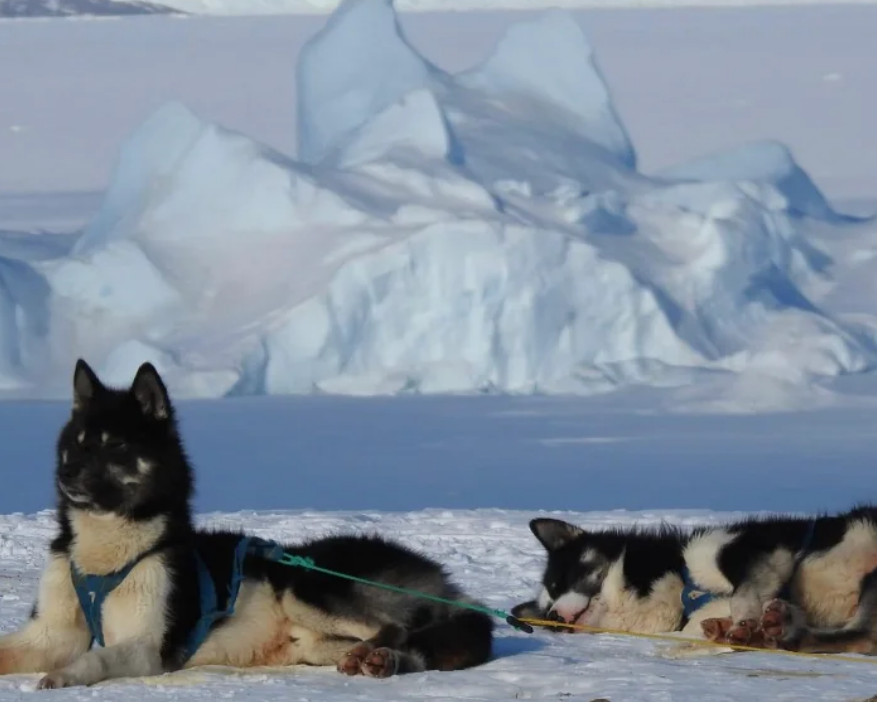
Meet The Greenlandic Dog By Wonderful Ilulissat in Ilulissat
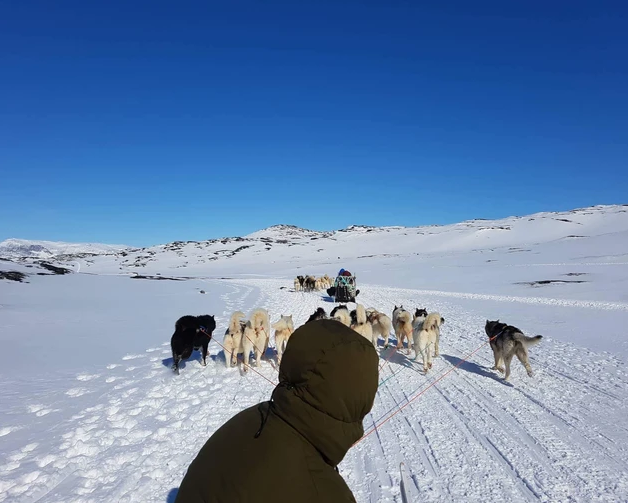
Dog Sledding to Kataattoq By Wonderful Ilulissat in Ilulissat
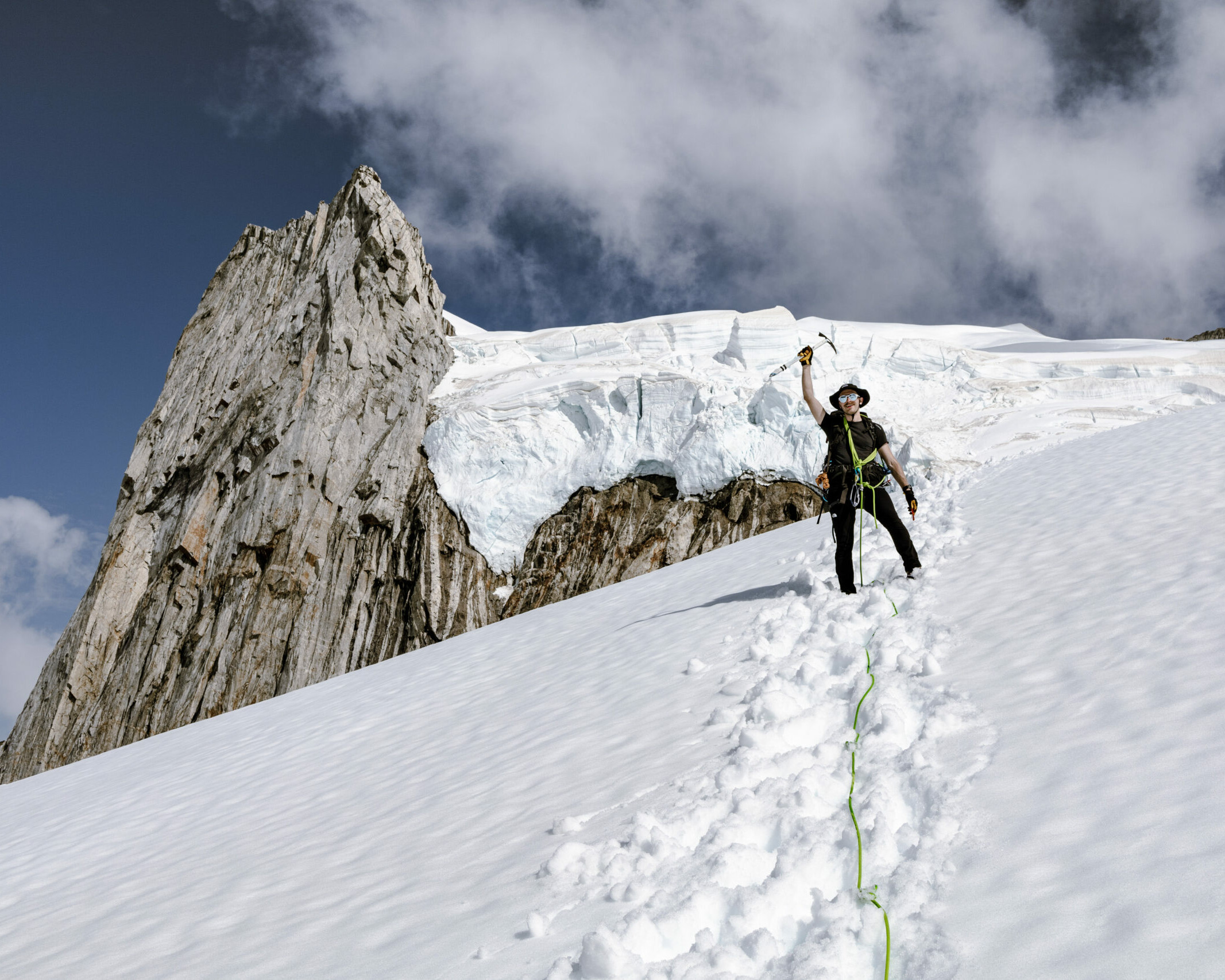
11 Day Mountaineering Expedition € 4,806.00 By Nunatak Adventures in Kulusuk
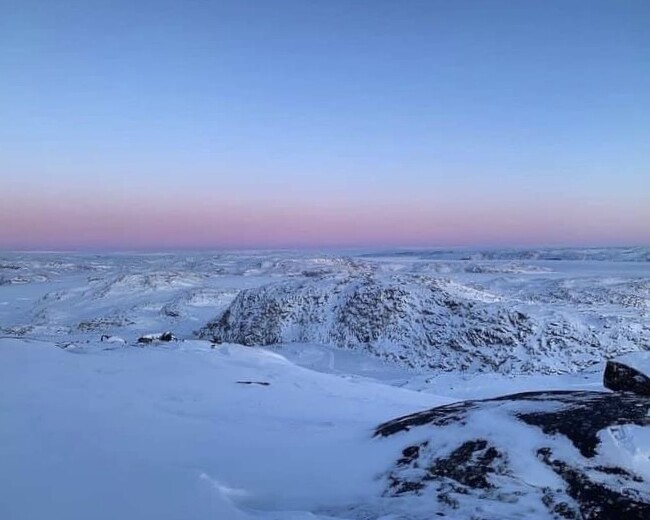
UNESCO Viewpoint on Snowmobile (2 Hours) By Unique Tours in Ilulissat
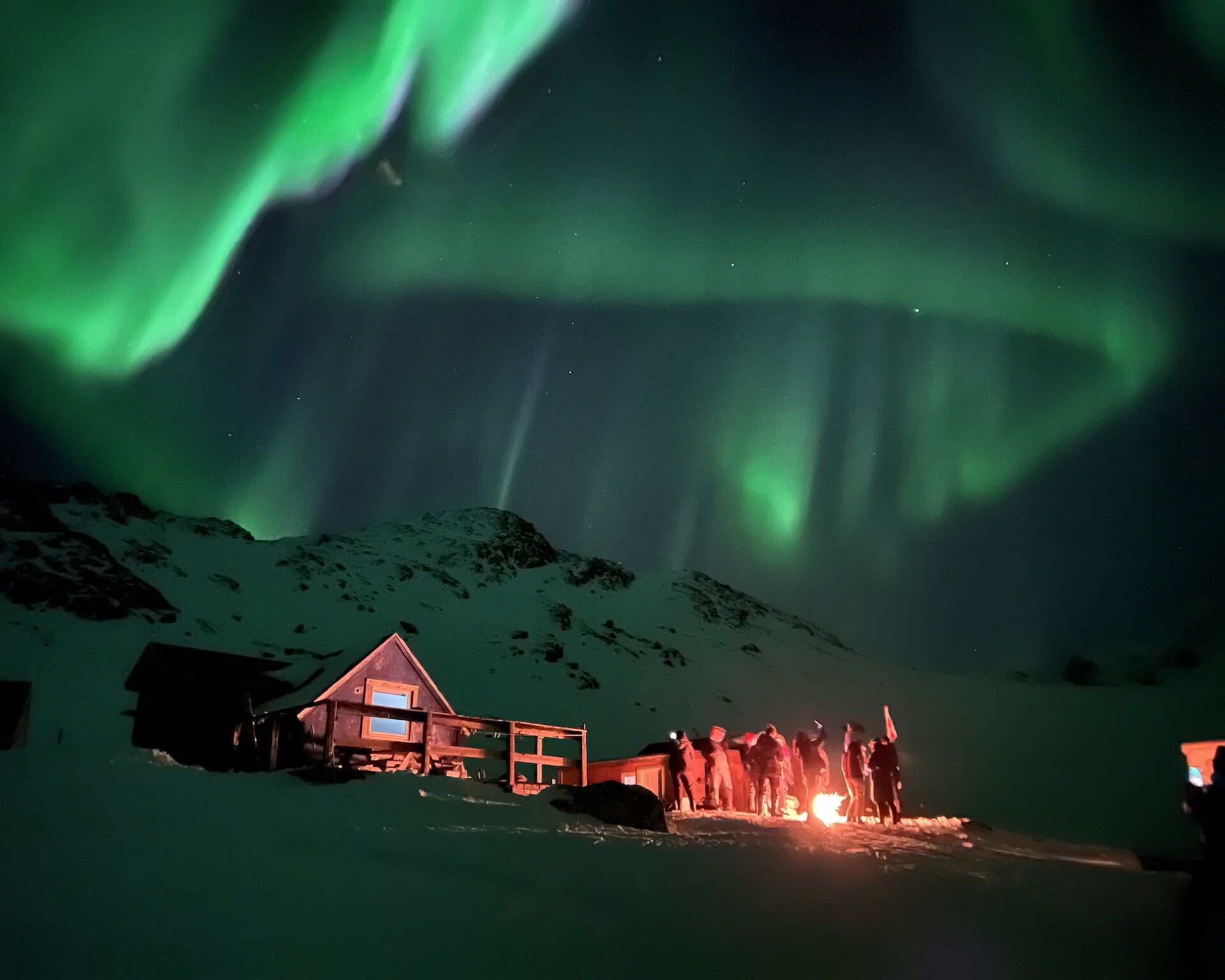
Northern Lights Tour By Kang Tourism in Nuuk
Privacy preference center, privacy preferences.

Harpseals.org supports the concept of these tours as healthy alternatives to the annual slaughter of the seals. However, we discourage people from taking these tours now for two main reasons:
1. Until the commercial killing of seals is banned, we encourage everyone to boycott tourism to Canada
2. These tours are run by sealers themselves. This is true even for the tours that are organized by a U.S. based company, as we will show in the correspondence below. The two companies that have been providing these tours over the years are Natural Habitat Adventures , the U.S. based company, and Travel Wild Expeditions, based in the Magdalen Islands, one of the two main regions from which sealers hail. The letter below, sent to to us by a Natural Habitat Adventures harp seal tourist named Yvonne (last name left out for privacy reasons), provides evidence of this company's use of sealers for their seal tours and of the callousness and brutality of these people who profit both from seal watching and seal killing. It also shows that Natural Habitat Adventures lied about their use of sealers to potential customers.
Natural Habitat Seal Tours Exposed
Below is the text of the email sent by yvonne to harpseals.org.
Interspersed throuought the text are links to emails between Yvonne and Natural Habitat Adventures and between her and another tourist.
"I've just returned from the Magdalen Islands on a Harp Seal tour. I am also an avid conservationist and animal activist and am grimly aware of the harp seal pup hunt in Canada.

While readying to leave the ice after one visit I asked Leo (the owner of the helicopter) straight out "Do you hunt Harp Seal white back pups?" Leo's response was "I hunt everything". I asked him again if he hunted the Harp Seal white back pups? He looked around at the other people on the tour in the helicopter and nodded "yes" to me with a big smile on his face.

On the third flight out, right after disembarking from the helicopter I witnessed Rieu (I believe that is the guide's name -tall, shaggy beard) walk up to a pup who was trying very hard to get away from him by desperately wiggling away and barking at him with his mouth open and head lifted towards him. The guide yanked the pup by the back flippers about 4 feet backwards and then jammed his fist straight armed into the pup's back to make it hold still for the party of non NATHAB travelers he was with.
Leo was with me and another NatHab traveler on the pan this day as a guide - and as we approached a pup, Leo said to me in a VERY condescending manner and smirk on his face, “Do you think I would hurt these little guys?” I felt as though he was trying to see just how stupid I was.

When we lifted off the pan Leo took the helicopter further out instead of coming back to land and while looking through his binoculars told us that he had finally found the second herd. (I don’t believe for one second that finding the second herd was so that he could bring tourists to them.)
After we finally turned towards land we flew directly over a kill pan. I saw huge amounts of blood and a white row boat. Leo flew us right over it! I leaned over to my fellow traveler and told her I saw a hunter’s white row boat, but she couldn't have a conversation with me over the engine noise.
Upon landing, our NatHab representative met me to ask about the trip and I told her about Leo's comments and the fact that I had witnessed a kill pan. She got very upset and told me that she was going to speak with our van bus driver for the tour. That person came to my room and asked me what I had seen. I told her about the kill pan and I also told her about the comments Leo had made to which she responded in shock, "Leo actually said that to you?" She immediately got on the phone to the Fisheries and Oceans Protection department and they immediately sent out a patrol to the coast trying to catch the row boat coming ashore, but to my great disappointment they did not catch the illegal hunter. She told me not to mention anything to anyone, which I abided by. I completely understand why she asked me for my silence... I'm sure there would be those who might want to warn those who were hunting white coat seal pups illegally.

"I also want to say that the Harp Seal hunt was the giant elephant in the room for the whole trip. Those I spoke with in the group confirmed that no one on the Maggie's ever asked us "What did you see today? Are you enjoying your trip?".... nothing that would engage us in conversation about why we were there. It was very apparent to me that the Harp Seal pups are seen as a commodity… money to be made… an object, and not as a living part of Mother Nature.
I wanted to write to you for several reasons:
1) I am physically sick that even a penny of my money went towards any benefit of the owners/guides and pilots of the helicopters that were used on my trip.
2) I am compelled to inform you of my experience while on the NatHab tour. It is my duty as an advocate of the Harp Seals to inform you. What you do with the information is up to you.
3) The NatHab representative and van driver were EXTREMELY supportive of my concerns and I felt they did everything they could to inform the authorities on my behalf.

I am extremely angry at the helicopter teams because they used our tours to scout the pans to figure out where they could kill the most pups and not for our benefit, as “former” hunters. By going on this tour, I feel dirty - because I paid to hire them and actually assisted them in finding their prey, which happens to be the animal I love so very much.
I contacted the owner of Natural Habitat Adventures, Ben Bressler, with the content of this letter and more, to which he responded that he is fully aware that the team they use to fly out to the pans are not necessarily committed to stopping the seal hunt, as they had told me before." Here is that e-mail correspondence between Yvonne and Ben Bressler, owner of Natural Habitat Adventures - AFTER her experience on the ice with the seals... "And although he was upset about my experience, he was not going to stop the tours. (Which I didn’t expect; what I am disappointed in is that they appear to be willing to continue to use the helicopter team they currently use knowing that they actively illegally hunt white back pups, or at the very least seem to be obvious spotters for the commercial hunters, or hunters themselves.)
5) Lastly, I wanted to tell you about my experience in the name of awareness. Your agency might not be able to “do” anything, but at least I’ve shared with you my experience in the hopes that it might anger someone into action as it has with me. As with NatHab, all I can do is share this with you…what you do with it is up to you." Sincerely, Yvonne

- Vacation Packages
- Tour Planner
- Northern Lights
- Iceberg & Icefjord
- Whale Watching
- Airplane & Helicopter
- Glacier & Icecap
- Kayak & SUP
- How to get to Greenland
- From the US
- From Iceland
- From Denmark
- Kangerlussuaq
- Explore Greenland
- Travel Blogs
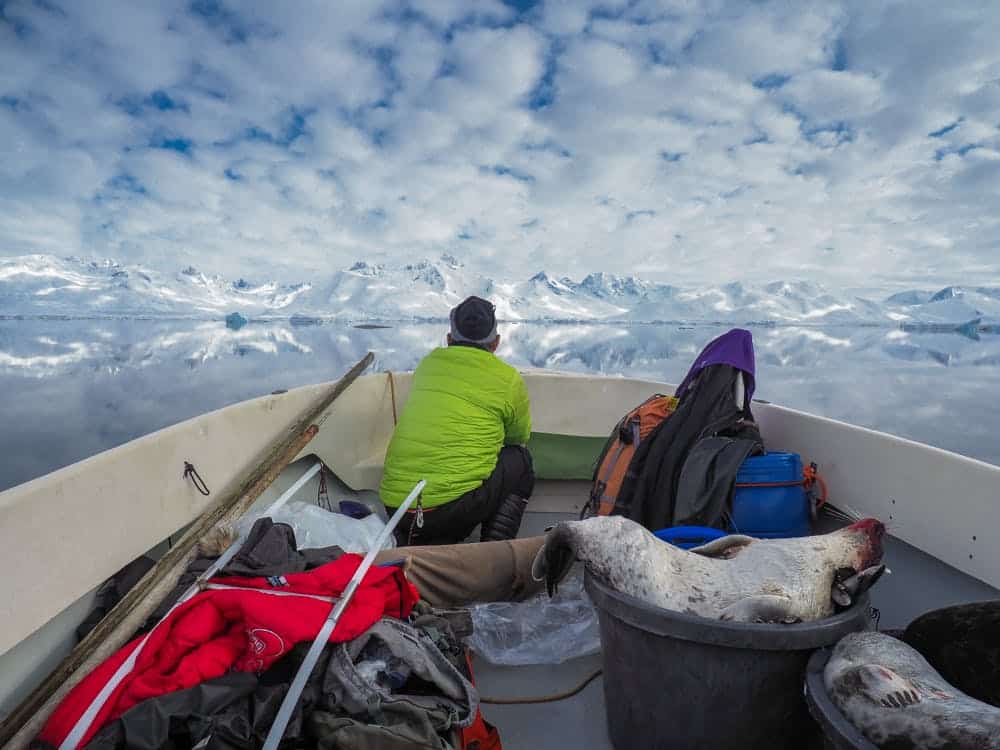
Seal Hunting One Brilliant Day in Sermilik Fjord, East Greenland
Published: 16/06/2020
Reading time: 3 minutes
Qertaulangiuaq, high up Sermilik Fjord, is a favorite place for Diilerilaaq hunters to hunt seals.
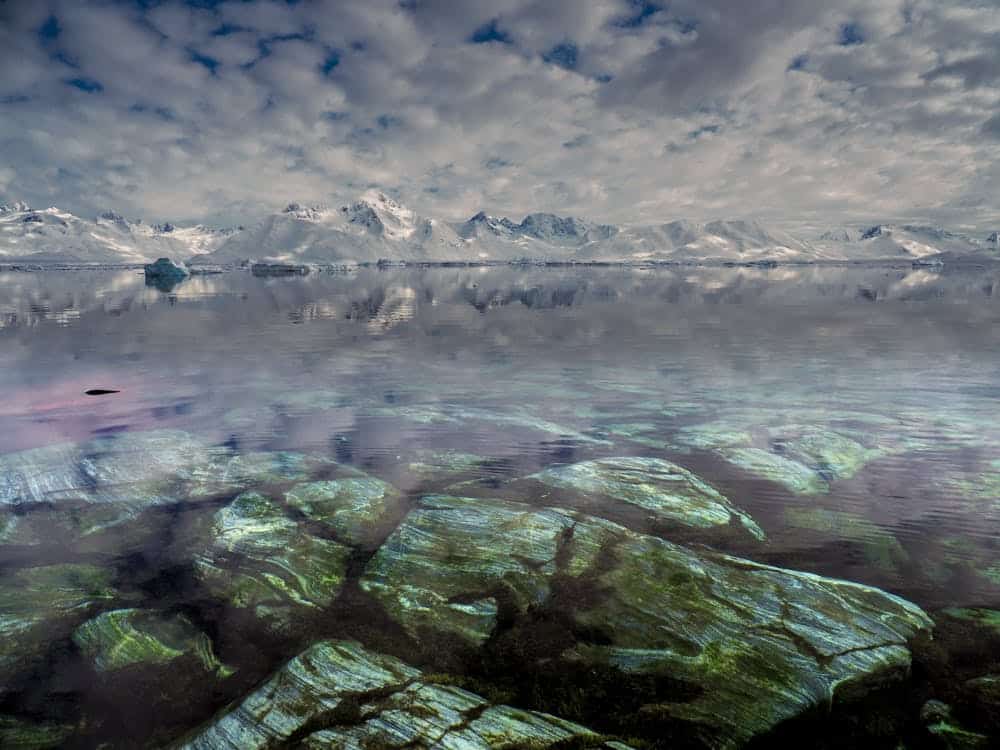
One day last mid-April, three of us – two hunters and myself, a visiting photographer – boated up the fjord to Qertaulangiuaq. There, in heavy fog, we hunted from icebergs and fast ice. The air was so thick with ice, it was hard to tell the sea from the sky.
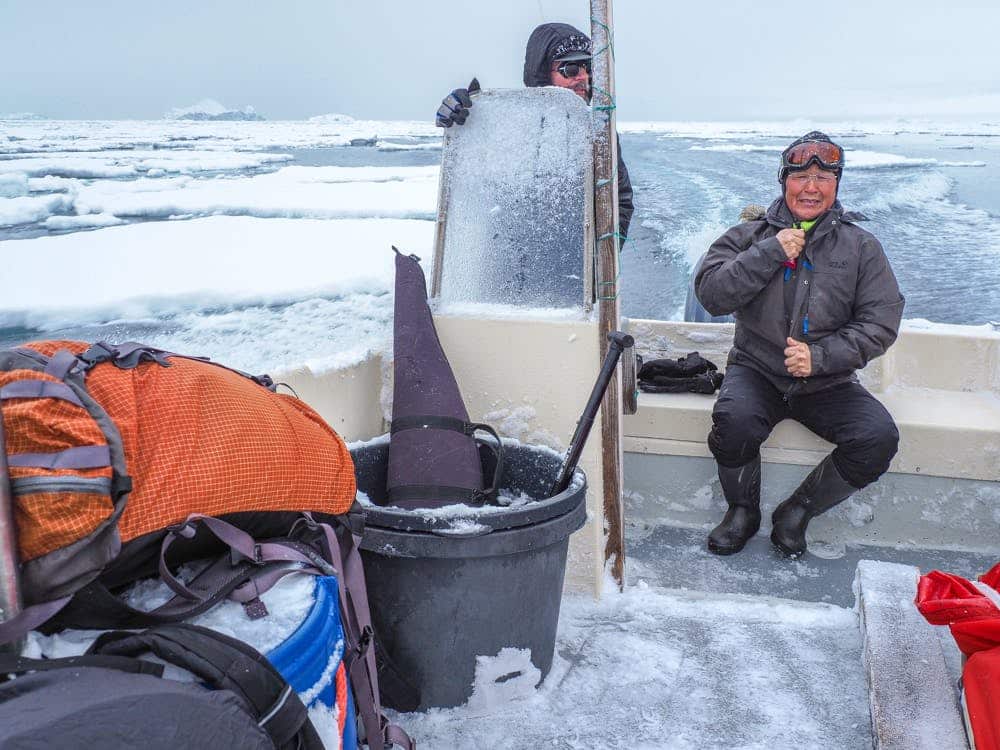
Gert, our “seal whisperer” clucked and mewed, and scraped his gaff against the ice edge. In response, seals would pop their heads above water and swim towards the hunters.

The seals eventually grew wise to Gert’s game and retreated to the safety of the sea. The hunters then turned the sights inland. Max donned camouflage and carefully picked his way across the fast ice towards seals basking near the shore.

Success! Three fat, ringed seals.
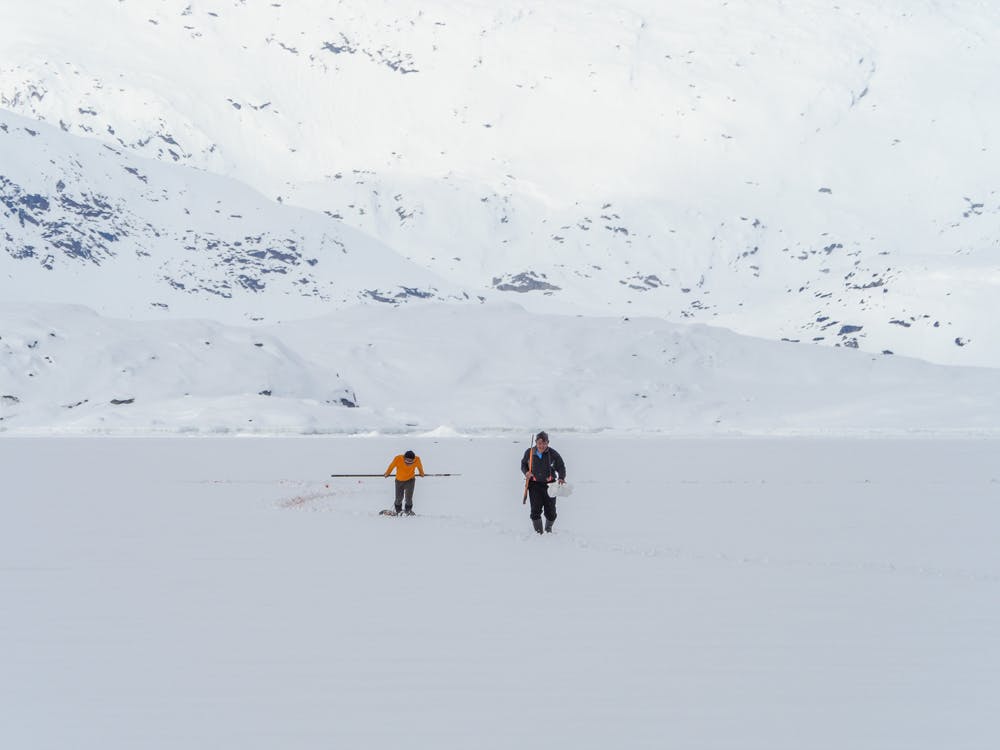
By mid-afternoon, the fog started to lift and the sun broke out. Ice-capped mountains split cloud-mottled seas and skies along a shimmering horizon. With a clear line of sight, hunting became spectacular. Seal bodies bobbed about the water in bloody pools, near the glowing ice edge. As we boated into the bay to collect them a rib of moss-green, bedrock gneiss rose under our bow.

Do hunters, I wonder, see sublimity as well as its seals?
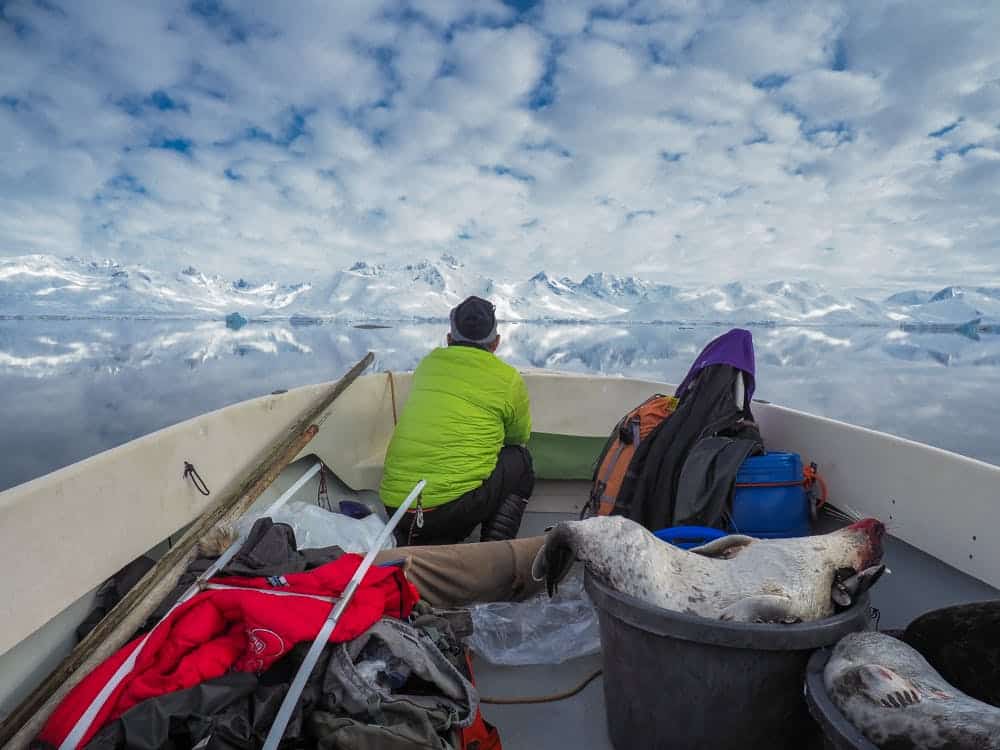
Read more travel blogs from Dianne Chisholm

Winter In Ilulissat | 5 Days | Disko Bay

Experience traditional Inuit drum dancing | Tasiilaq | East Greenland

Deep Sea Fishing | Private Charter | Qasigiannguit | Disko Bay

Hot Spring Uunartoq by Helicopter | Qaqortoq | South Greenland

8 Days of Spring In The Arctic | West Greenland & Disko Bay

2 Day Hiking and Kayaking Adventure | Ilulissat | Disko Bay

Summer vacation under the midnight sun | Qaanaaq | North Greenland

Qarajaq Glacier | Private tour | Uummannaq | North Greenland
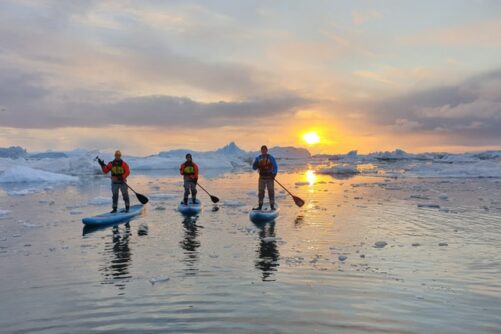
SUP amongst Icebergs originated from UNESCO World Heritage Site | Ilulissat

Ukkusissat Mountain Hike | Nuuk

Kapisillit Settlement Visit | Nuuk
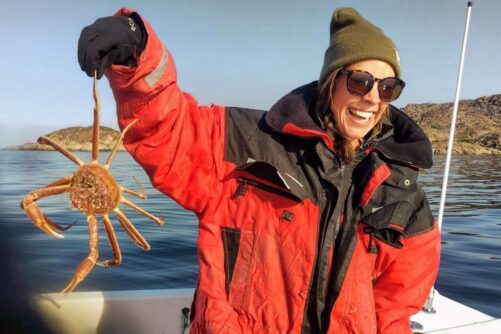
Cod Fishing & Snow Crabs | Sisimiut

Scenic Flight | Nuuk

Two-Day Dog Sled Adventure | Kangerlussuaq

Private Glacier and Settlement Tour | Uummannaq | North Greenland

Pay by the Hour Private Charter | Ilulissat | Disko Bay

Best of winter in Greenland | 5 Days in Sisimiut, West Greenland

Ice climbing & Ice Cave Tour | East Greenland

From the Ice Cap to Unesco Heritage – 9 days | Kangerlussuaq | West Greenland

Ice Fishing | Kangerlussuaq | West Greenland

Abandoned settlement visit | Private Charter | Qasigiannguit | Disko Bay

Nature Adventure | South Greenland

Dog sledding expedition | Kangerlussuaq to Sisimiut | West Greenland

Sailing to Tiniteqilaaq and the Sermilik Icefjord | Tasiilaq | East Greenland

Uummannaq 360°| North Greenland

Northern Lights Photo Tour | Nuuk

Expedition South Greenland by Helicopter | Qaqortoq | South Greenland

Whale Watching and Iceberg Safari | Tasiilaq | East Greenland

Glacier Cruise | Uummannaq | North Greenland

Captains Favorite Strait Cruise Sullorsuaq | Private tour | Ilulissat | Disko Bay

Midnight Cruise To Ilulissat Icefjord | Ilulissat | Disko Bay

Daytour to Eqi Glacier | Ilulissat | Disko Bay

Biking, hiking & kayaking | South Greenland
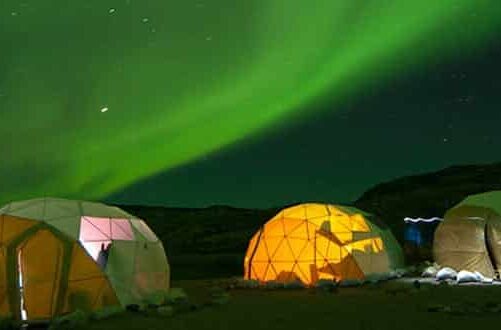
Northern Lights Explorer | South Greenland

Musk Ox, Reindeer & Ice Cap Tour | Kangerlussuaq

Uummannaq Island from the sea | North Greenland

Private Whale Safari | Ilulissat | Disko Bay

City tour and hike to the flower valley | Tasiilaq | East Greenland

Russell Glacier BBQ | Kangerlussuaq | West Greenland

Chasing the Northern Lights | Ilulissat | Disko Bay

Private Full Day Adventure | Uummannaq | North Greenland

Heart of Greenland | The Capital Nuuk

Sea Fishing | Private tour | Ilulissat | Disko Bay

Whale Safari | Ilulissat | Disko Bay
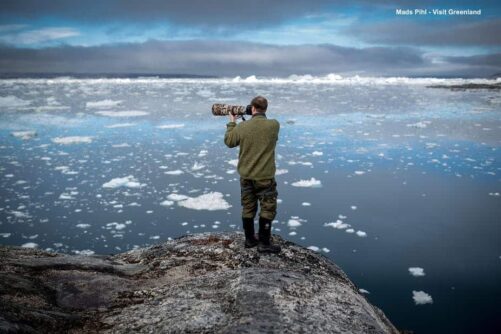
East Greenland Photo Exploration | Tasiilaq

Whale Safari | Maniitsoq | West Greenland

Morning Kayak among Icebergs | Ilulissat | Disko Bay
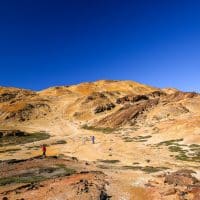
Private Arctic Desert Experience | Uummannaq | North Greenland

Closed boat Fjord Adventure | Nuuk
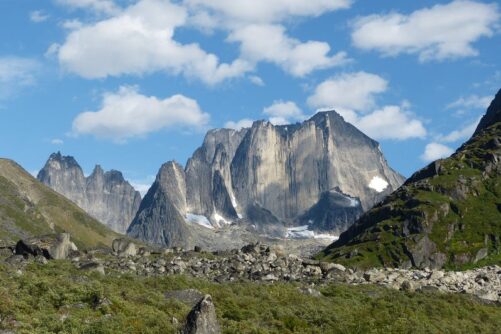
Ice, Big Walls & Hot Spring | South Greenland Explorer

Ilulissat Citywalk | Ilulissat | Disko Bay
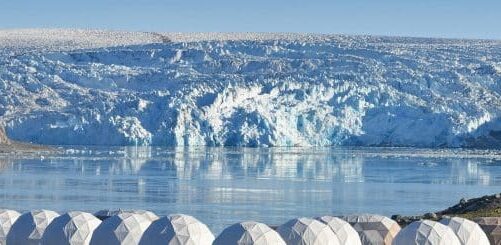
Wonders of Greenland | South Greenland

Paradise Valley & Ice Cap Tour | Kangerlussuaq

Inuit Hike | Sisimiut | West Greenland

Tundra And Wildlife Tour | Kangerlussuaq | West Greenland

Puffin Safari | Nuuk

Winter Safari | Sisimiut

Sightseeing In Kangerlussuaq | West Greenland

Hike and Kayaking | South Greenland

Whale Watching | Uummannaq | North Greenland

East Greenland Adventure | 6 Days

Highlights of South Greenland | 8 Days
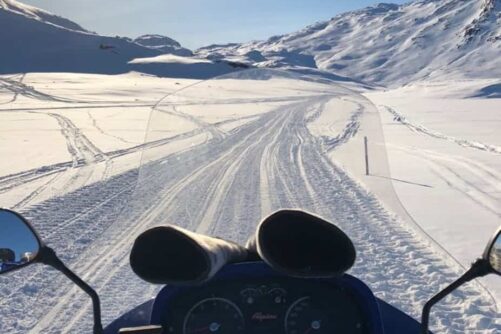
Snowmobile tour to UNESCO viewpoint | Ilulissat
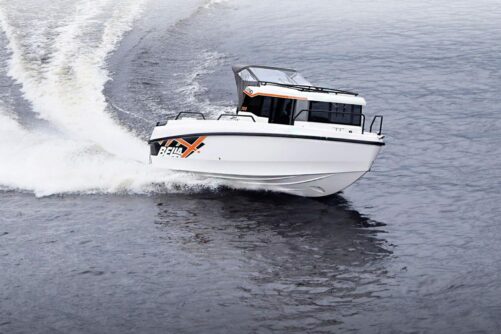
Midnight Sun Cruise | Maniitsoq | West Greenland

The Ilulissat Experience | 5 Days | Disko Bay

Northern Lights Tour | Kangerlussuaq | West Greenland

Half-day snowshoe hike in Nuuk Fjord | West Greenland

Sea Safari | Sisimiut | North Greenland

Overnight snowshoe adventure | Nuuk

Arctic Nights Photography Workshop | Ilulissat | Disko Bay
Helicopter and ice cave tour | east greenland.

Helicopter Summit Flight | Nuuk

Northern Lights Private Boat Tour | Nuuk

5-Days Above The Arctic Circle | Sisimiut | West Greenland

Explore the Cultural site of Qilakitsoq | Private tour | Uummannaq | North Greenland

Chasing Northern Lights At Sea | Nuuk

Private Whale Safari | Uummannaq | North Greenland

10 days of hiking through Arctic nature & villages | East Greenland

Sail With The Whales | Ilulissat | Disko Bay

Stand Up Paddleboarding amongst the Icebergs | Nuuk | West Greenland

Narsarsuaq & Igaliku 5 days Package | South Greenland

Ghost Village Boat Cruise | Sisimiut | West Greenland
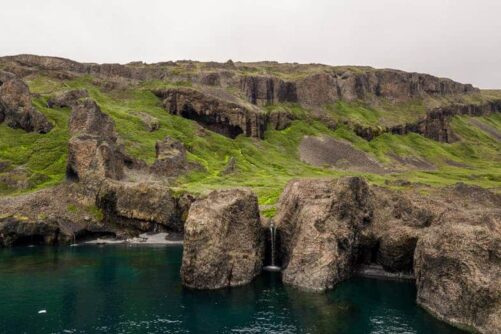
Kuannit Hike | Qeqertarsuaq | Disko Bay

Nuuk Icefjord | Nuuk
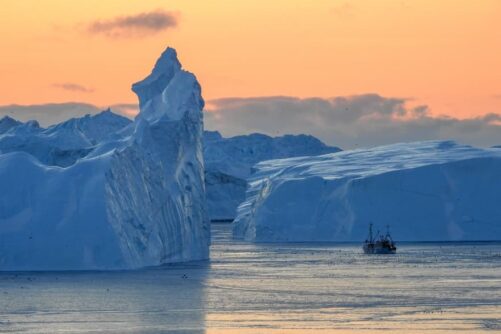
Best Of Ilulissat | 5 days | Disko Bay

8-day Iceberg Horse Riding Tour | South Greenland

My trip to Ittoqqortoormiit

Eqi – Ilulissat
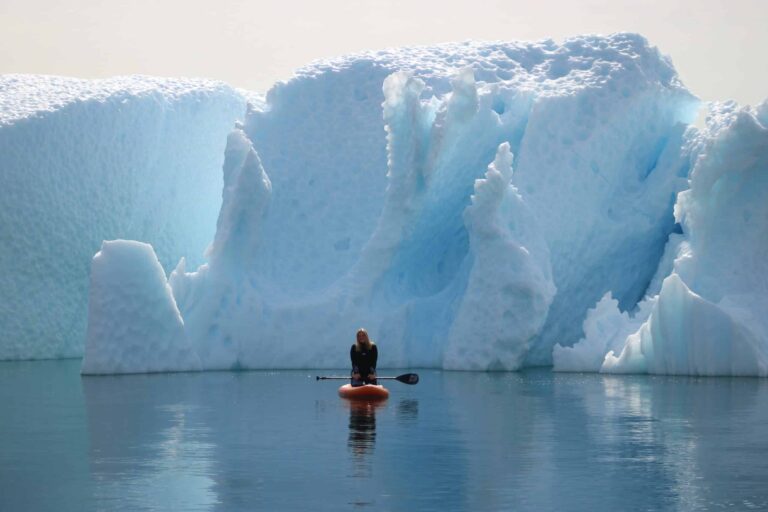
Water sports in Greenland

Seal Watching in Iceland

The Icelandic Seal Centre
Seals and icelandic folklore, interactions with seals in the modern era, responsible seal watching, the future of seals in iceland.

Iceland is home to numerous seal colonies who can be easily spotted in many breathtaking locations around the country. Read more to find out everything you need to know about seals and seal watching in Iceland.
Photo above by Jane Yeo
- Learn all you need to know about Wildlife and Animals in Iceland
- Read about Whale Watching in Iceland
At the Jökulsárlón glacial lagoon, visitors marvel at massive icebergs, breaking from the tongue of a glacier and slowly making their way across a tranquil water's surface to the ocean.
It is a site of immeasurable beauty, drawing people from the world over, but for the local seals, it is home. Frolicking between the ice flows, riding in the surf along the Diamond Beach , or hauled out on the bergs, the pinnipeds make what is already a magical experience that much more charming.
Top Nature Tours in Iceland
Best ice cave tour in vatnajokull glacier starting from jokulsarlon glacier lagoon, inside the volcano thrihnukagigur tour with transfer from reykjavik, small group tour of snaefellsnes national park with transfer from reykjavik.
While the glacier lagoon is an incredible seal-watching spot, it is by no means Iceland’s only, nor its best. With its rugged coastline, remote fjords and a wealth of beaches, Iceland offers some of the most readily available and rewarding seal-watching locations in the world.
Taking part in any coastal activity in Iceland provides a good chance of seeing these beautiful animals. On a best value kayaking tour in a fjord just outside Reykjavík, you might see them poking curiously around your boat, and scuba divers in the Westfjords can spot them gliding gracefully through the waters. Those eager for a great seal-watching experience from shore, however, need to look no further than the Vatnsnes peninsula in North Iceland .
Three locations, Svalbarðshreppur , Illugastaðir and Hvítserkur , are reliable for seeing seals year-round, ‘hauling out’ for hours a day as a way to regulate their body temperature after hunting in the icy waters of the North Atlantic. Harbour seals are the most common and the least wary of visitors, although grey seals , the only other species to pup on the island, are not at all uncommon.
Lucky travellers with a keen eye may even spot rogue visitors to Iceland. Harp seals , bearded seals , hooded seals and ringed seals , who usually reside in the Arctic, have all been spotted in local waters and on the shores. Very rarely, walruses are also seen; in fact, in the year 2013 alone, there were more recorded walrus sightings than there were in the early 18th Century. With rising temperatures and melting ice, it is only reasonable to expect more in the future.
- See also: Jokulsarlon Glacier Lagoon - See the Crown Jewel of Iceland's Nature
The growing interest in seal research and watching led to the establishment of the Icelandic Seal Centre back in 2006, which is located just on the Vatnsnes peninsula in a quaint fishing town called Hvammstangi. Almost 40,000 people visited the centre in 2016, and over 10,000 explored its exhibits. As of January 2017, the Centre is looking to at least double that record.
Within the building, one can learn about the species native to Iceland and the Arctic. Seal skeletons are on show with information on their anatomy, and there is a wealth of information on seals in Icelandic tradition, both within fables and within hunting traditions.
For those eager to learn more about these creatures or sharpen their skills regarding seal-watching, it is an essential stop on any tour of North Iceland . You can even choose from some great accommodations in Hvammstangi if you want to make the most of your visit.
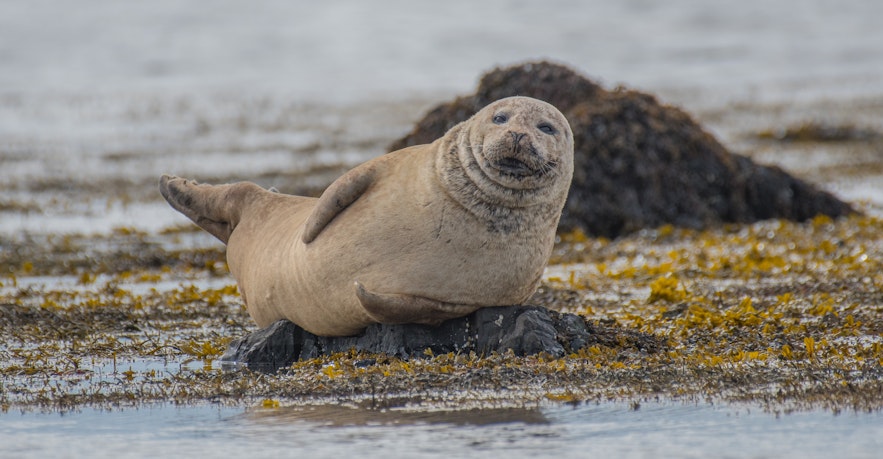
While its exhibitions exist to inform and entertain, the Icelandic Seal Centre is also a vital research institution. Seals are still culled in Iceland to protect the fisheries, as it is believed that those that rest along estuaries are damaging to salmon populations. One aim of the Seal Centre is to determine whether this impact is enough to justify the cull and whether it is, in fact, more damaging to the ecosystem and economy to continue the tradition.
They also research the impact of tourism on seal populations, monitoring those on beaches accessible to visitors, and those where humans are not allowed to step; the results of this research are helping to build a sustainable and ethical seal-watching industry in the country.
Perhaps the most exciting of their endeavours, however, is the annual Seal Census. Alternating each year between July and August, the centre rallies a large group of volunteers - for which anyone can apply - to scour 80km of coast in the local area to determine how the population is changing and what factors are causing such changes.
Top Boat Tours
Before Iceland’s industrial development, pinniped conservation was naturally low on the peoples’ agenda. In a nation with dark, long winters and little wood to burn, seal blubber provided invaluable fuel. Their fur could ward off brutally cold conditions, and their meat was plentiful enough to feed a family for weeks. Up to the 20th Century, therefore, their populations were in steady decline. That is not to say, however, that the intelligence and charm of seals was overlooked by native Icelanders.
There is a fable called ‘the Seal’s skin’ that has endured for centuries in Iceland. It is said that a fisherman discovered a cave with luxurious seal-skins at its mouth; out of sight, in the cave’s depths, he could hear dancing and singing, so he secretly stole one of the skins and locked it in a chest in his house.
On returning to the cave, however, he discovered a beautiful woman weeping. He clothed her and took her home, and though ever distant, and silent around others, she fell in love with him. The two married and had seven children, but the man never told her of the contents of his chest, always keeping the key in the pocket of his everyday clothes.
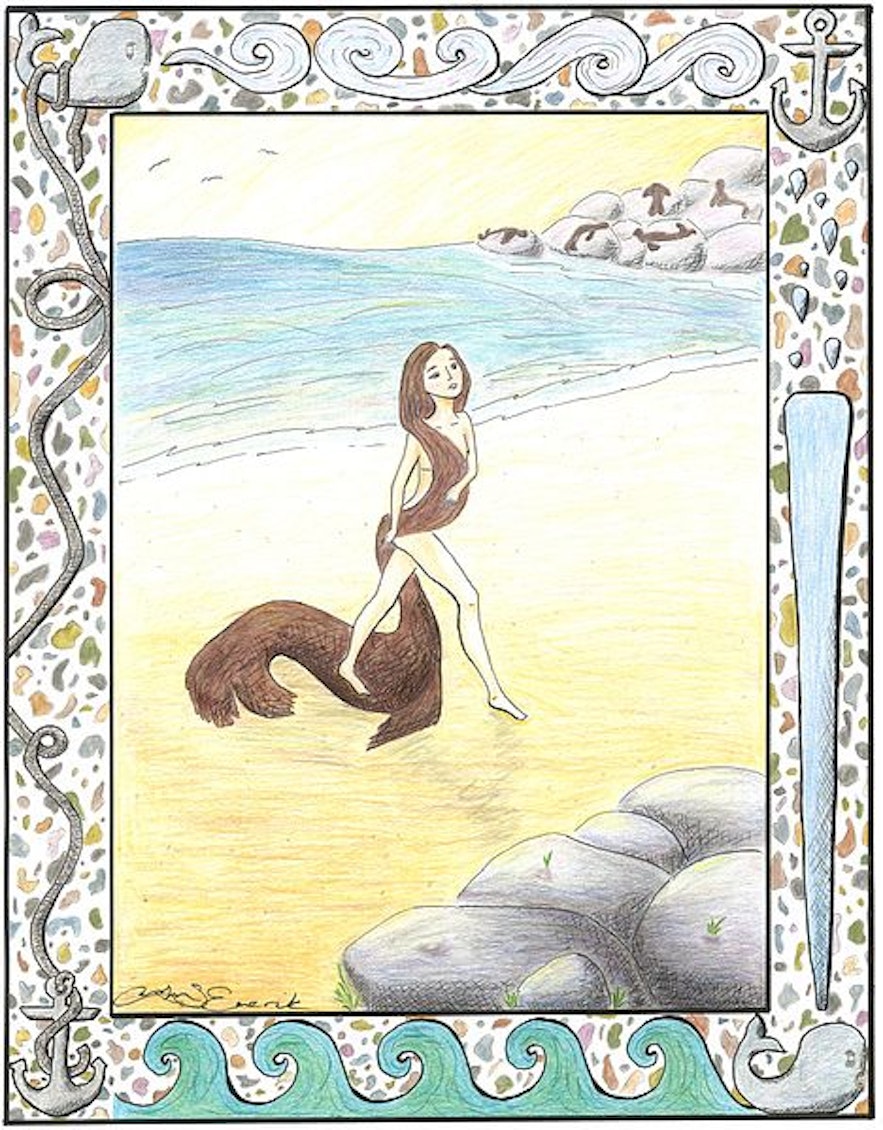
One Christmas, however, his wife was too sick to join him to a party, and when he walked off in his fineries, he left the key behind. The day he returned, she was nowhere to be found, and he discovered the chest open and the seal skin gone.
He never saw her again, but whenever he went fishing in the ocean, would find a lone seal, whose eyes always seemed to be running tears, circling his boat and driving fish into his net.
Their children also lost their mother that day, but whenever they walked along the seashore, would see the same creature swimming alongside them, tossing them pretty shells. Their last memory of her were the words that she whispered to them before disappearing; ‘Where have I to flee? I have seven kids on land, and seven pups in the sea’.
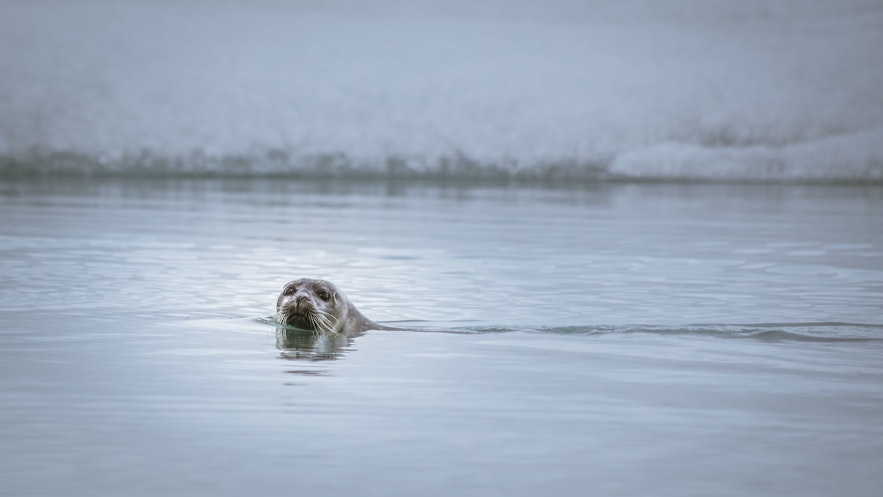
This tale of the skin-shedding seal, known as the Selkie, is not actually exclusive to Iceland. In the Faroe Islands, the same story exists, but most variations have it that the farmer sought out his wife after she left him, and killed her with her seal-husband.
Scottish and Irish folklore also have Selkies but represent them as beautiful and predatory rather than beautiful and forlorn. It is thus perhaps telling that Icelanders have always had a strange appreciation for the charm and beauty of seals, in spite of the fact that they were hunted to survive.
- See also: Folklore in Iceland
As the country urbanised in the 20th Century, the hunting of seals became less necessary for survival and dropped. Before large populations could return, however, the 1960s brought back a trend amongst the wealthy for seal fur coats, which had not been so popular since the turn of the century.
Throughout the decade, around 6,000 a year were killed for the fashion industry. The conservationist movement of the 1970s brought this practice into sharp decline, but as of 1982, it was government policy to have ‘bounty’ on seals so that they would have less of an impact on fisheries. Nowadays, a few hundred are killed a year.
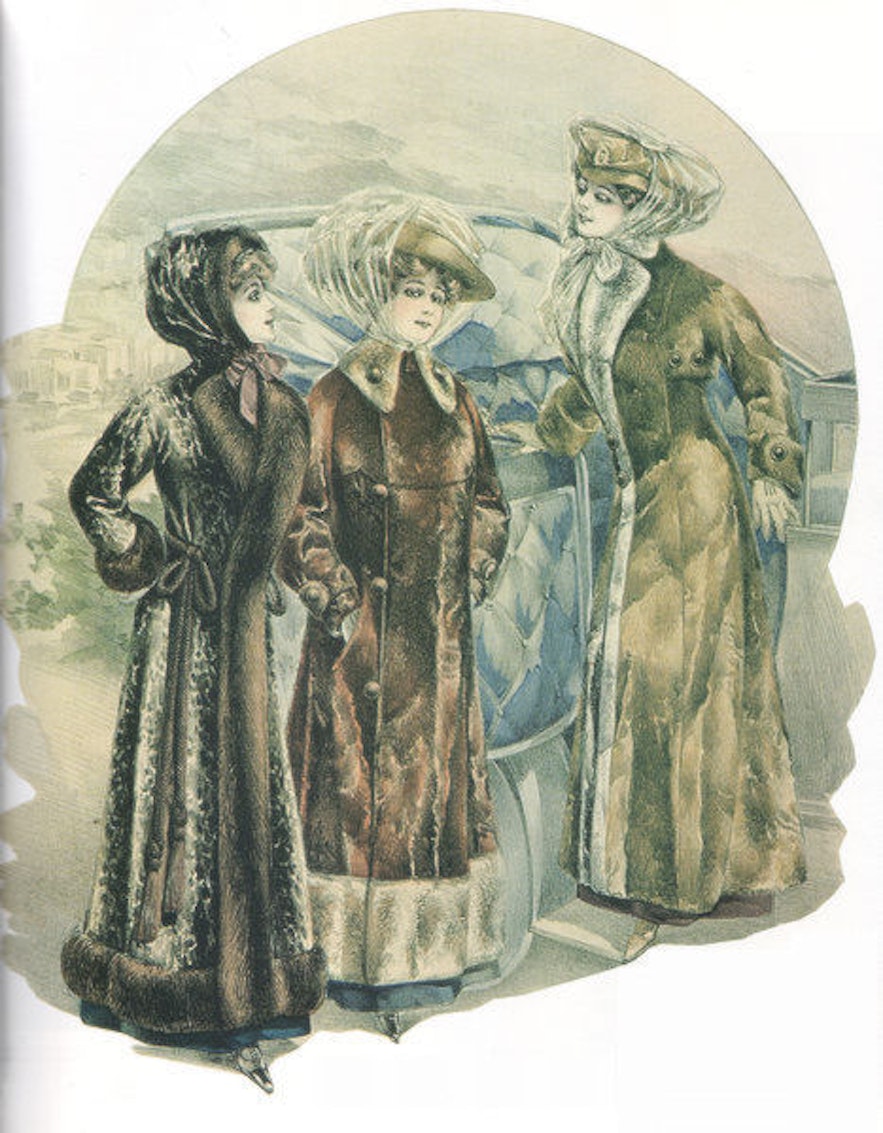
Aside from their habit of snapping up salmon as they swim upriver, seals are carriers of a ringworm that can be passed onto fish. Grey seals also have a habit of biting fish through nets to get at their livers, spoiling the catch and damaging equipment. Therefore, debate regarding how to marry conservation with Iceland’s second largest industry is ongoing in the country.
On the one hand, many argue that the seals are by no means endangered, and local hunting is no threat to the populations. While true, the Icelandic Seal Centre’s research has shown that the overall population is nowhere near as large as it once was, and is in fact shrinking . When compared to seal and sea lion colonies on the nearby Arctic ice and in other parts of the world, Iceland’s pupping and moulting grounds are small and very sparse.
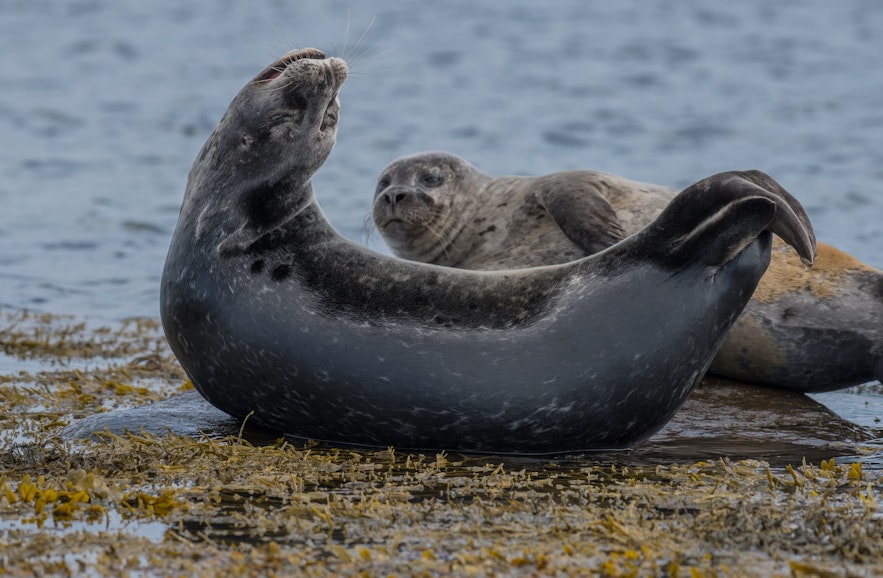
While more urbanised Icelanders hold less stock in old traditions that may challenge modern international values, some coastal landowners claim that seal hunting is part of their heritage. Many argue that the sale of seal products, which remains legal in Iceland, is vital to their income.
The novelty of buying seal fur has an allure to some visitors, and as tourism has increased, there is some speculation that small-scale seal hunting is increasingly lucrative, and growing accordingly. Arguably similar to whaling, what was once a national tradition, needed for survival, may be thriving today due to foreign curiosity above local needs.
Visitors who seek to appreciate these creatures alive and in their natural habitat, therefore, should be careful of the products they are buying, lest they unintentionally lend their money to a side of the debate they do not agree with. If Iceland’s seal-watching can develop into an international attraction and a more significant part of Iceland’s booming tourism industry, then it is very likely that conservation will be better for the local economy than exploitation, and a change in values will follow.
- See also: History of Iceland
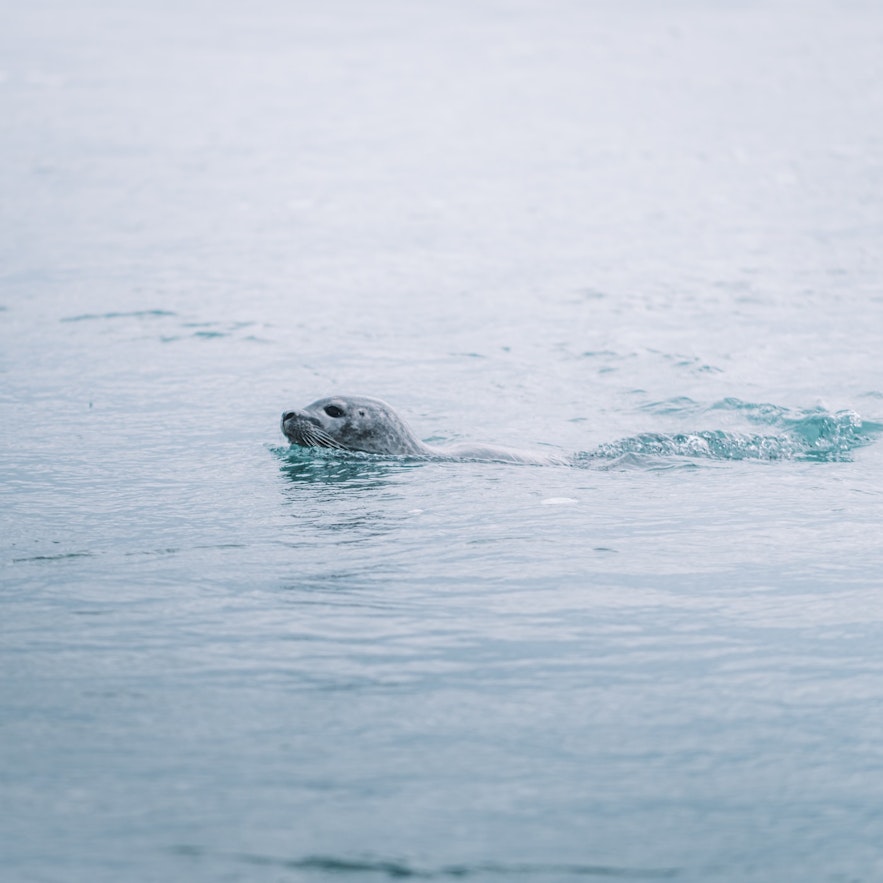
There are many ways visitors can enjoy the seals without causing them stress or harm. When visiting a hauling ground by foot, slow movements and quiet voices are essential. A reasonable distance should be maintained, especially during the pupping season when mothers are likely to be more defensive; this occurs in the summer months for harbour seals and the late autumn for grey seals.
It is not unusual to be approached by the naturally inquisitive harbour seal, and even though this is rarely a sign of aggression, visitors are encouraged to move away from them for the safety of both.
Under no circumstances should they be touched; doing so can pass infections both ways. Feeding the animals is also strictly forbidden; seals that become reliant on human handouts will lose essential survival skills, venture into human areas that may be a danger to them, and may even develop unnaturally violent behaviour in search of an easy meal.
Photographing them is encouraged, as a wider circulation of images of these creatures in their beautiful natural habitat will help the seal-watching industry grow; just be careful not to use the flash as it may bother them. As a final note, bringing a dog to a hauling or pupping ground puts both animals in danger, and is strongly discouraged.

When watching seals from a boat, there are a few additional guidelines. Boats should move slowly, with the engine as quiet as possible, so not to be a disturbance. Whoever is steering should try not to separate any individuals in the water from the group they are with, as it may be seen as an aggressive action.
If seals on the beach are paying significant attention to the boat, it may be due to a wariness of the propellers, and they may avoid entering the water to escape injury. In such a case, the boat should be slowly moved away. Of course, regardless of whether or not there are seals, nothing should be thrown overboard.
Seals can be spotted anywhere along the Icelandic coast, at any time during the year; as noted, however, searching the Vatnsnes peninsula is likely to warrant the best results. The optimal viewing time to catch them on the shore is within two hours of low tide .
Like basically every animal on earth, human activities and a rapidly changing climate mean the future of seals is uncertain worldwide. It is heartwarming to see, however, a concerted effort amongst Icelanders and visitors alike to celebrate and protect these creatures on this little island. Seals have been here for longer than any humans, and deserve the opportunity to thrive on the beaches they have always called home.
Seal-watching is an ever-growing industry, and with the help of the Icelandic Seal Centre, is becoming both safer for the pinnipeds and more enjoyable for people. If it can boom further, then it will put to bed old survivalist traditions, and enshrine these amazing animals as part of Iceland’s national identity. There are few other places in the world where you can see these beautiful creatures within such incredible settings, so visitors to Iceland should really make the most of the opportunities to coexist with them peacefully.
Top Whale Watching & Puffin Tours
Popular articles.

Guide to Iceland | The Story of the Leading Travel Agency of Iceland

The Complete Guide to the Midnight Sun in Iceland

Top 20 Most Beautiful Waterfalls in Iceland

22 Photos of the Aurora in Iceland

Mountains in Iceland
Other interesting articles.
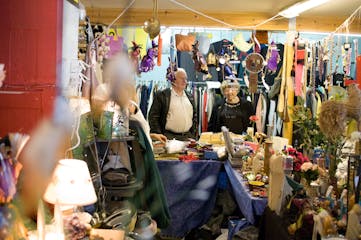
Top 9 Things to Do During Bad Weather in Iceland
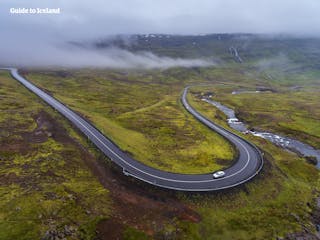
The Ultimate Guide to Transportion in Iceland

Ultimate Guide to River Rafting in Iceland

Download Iceland’s biggest travel marketplace to your phone to manage your entire trip in one place
Scan this QR code with your phone camera and press the link that appears to add Iceland’s biggest travel marketplace into your pocket. Enter your phone number or email address to receive an SMS or email with the download link.
Top things to do in Iceland
Book your complete trip with the best companies only

Explore an Ice Cave

Visit a Live Volcano

Find the Northern Lights

Visit the Blue Lagoon

Go on a Road Trip

Do the Golden Circle

See the Glacier Lagoon

South Coast Tours
About the Canadian seal hunt
Responsible for the deaths of hundreds of thousands of baby seals each year
Canada's annual commercial seal hunt is the largest slaughter of marine mammals on the planet. Facing harsh criticism the world over because of the hunt's cruelty and unsustainability, the Canadian government and fishing industry have spread much misinformation. Here are the basic facts about the hunt.

1. Which seals are targeted by Canada's seal hunt?
Harp seals are the primary target of the commercial seal hunt, and to a much smaller extent, hooded seals are also killed. Fully 97 % of the harp seals killed are pups under just three months of age.
2. Where are the seals killed?
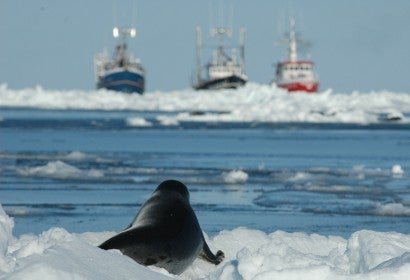
Canada's commercial seal hunt occurs on the ice floes off Canada's East Coast in two areas: the Gulf of St. Lawrence (west of Newfoundland and east of the Magdalen Islands) and the "Front" (northeast of Newfoundland).
3. Who kills seals and why?
Sealing is an off-season activity conducted by fishermen from Canada's East Coast. They make, on average, a small fraction of their annual incomes from sealing—and the rest from commercial fisheries. Even in Newfoundland, where most sealers live, the government estimates there are less than 6,000 fishermen who actively participate in the seal hunt each year—less than one % of the provincial population.
4. How are the seals killed?
The Canadian Marine Mammal Regulations that govern the hunt stipulate sealers may kill seals with wooden clubs, hakapiks (large ice-pick-like clubs) and guns. In the Gulf of St. Lawrence, clubs and hakapiks are the killing implement of choice, and in the Front, guns are more widely used (though clubs are frequently used at the Front to kill seals that have been shot and wounded).
It is important to note that each killing method is demonstrably cruel. Because sealers shoot at seals from moving boats, the pups are often only wounded. The main sealskin processing plant in Canada deducts $2 from the price they pay for the skins for each bullet hole they find—therefore sealers are loath to shoot seals more than once. As a result, wounded seals are often left to suffer in agony—many slip beneath the surface of the water where they die slowly and are never recovered.

5. Is the seal hunt cruel?
Yes. It is notable that in the 50 years Canada’s commercial seal hunt has been the subject of consistent veterinary scrutiny, not one report has ever suggested the seal hunt is acceptably humane. A 2007 review by Dr. Mary Richardson, a Canadian veterinary expert in humane slaughter methods, concluded that the commercial seal hunt is inherently inhumane because of the environment in which it operates and the speed at which the killing must be conducted. Also in 2007, a report by an international team of veterinary and zoology experts who studied the hunt concluded that both clubbing and shooting of seals in Canada are inhumane and should be prohibited. The report noted a general failure to comply with regulations by sealers and a failure to enforce the regulations by authorities.
Similarly, in 2001, a report by an independent team of veterinarians who studied the hunt concluded that governmental regulations regarding humane killing were neither being respected nor enforced, and that the seal hunt failed to comply with Canada's basic animal welfare standards. Shockingly, the veterinarians found that in 42 % of the cases they studied, there was not enough evidence of cranial injury to even guarantee unconsciousness at the time of skinning.
Parliamentarians, journalists and scientists who observe Canada's commercial seal hunt each year continue to report unacceptable levels of cruelty, including sealers dragging conscious seals across the ice floes with boat hooks, shooting seals and leaving them to suffer in agony, stockpiling dead and dying animals and cutting open live seals.
6. How many seals are killed each year?
In recent years, hundreds of thousands of seals have been killed annually in the commercial seal hunt. More than one million seals have been slaughtered in the past five years alone. These kill levels are among the highest witnessed in Canada in half a century. The last time seals were killed at this rate—in the 1950s and '60s—the harp seal population was reduced by as much as two-thirds.
Moreover, the actual number of seals killed is likely higher than the number reported. Many seals are shot at and injured in the course of the hunt and studies suggest that a significant number of these animals slip beneath the surface of the water, where they die slowly and are never recovered.
7. Are there any penalties when hunters exceed the government's quota?
No. In 2002, the Canadian government knowingly allowed sealers to exceed the quota by more than 37,000 animals. Sealers had already killed substantially more than the quota allowed by May 15 (the regulated closing date of the seal hunt) and yet the Minister of Fisheries and Oceans chose to extend the sealing season until June. In 2004, sealers killed close to 16,000 seals more than the permitted quota. Again, the Minister of Fisheries and Oceans extended the sealing season until well into June.
8. What products are made from seals?
Seals are killed primarily for their fur, which is used to produce fashion garments and other items. There is a small market for seal oil (both for industrial purposes and for human consumption) and seal penises have been sold in Asian markets as an aphrodisiac. There is almost no market for the meat, so seal carcasses are normally left to rot on the ice. Senior Canadian government representatives define the seal slaughter as “primarily a fur hunt.”
9. Is the seal hunt economically important?
Sealing is an off-season activity conducted by fishermen from Canada's East Coast. They make, on average, one-twentieth of their incomes from seal hunting and the rest from commercial fisheries. Even in Newfoundland, where most sealers live, income from the hunt accounts for less than one % of the province's economy and less than two % of the landed value of the fishery. According to the Newfoundland government, out of a population of half a million people, less than 6,000 fishermen participate in the seal hunt each year.
The Canadian government could easily shut down the seal hunt and replace it with economic alternatives should it choose to do so. One solution, which is supported by both animal protection groups and sealers, is a federal buyout of the commercial sealing industry. This program would involve the federal government “buying back” sealing licenses from fishermen—compensating them for lost revenue in the wake of the closure of the slaughter. Such a plan would be coupled with an investment in developing economic alternatives for the communities affected.
Fishing industry buyouts are nothing new to the Canadian government; over $4 billion has been spent on Canada’s east coast on buyouts and alternative economic development plans in recent years. When Canada ended its commercial whale hunt, it compensated whale hunters for their licenses in a similar fashion. One potential industry for the federal government to develop in place of seal hunting is marine ecotourism, including seal watching. In the Magdalen Islands, one of Canada’s sealing areas, seal watching now brings in more money to local communities than seal hunting does.
10. Does the government subsidize the hunt?
Yes. According to reports from the Canadian Institute for Business and the Environment, more than $20 million in subsidies were provided to the sealing industry between 1995 and 2001. Those subsidies came from entities such as the Atlantic Canada Opportunities Agency, Human Resources Development Council and Canada Economic Development–Quebec. These subsidies take a variety of forms, including funding the salaries for seal processing plant workers, market research and development trips and capital acquisitions for processing plants. In 2004, more than $400,000 was provided by the Canadian government to companies for the development of seal products.
In recent years, millions of dollars have been spent on ice-breaking for the sealing vessels and search and rescue of sealing crews by the Canadian Coast Guard—all at taxpayers’ expense. In 2009, the Canadian government estimated that enforcement of the Marine Mammal Regulations cost between $1.8 and $3.6 million—for an industry that brought in less than $1.5 million that year. The Canadian government also commits considerable resources each year to lobbying foreign governments on behalf of the sealing industry, including overseas flights and accommodations for lobbyists.
Moreover, Canada's commercial seal hunt is also indirectly subsidized by the Norwegian government. A Norwegian company purchases close to 80% of the sealskins produced in Canada in any given year through its Canadian subsidiary. These skins are shipped in an unprocessed state directly to Norway, where they are tanned and re-exported. The Norwegian government provides significant financial assistance to this company each year.
11. Is it true seals are jeopardizing the Canadian cod fishery?
There is no evidence to support this contention. Some fishing industry lobby groups try to claim that seals must be culled to protect fish stocks, but nothing could be further from the truth.
The scientific community agrees that the true cause of the depletion of fish stocks off Canada's East Coast is human over-fishing. Blaming seals for disappearing fish is a convenient way for the fishing industry to divert attention from its irresponsible and environmentally destructive practices that continue today.
In truth, seals, like all marine mammals, are a vital part of the ecosystem of the Northwest Atlantic. Harp seals, which are the primary target of the hunt, are opportunistic feeders, meaning they eat many different species. So while approximately three % of a harp seal's diet may be commercially fished cod, harp seals also eat many significant predators of cod, such as squid. That is why some scientists are concerned that culling harp seals could further inhibit recovery of commercially valuable fish stocks in the Northwest Atlantic.
12. Are seals overpopulated?
No. While the harp seal population in the Northwest Atlantic is the world's largest; it is a migratory population that spans the distance between Canada and Greenland and is supposed to number in the many millions.
In the 1950s and '60s, over-hunting reduced the harp seal population by as much as two-thirds. By the early 1970s, senior Canadian government scientists were warning that the population could be lost altogether if commercial sealing was not suspended for at least a decade.
In the early 1980s, the European Union banned the import of whitecoat seal skins, effectively removing the principal market for the hunt at the time. For the next decade, the numbers of seals killed in the hunt dramatically declined and the harp seal population began to recover.
But in the 1990s, the Canadian government rejuvenated the commercial seal hunt through massive subsidies. And with nearly one million seal pups killed in the past five years alone, we can only wonder what the impact will be on the harp seal population in coming years. Scientists have already sounded the alarm regarding the poor science used by the Canadian government to set quotas for the number of seals killed.

North Seal River Lodge Experience June - August
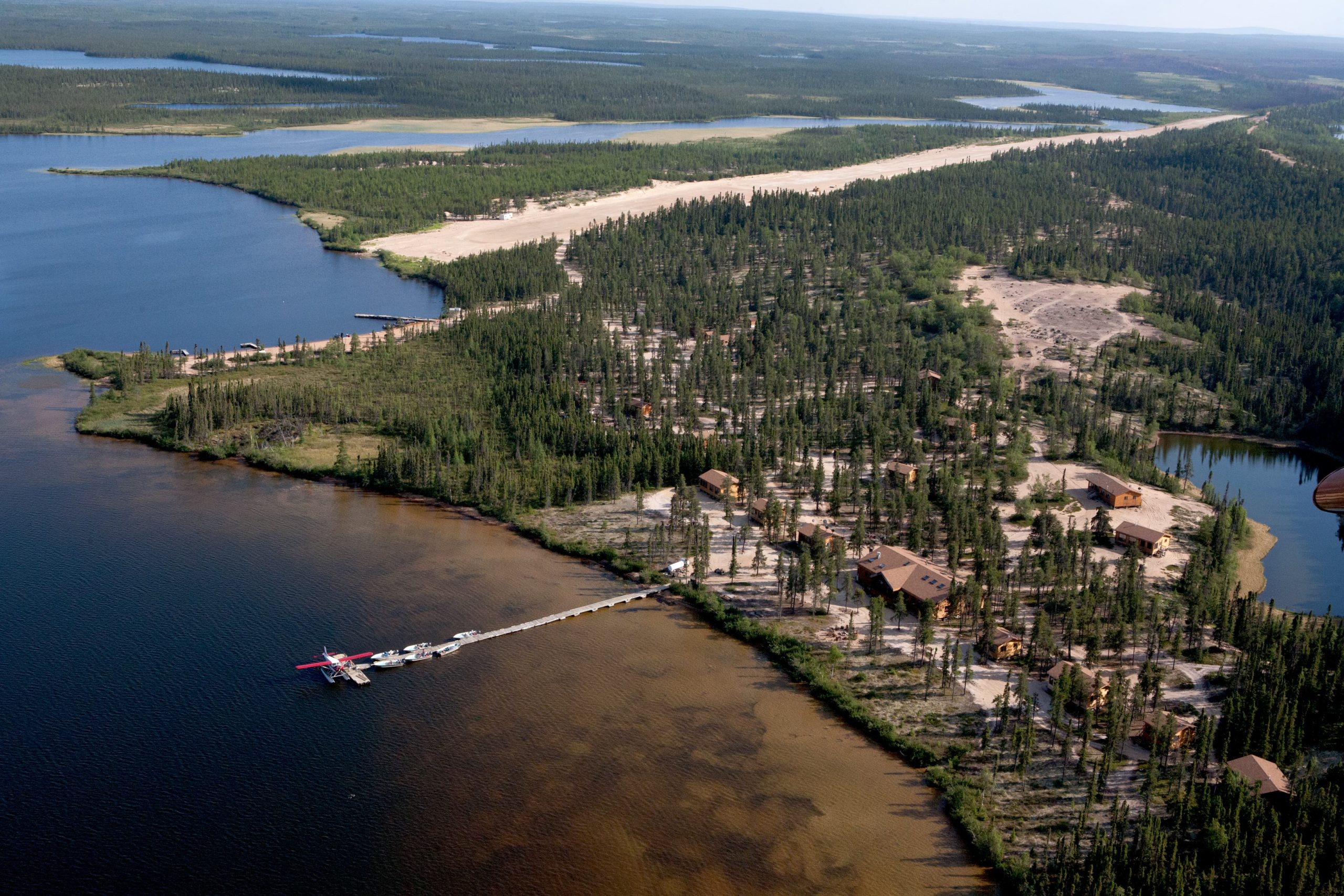
For an exclusive North Seal River lodge experience, stay at Gangler’s. Our luxury wilderness lodge only hosts 26 guests at a time with exclusive access to our pristine fishery. Enjoy the 5-star accommodations while dining on delectable creations from our chef. Relax in our deluxe cabins and soak in the personalized attention from the Ganglers family and our dedicated staff.
Fishing is the priority. Egenolf Lake, home of the main lodge, is a gateway to a vast, unexplored watershed. With exclusive access to over 61 different lakes, you will experience the very finest in angling for trophy Northern, Lake Trout, walleye, and the surreal Arctic Grayling.
Availability
The NSRL Experience is currently available for 2024! Click on your preferred trip duration above to see available dates. Book your primetime spot while they're available!
Nearby Fly-out Lake
Best tackle and techniques, transportation.
Exclusive air charters from Winnipeg to North Seal River Lodge, landing on our private 5400′ runway. Expediting services in Winnipeg are included.
Learn More about floatplanes .
The Gangler’s North Seal River lodge experience is a 5-star experience. Our lodge accommodates only 26 guests per week. The lodge features a full-service bar and lounge area, complete with ping-pong, a pool table, and a large outside deck and firepit.
Enjoy a blend of traditional fare and Manitoba specialties, including local berries, smoked lake trout and Goldeye. Meals include breakfast, lunch & dinner served by our wait-staff!
*Dietary restrictions can be accommodated with advance notice.
Full Service Bar & Coffee Delivery
The North Seal River Lodge houses a full service bar with a modern selection of premium liquors, beers, and wine. Special requests can be made in advance.
Complimentary coffee is delivery to your cabin every morning at 6:45 AM by our lodge staff. Any special requests? Just let us know!
Fishing Amenities
Guests will enjoy fishing in custom 18’ and 16 1/2’ boats outfitted with 40 to 25 horsepower, Yamaha four-stroke outboard motors, and depth finders.
Two complimentary portage lakes are included.
Complimentary Loaner Fishing Equipment
Gangler’s works with the finest tackle companies. We feature a selection of Shimano, Penn and Temple Fork rods and reels onsite which may be borrowed. For fly-fishermen, we offer Sage, Orvis, and Temple Fork rods and reels. Tackle boxes can be rented at $ 200 per box. One box should service two fishermen. Fishing equipment availability limited – first come-first serve basis. Reserve your gear at [email protected] .
Accommodations
North seal river lodge.
The North Seal River lodge experience is designed to be luxurious and exclusive. Gangler's accommodates a maximum of 26 guests per trip. The main lodge is the epitome of the classic remote Northern lodge, offering the full flavor of the North with its motif and decor. This is where guests will get to dine, relax, & socialize with other guests from all over the world. Our staff to guest ratio of 1:1 ensures your satisfaction.
Inside the North Seal River Lodge
The perfect combination of a rustic Northern Canadian Lodge & luxury, the North Seal River Lodge ensures that all guests have a place to relax and be close with their friends & family. Pick of pool or ping pong as you await your delicious five-star meal inspired by Northern Canadian cuisine.
Private Cabins
Private cabins accommodate 2-4 guests. They feature one private bath per 2 guests, separate living rooms and bedrooms, 24-hour electricity, free wireless Internet, DVD players, propane heat, screened-in porches, and daily maid service.
Inside Your Private Cabin
Our gorgeous private log cabins offer full amenities such as modern bathroom per 2 guests, heating, video TV, separate living room, comfortable beds, housekeeping service and a screened porch.
Canadian Shore Lunch
Lunches include the incredible classic Canadian Shore Lunch prepared by your guide on the shores of Egenolf Lake.
Our full-service main lodge bar features many classic Canadian favorites along with classic domestic liquors found in both in Canada & the U.S.
Northern Manitoban inspired cuisine that is prepared fresh & delivered by waitress to table service. Complimentary soft drinks and wine are included with dinner.
North Seal Gift & Tackle Store
Our fully-stocked gift and tackle store features Yeti, Patagonia, Orvis, Sage, Temple Fork, and Costa products and equipment — only the finest! A complimentary fly-tying table is available for use, as well as free loaner rods and reels for spinning, baitcasting and fly fishermen.
The Fishing
Gangler’s provides a premier Canadian lodge and fishing experience. It was built in the North Seal River region, an extremely diverse and fertile watershed that offers an incredible mix of habitats. The lodge acts as a base to access and explore this incredibly large and diverse watershed, offering anglers pristine fishing waters that rarely see a cast. Trophy fish of all five species (big whitefish too!) thrive here and this combination of size, quantity, and variety is what has quickly made the North Seal Canada’s premier sportfishing destination.
Learn more about Canadian Grand Slam
Experience the Wildlife
This region has two unique worlds that offer incredible diversity in biodiversity and terrain. Both are home to an amazing array of wildlife to experience in their natural habitats. Wolves, black bears, Barrenlands grizzlies, wolverine, moose, pine martens, otters, arctic hares, mink, beavers and of course caribou call the Sub-Arctic home.
Learn more about the Wildlife
PREPAY SPECIAL 2025 trips
All new reservations:
Save 8% per person if you prepay.
Child Discount
July 6th - Aug. 24th
Children 16 years of age or younger are eligible for a 25% discount.
Couples Week
July 4-8th, July 13-20th, & July 18-23rd.
Wives receive 35% off!
3-Day Trips
Based on double occupancy
$ 3995 USD per person
Trip Terms and Conditions
$4,595 USD/person
4-day trips, $5,995 usd/person, 5-day trips, $6,495 usd/person, 7-day trips, $6,995 usd/person, fishing, eco, & northern lights, maria lake mini-lodge.
©2021 Gangler’s Fly-in Lodges and Outposts
Privacy Policy
Terms and Conditions

- Trophy Hunting
If you are dreaming of a unique hunting experience, where musk ox bulls and caribou bucks live in their natural environment, then Greenland is the place where even the most seasoned trophy hunters will experience a challenge to their hunting instinct and ingenuity.
Trophy hunts for reindeer and musk oxen for tourists in July will be suspended from 2021 until 2024
Trophy hunting in greenland.
In Greenland, you can pursue a trophy animal in cooperation with a local hunter. Hunting is operated according to the terms and limitations set by nature, demanding great adaptability and a willingness to see one’s personal limits tested. The huge distances and vast open spaces will make the hunter feel that he or she is one with nature.
It is very important to Greenlanders that hunting is operated according to the law and to sustainability guidelines. Only local operators can offer trophy hunting as a product, and there are rules about which animals are hunted and to what extent.
Hunters make sure that no part of the animal goes to waste. The meat is always given to local hunters or shared with the local community. Greenlanders are incredibly resourceful and can make good use of every part of the animal.
TROPHY HUNTING IN WEST GREENLAND
Trophy hunting in West Greenland is for the most part concentrated around the area of Kangerlussuaq. Here you land almost right on top of your prey at the small international airport which provides access to the area and the hinterland around the town.
In Kangerlussuaq during the winter hunting season, you have the opportunity to travel by dog sled and experience traditional hunting as it is still practiced by hunters from both Kangerlussuaq and Sisimiut . Trophy hunting by dog sled combines the feel of the winter landscape with the closeness of the dog team and their handler, in a way you won’t find in any other part of the world.
During summer and fall, the hunting grounds are usually reached by taking a boat up the fiord and up one of the rivers. But you may also be flown by helicopter straight to your guide’s hunting grounds.
During both seasons, the main focus is on large game such as reindeer and musk oxen, but smaller game may also be included in a hunting trip, as you will have the opportunity to hunt hare, fox and ptarmigan in the area as well.
Besides trophy hunting in Kangerlussuaq, there are great opportunities for hunting caribou and smaller game deep in the Nuuk fiord system. The fiord is known as an area with a large number of caribou and is an area favoured by subsistence hunters as well as recreational hunters.
The huge distances and vast open spaces will make the hunter feel that he or she is one with nature.
Package Tours
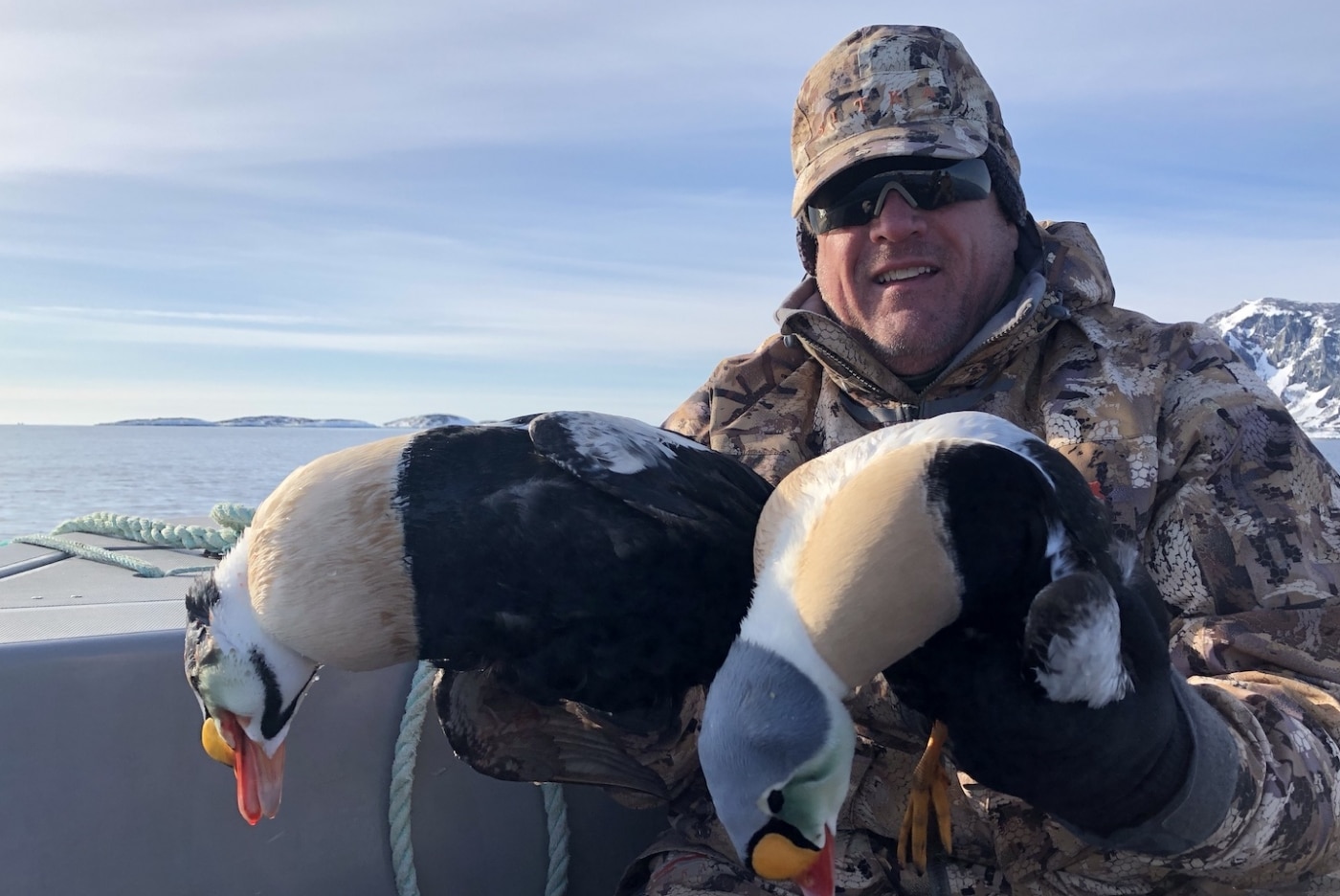
Greenland Outfitters
King Eider Hunting
GreenlandOutfitters offers quality King Eider Hunting. Limit 15 Eiders plus 15 other waterfowl Combo
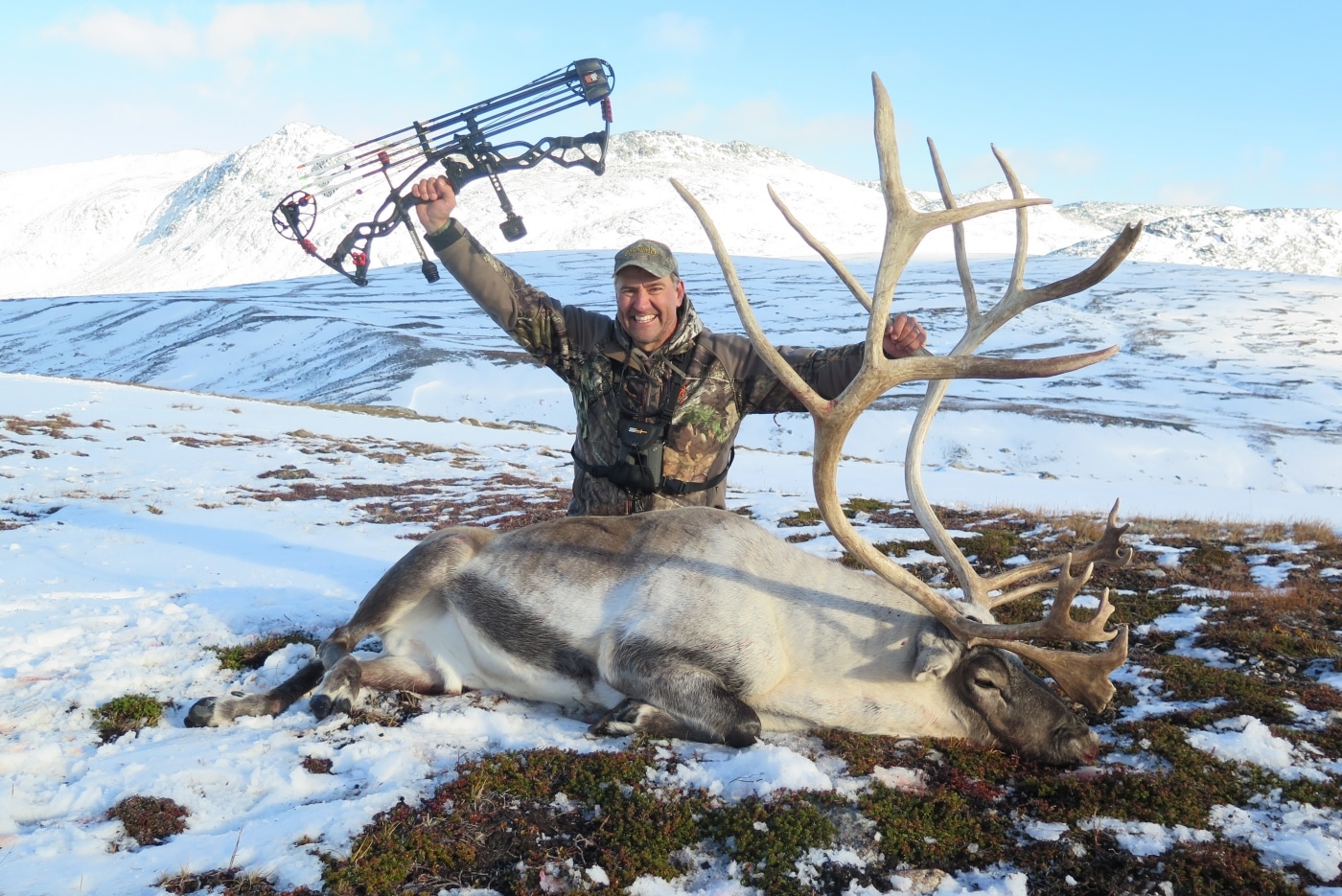
BowhuntingGreenland
Caribou Hunting
BowhuntingGreenland offers quality Caribou Hunting only
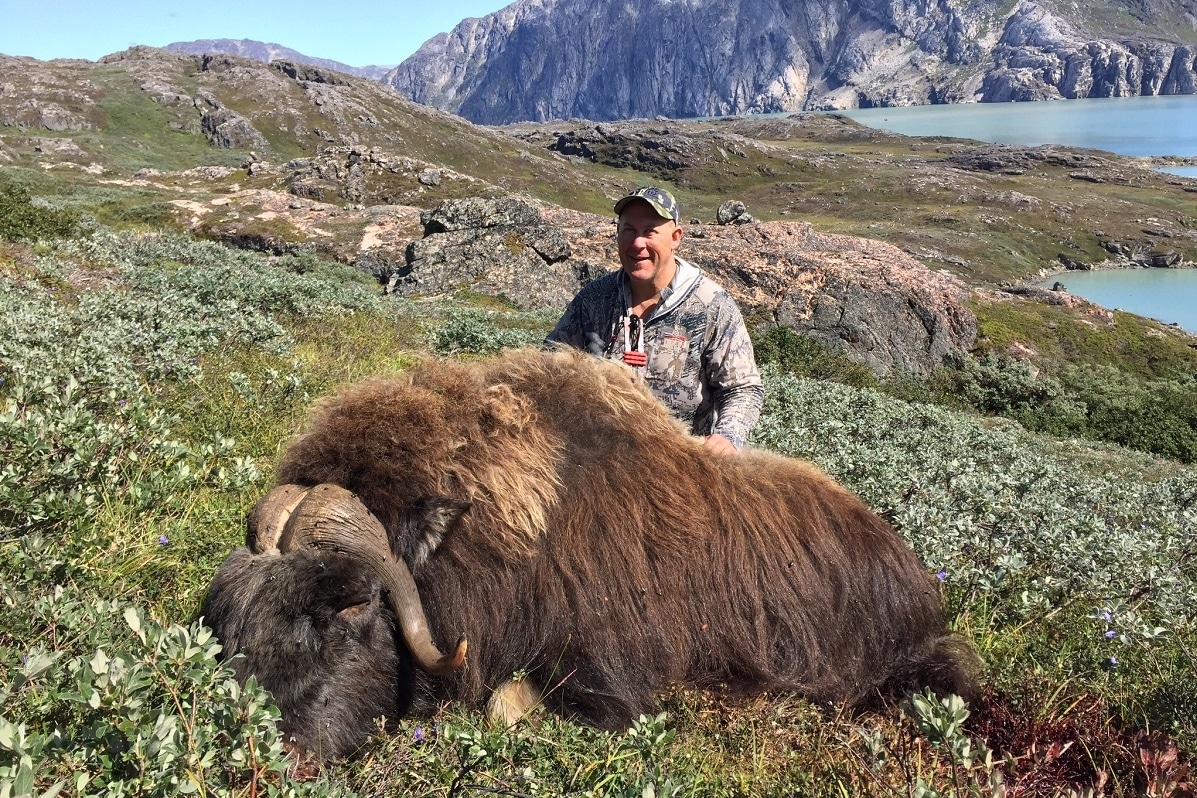
Bowhunting Greenland
Muskox hunting with rifle.
Muskox Hunting quality expedition hunts for big Trophies in remote areas with GreenlandOutfitters
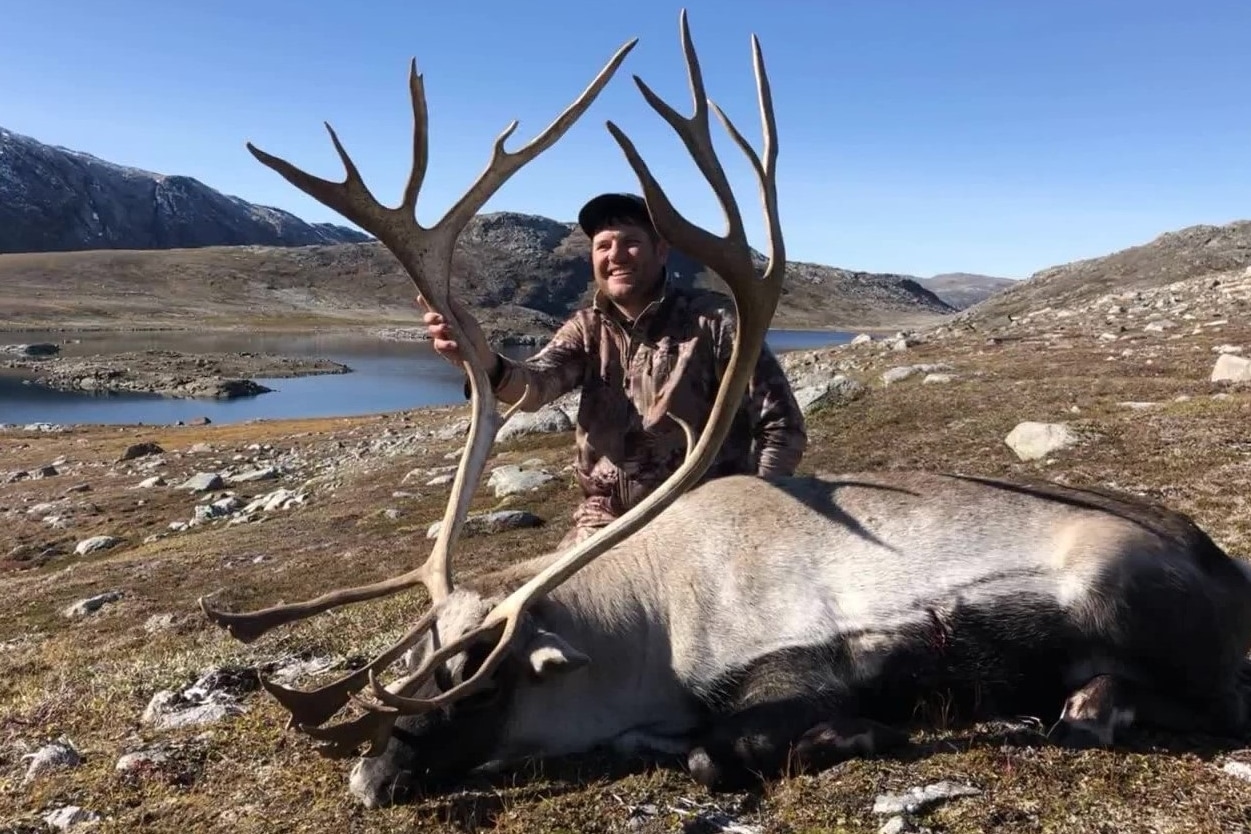
Caribou Hunting with Rifle
GreenlandOutfitters offers quality rifle Caribou hunting
TROPHY HUNTING IN SOUTHERN GREENLAND
South Greenland is known as the breadbasket of Greenland, and the local population have, way back since the very first immigrants arrived, known of the region’s rich rivers full of Arctic Char. In modern times, both reindeer and musk oxen have been moved to the area, and herds have now grown to a size that permits trophy hunting.
Great summer and fall hunting of musk ox and reindeer in the Ivittuut area, around Isortoq and on the island of Tuttuooq in Southern Greenland, provides opportunities for the trophy hunting of semi-domestic reindeer. As an extra bonus, boating to and from the hunting grounds takes one past large and small icebergs. The icebergs come from the surrounding fiords, or have drifted down from the Arctic Ocean along the East Coast of Greenland.
In order to go trophy hunting in Greenland, the following is required of the hunter: Has secured an approved trophy hunting event with an authorized commercial hunting organizer
The hunter is able to present a valid firearm license (or hunting permit) from the hunter’s country of origin, and has acquired a certificate or license to hunt a musk ox, a reindeer or a caribou, and can furthermore at all times present a valid license for any other type animal that the hunter intends to hunt.
If the hunter wishes to hunt with bow and arrow, then documentation must be presented proving that the hunter has passed certification courses regarding bow and arrow hunting.
TROPHY HUNTING IN NORTHERN GREENLAND
From the Disko Bay area towards the north of Greenland, trophy hunting is done in a few places. However, the populations of animals are limited, providing for a real pioneering experience, especially around the area of Lersletten (Naternaq) by the small town of Qasigiannguit in the innermost part of the bay.
During winter hunting, you go by dog sled from Qasigiannguit to the hunting area around Lersletten. In the summer, boats are used to get to the area.
Even further north, the areas around Svartenhuk peninsula and Qaanaaq are still considered virgin territories when it comes to trophy hunting. So if you are looking for an adventure that would be almost exclusively your own, then the most northern parts of Greenland harbour truly unique and untapped possibilities.
TROPHY HUNTING IN EAST GREENLAND
Ittoqqortoormiit (Illoqqortoormiut / Scoresbysund) in North Eastern Greenland is the original habitat for the musk oxen who at some point wandered into Greenland. This herd is the original stock of the herds elsewhere in the country.
The best way to describe trips into this wilderness is to view the human as a microorganism in a seemingly endless landscape, made even greater by the journey to the hunting grounds through the Scoresbysund Fiord, the largest fiord system in the world.
Hunting seal on the ocean ice during the spring is another opportunity you should give yourself as a hunter. You will get a true feeling of what it is like to sneak up on the animal while you are lying on your stomach hiding behind a shooting sail (a white cloth large enough to cover the hunter and make the seal believe it is seeing a chunk of ice and not a human hunter). This type of hunting is still being practiced by local hunters in the most remote areas of Northern and Eastern Greenland.
ORGANIZERS OF HUNTING TRIPS IN GREENLAND
Organizers of hunting trips in Greenland are always local hunters with firm ties to the community and extensive knowledge of hunting techniques, weather conditions, landscapes, and hunting grounds.
Many of them live as subsistence hunters and are usually assisted by other subsistence hunters in cooperation with local and international organizers of trophy hunting trips.
If you wish to import weapons for hunting, you must bring a documentation that you own the weapon, and you must fill out this form at Air Greenland.
Local providers
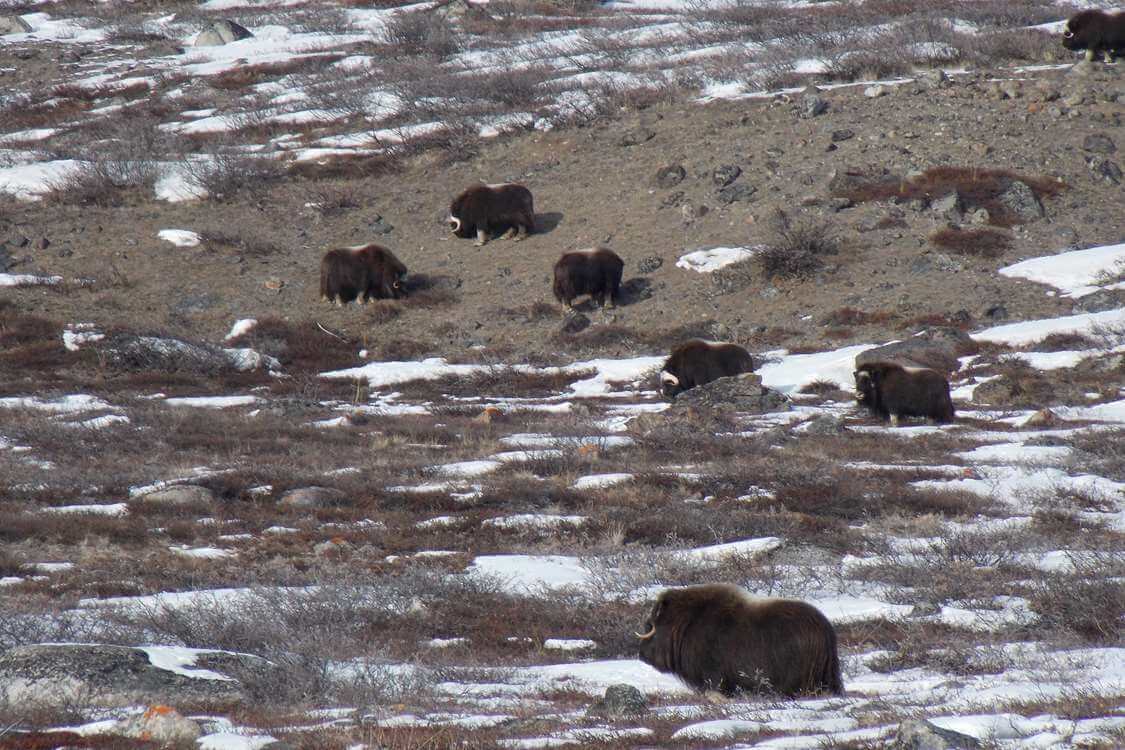
Trophy Hunting Greenland
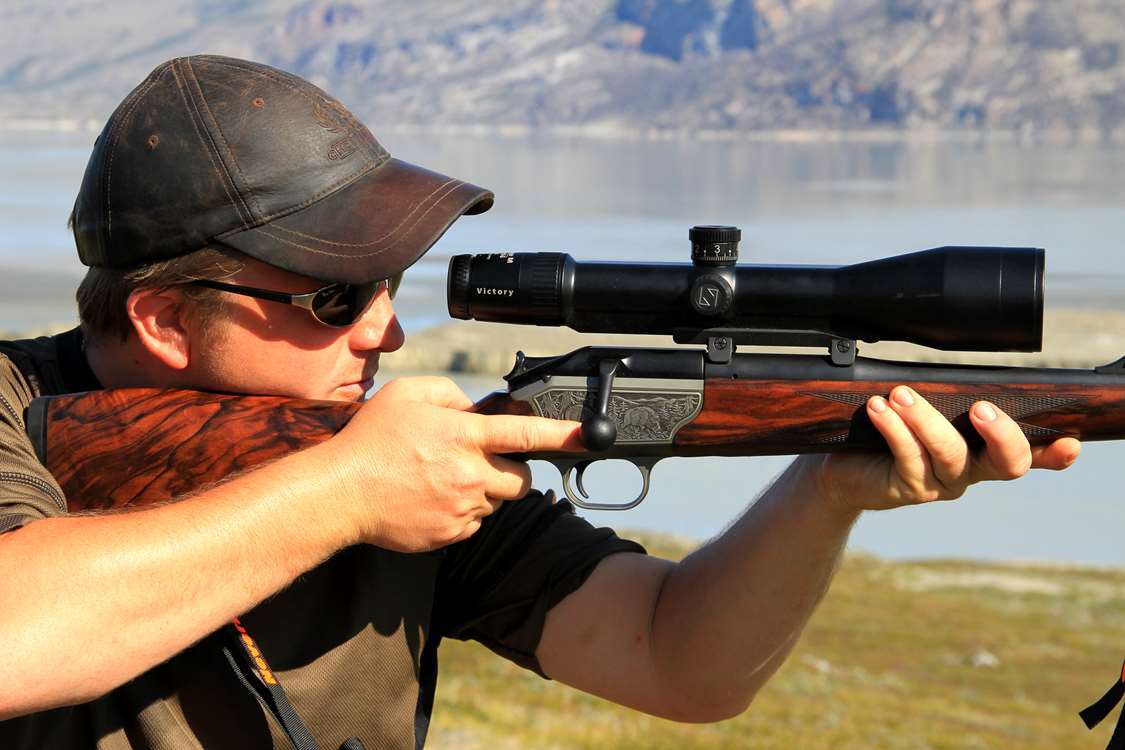
Major Hunting
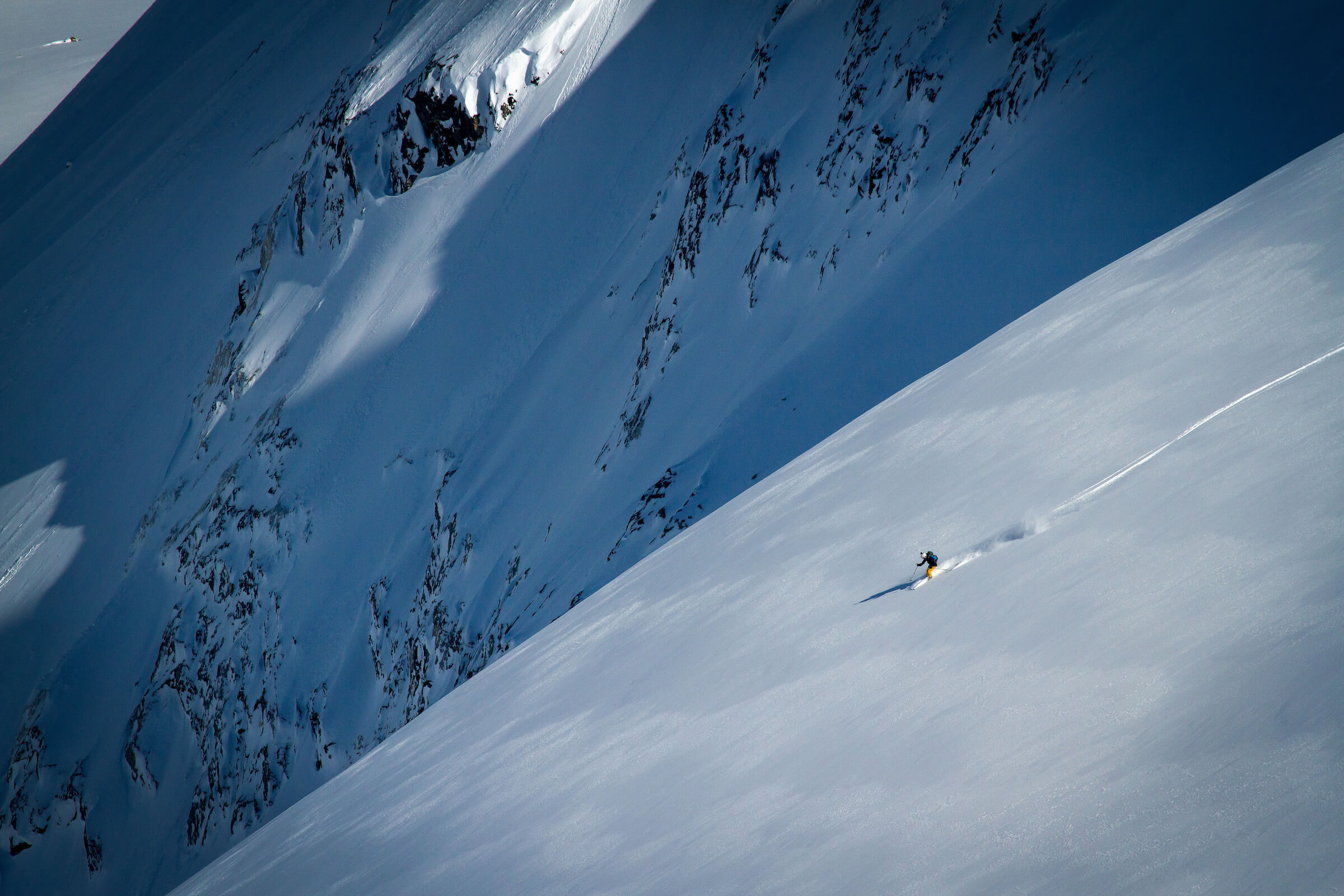
Greenland Extreme
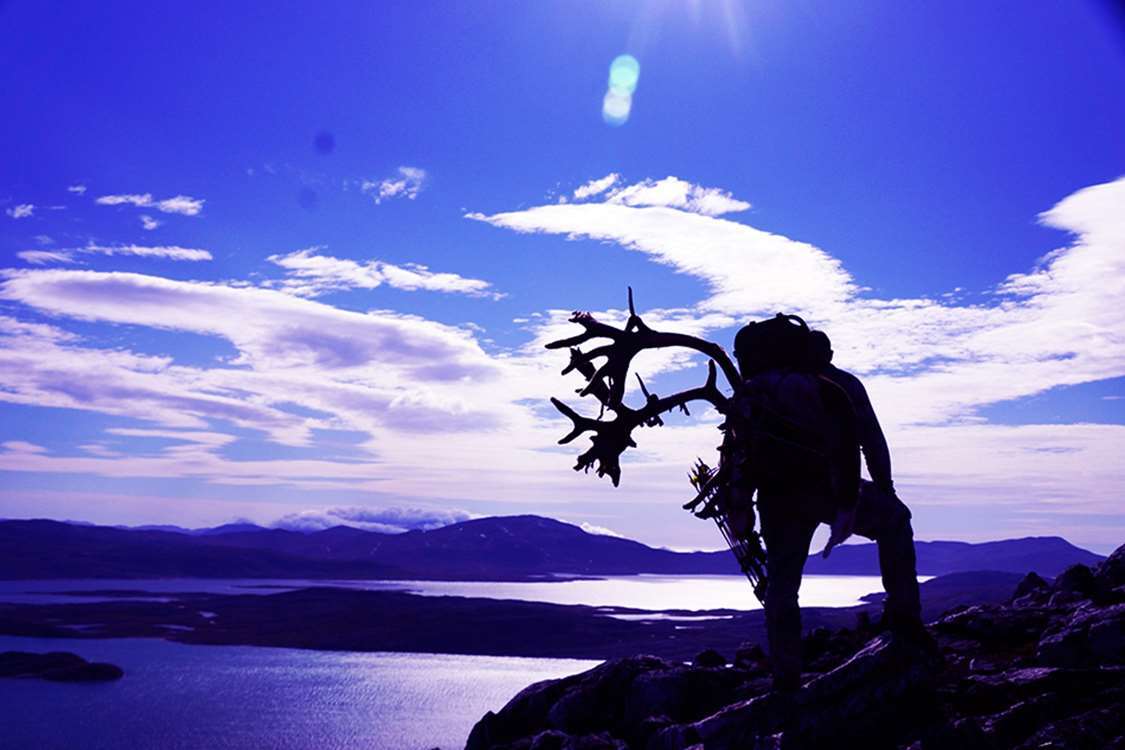
Explore related articles, offers and tour providers:
- Capital Region
- Destination Arctic Circle
- East Greenland
- Ittoqqortoormiit
- Kangerlussuaq
- Natural Experiences
- South Greenland
- Tour Providers

By Visit Greenland
Behind Greenland's largest travel site is the Visit Greenland that is 100% owned by the Government of Greenland, who is responsible for marketing the country's adventures and opportunities for guests wishing to visit the world's largest island
Editors' pick
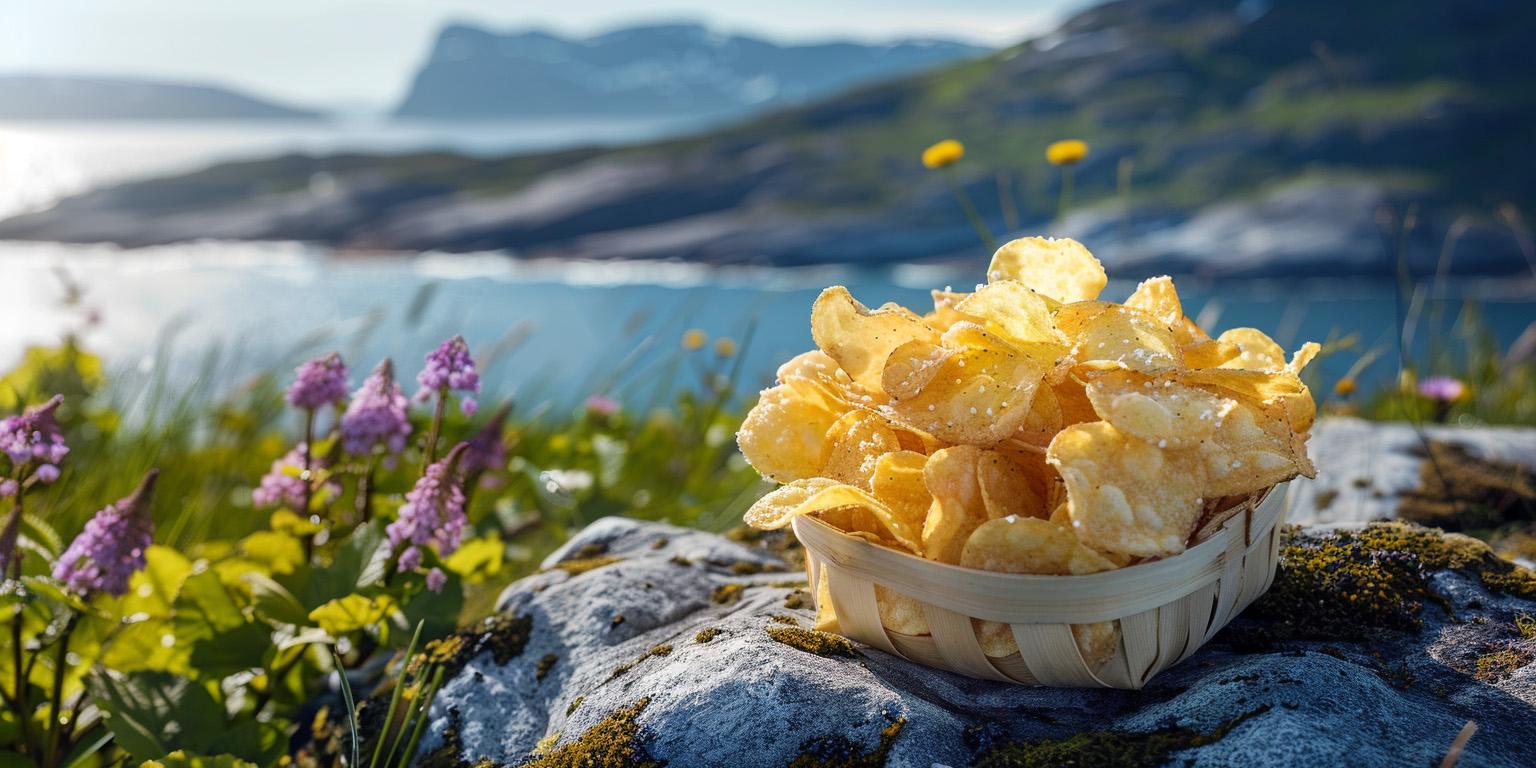
Introducing the Arctic Crisp: Greenlandic Sea Salt Potato Chips!
we are here to introduce a new local product, the Arctic Crisp, a.k.a Greenlandic sea salt potato chips!
- #Capital Region
- #Culture vs Nature
- #Food & Drinks
- #Gastronomy
- #Natural Experiences
- #South Greenland
- #Things to do & About
- #Towns & settlements
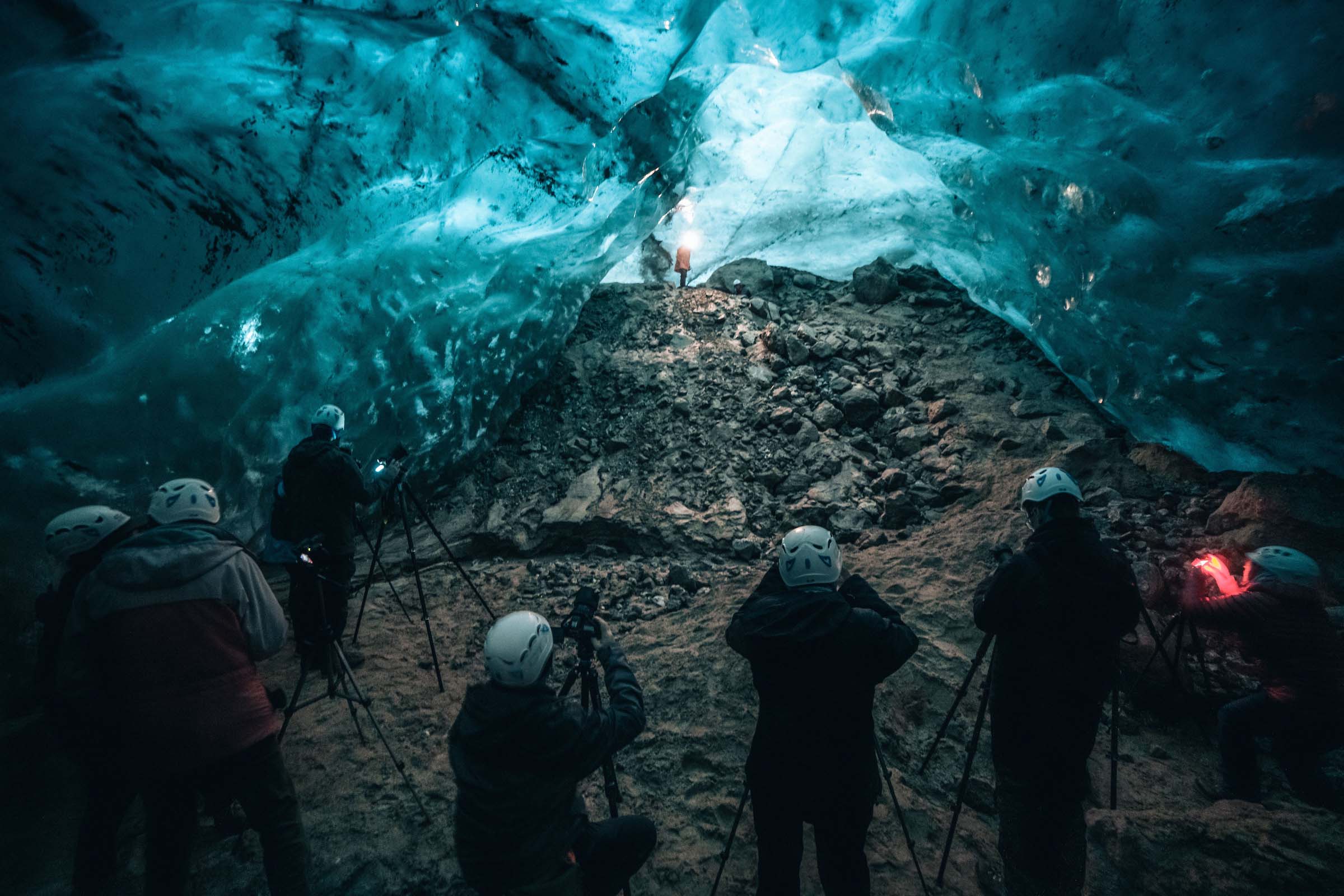
Discovering the Ancient: East Greenland’s Ultimate Ice Cave Expedition
Equipped with crampons and a helmet, we crunched over the ice and into the mouth of the cave. Our torchlight illuminated the otherwise pitch-black surroundings, revealing a grand expanse.
- #East Greenland
- #Photo tours
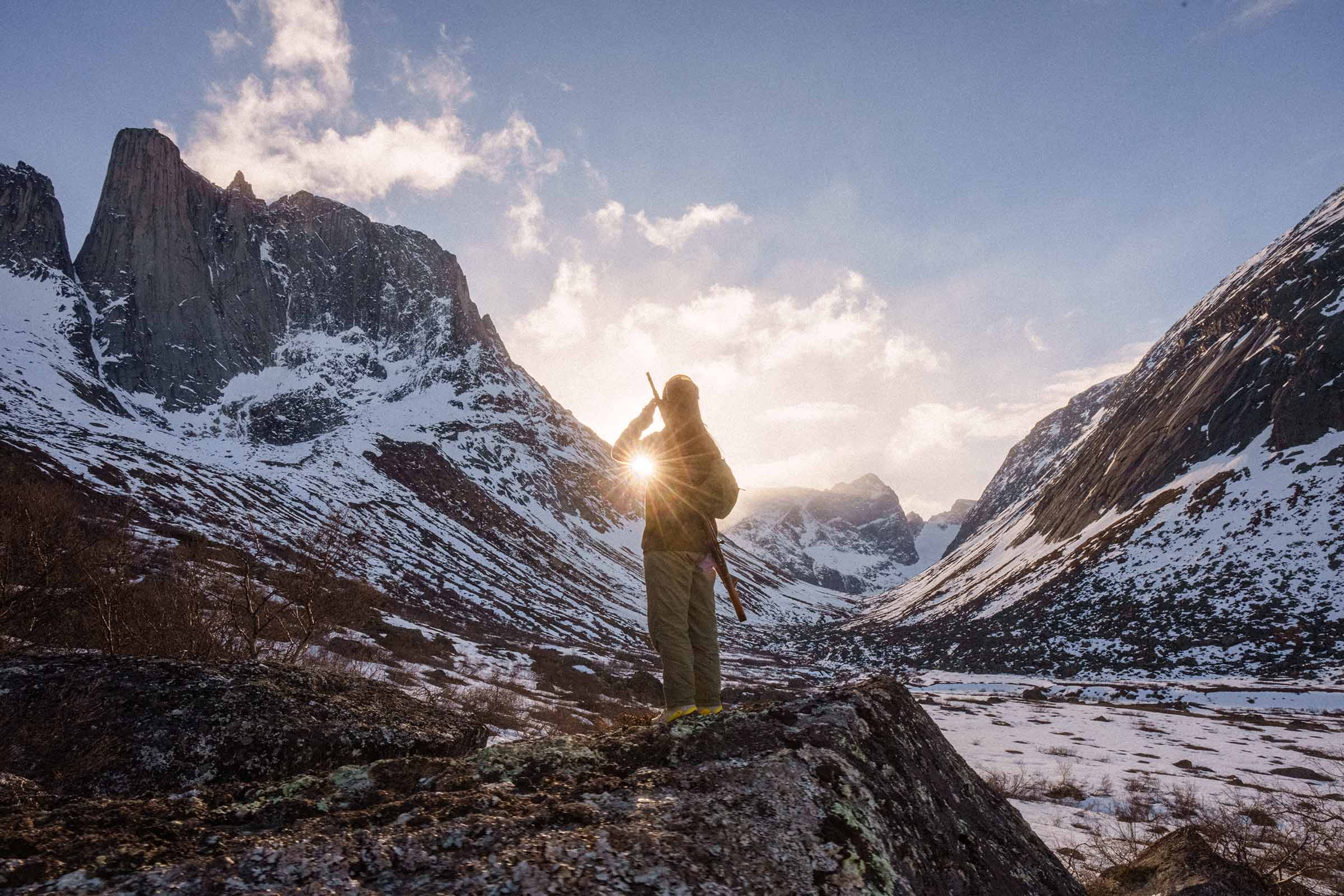
Discover the Raw Beauty of Tasermiut Fjord in Winter
Unlike other places in Greenland, South Greenland is mainly known for its green scenes, agriculture and sheep farming. But what about wintertime?
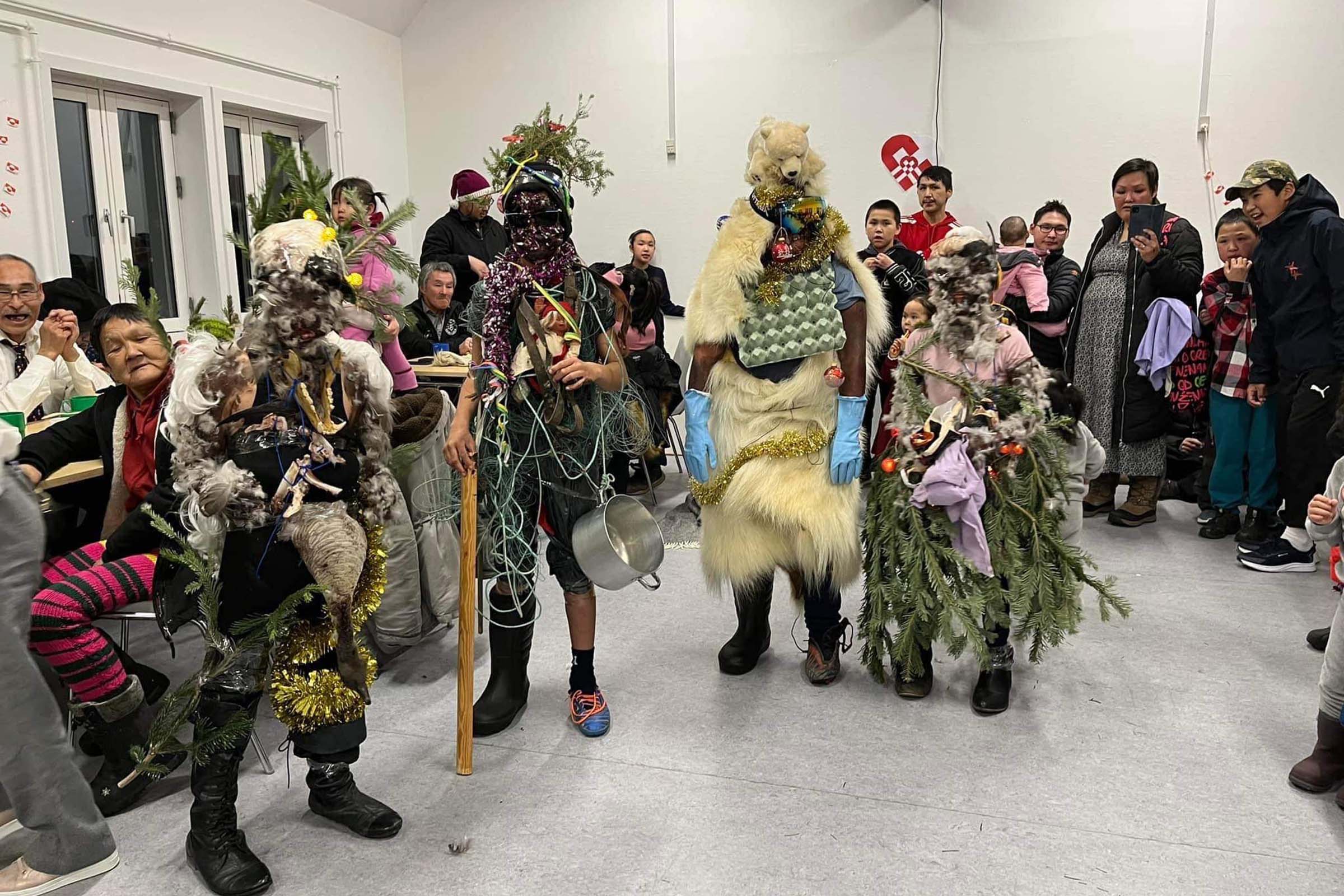
Greenland’s Mitaartut Tradition: Silent Masked Performances
Mitaartut, the traditional masked custom in Greenland, shares some similarities with Halloween, but there are also significant differences. Here's a comparison between the two.
- #Cultural Experiences
- #Destination Arctic Circle
- #Inuit Culture
- #Meeting Greenlanders
- #North Greenland
Keep Exploring

- Things to Do
Browse culture and nature (outdoor, hunting, fishing, cruises) related activities, as well as combination of both types.

Plan your trip
Read about practical information on how to get to Greenland, how to get around, when to travel or where to stay.

- Destinations
Explore the regions and towns around Greenland and dig deeper into the experiences in each destination.

About Greenland
All about art, music, history, as well as animals, climate change and other interesting information about Greenland.

About Visit Greenland
Frequently Visited Pages
- Nature & Climate
- Greenlandic Culture
- Frequently Asked Questions
Other Websites By Visit Greenland:
- Travel Trade
- Cruise Call List
- Media Database
SIGN UP HERE
VISIT GREENLAND – contact us:

- Update HUNT Information
- LOGIN / LOG OUT
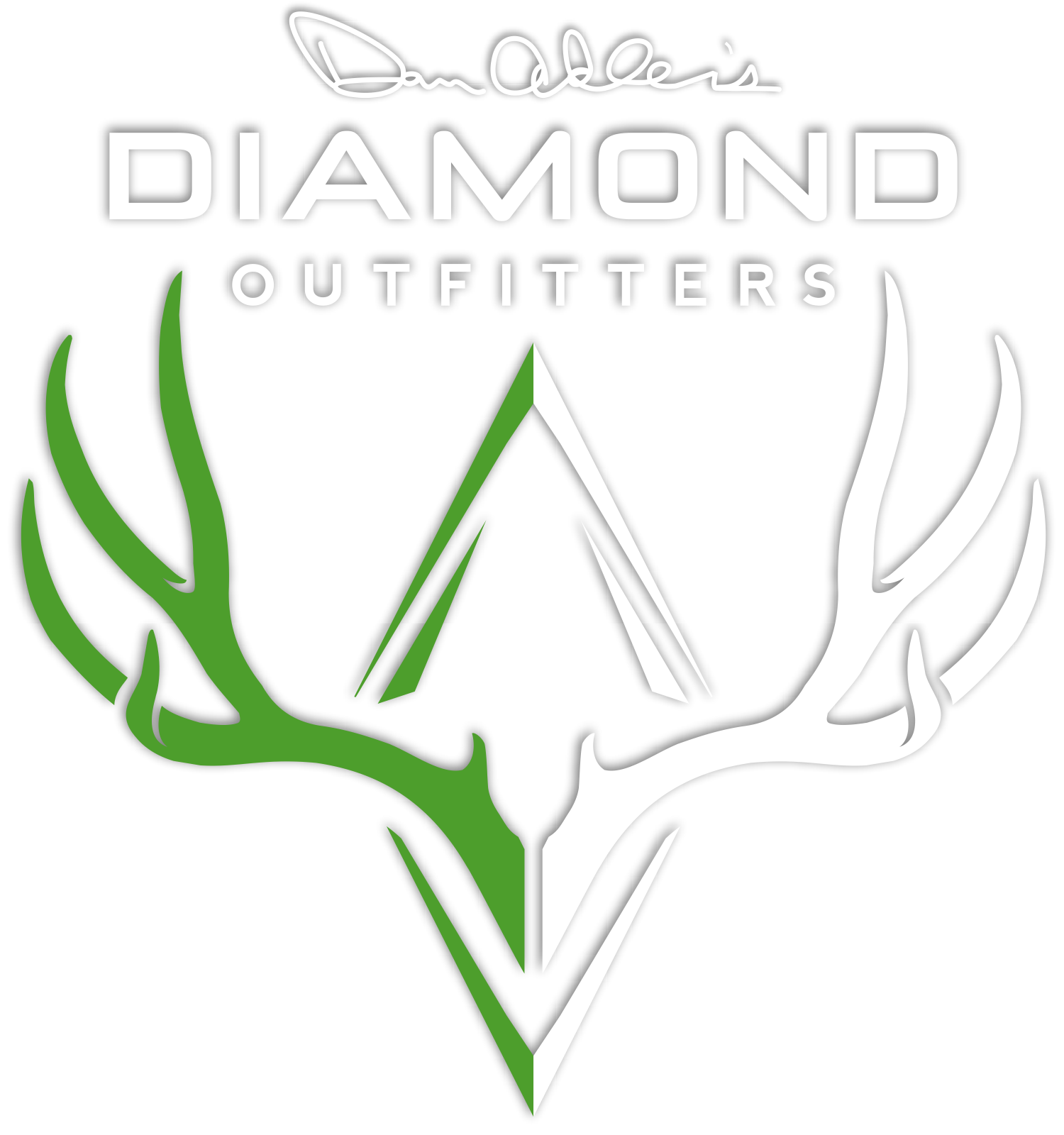
ARIZONA | NEW MEXICO | UTAH | NEVADA | WYOMING | SONORA, MX
Big game hunts, we are the largest full-time guide service in north america., big game hunts.
With more than 1,500 happy customers ready to provide a reference, DIAMOND OUTFITTERS, has grown to become the largest full-time guide service in North America.
We have hunting packages for every budget. Fully guided hunts will include guide, lodging, meals, private property access fees, field transportation, ranch trespass fees, USFS or BLM permits, skinning, quartering and caping of your trophy. Semi-guided hunts do not include camp or meals.
Choose a species below to learn more about a particular hunt package.
(background photo by George Andrejko – AZGFD)
Mountain lion, big horn sheep, turkey, javelina & predators, veteran owned and operated.

Dan Adler, Owner/Guide -Veteran USAF Officer and Command Pilot for the Yavapai County Sheriff’s Office Safari Club International - Arizona Chapter Hunter of the Year Many of our Guides are Veterans and First Responders.
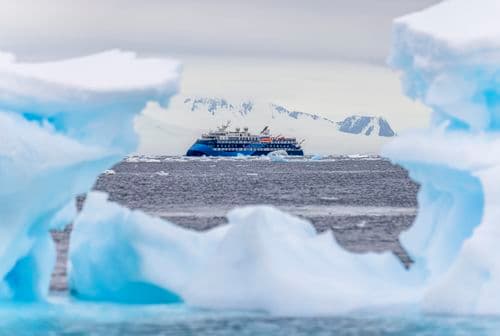
All Ships & How to chose the best
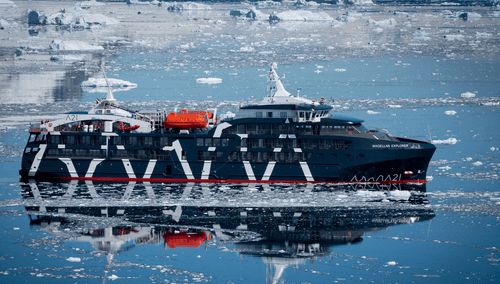
Small Ships
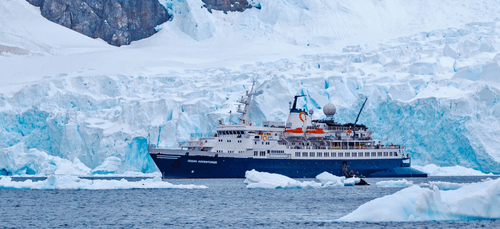
Mid-Sized Ships
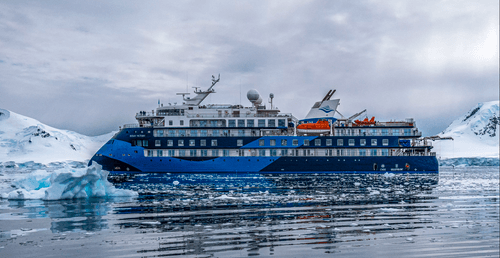
Large Ships
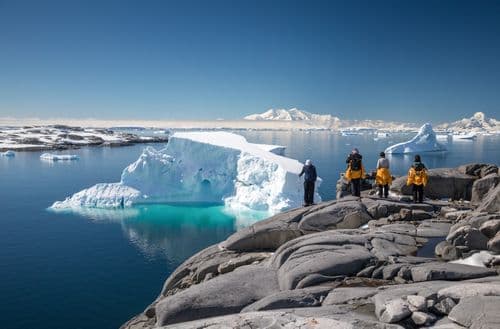
All Dates+Prices
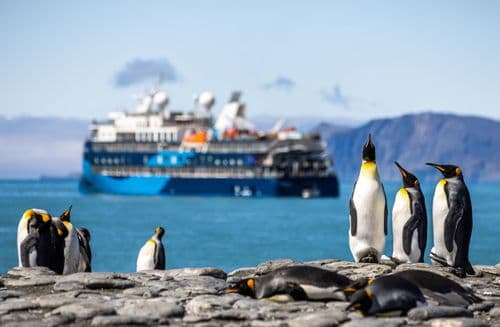
Falklands Islands
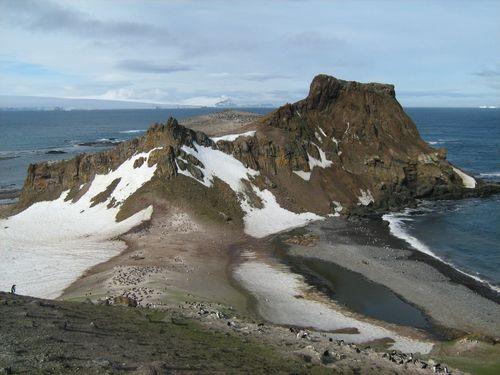
King George Island
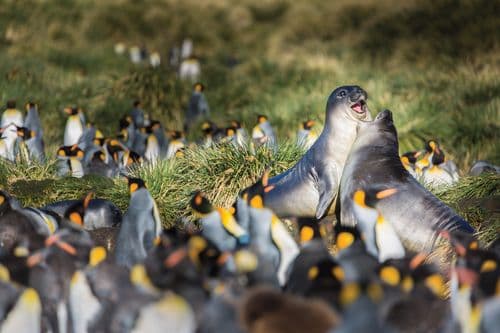
South Georgia
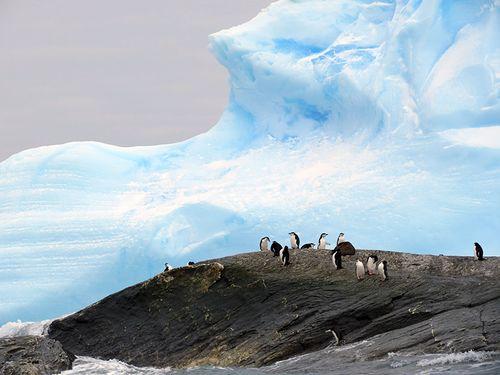
South Orkney Islands
South Shetland Islands
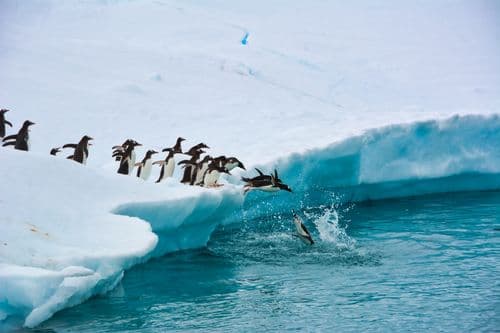
Wildlife of Antarctica
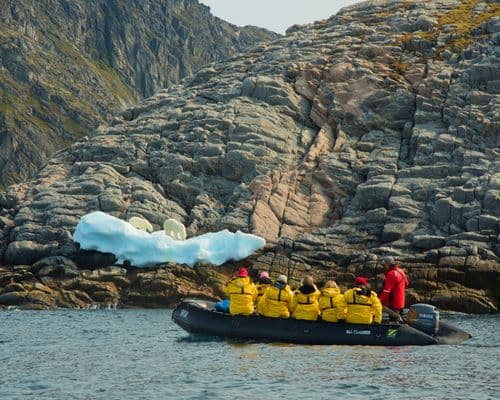
Canadian Arctic
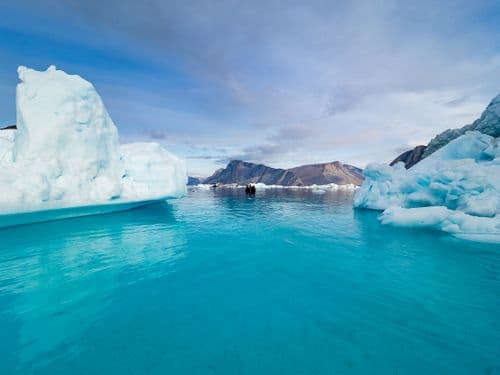
Northwest Passage
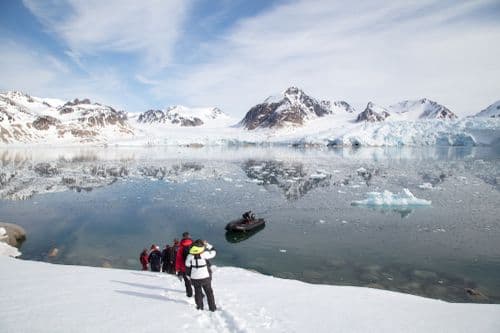
Wildlife of the Arctic
Your Advantages
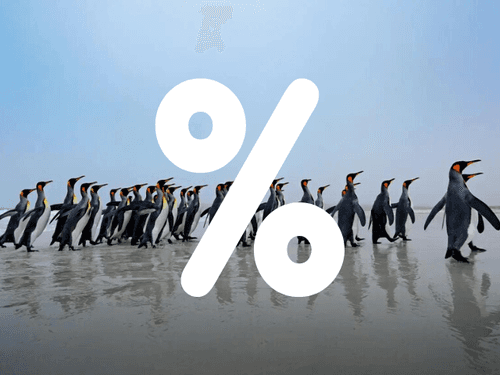
All Deals & Promotions
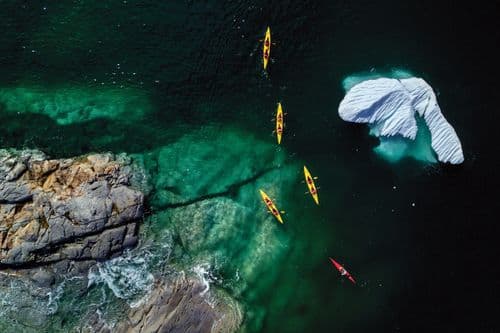
Financial Protection

Free Video Consultation
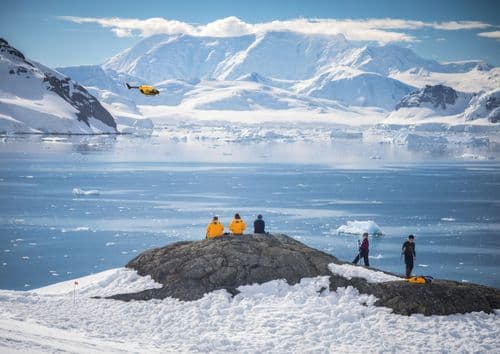
Travel Insurance for EU + CH Residents
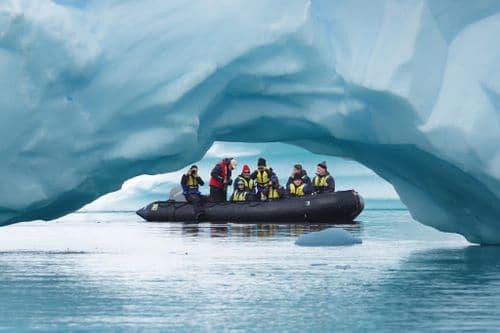
Unbiased Recommendations
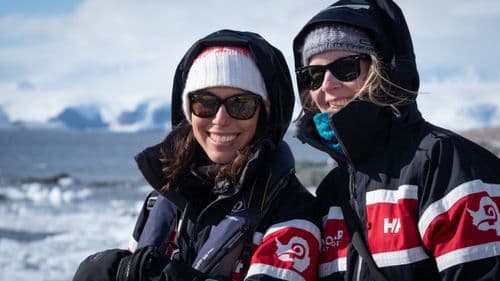
Why book with us?
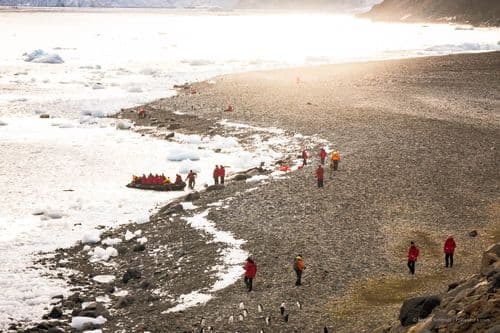
Activities & Add-Ons
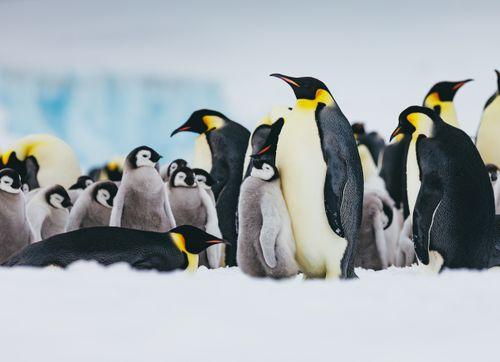
Avian Influenza Update
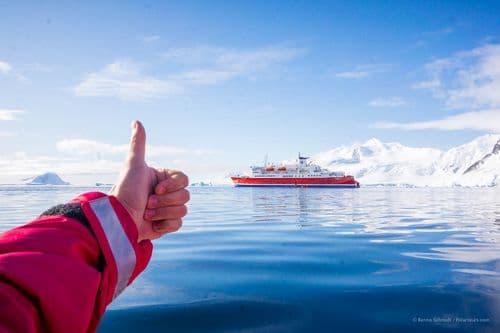
Free Polar Guidebook
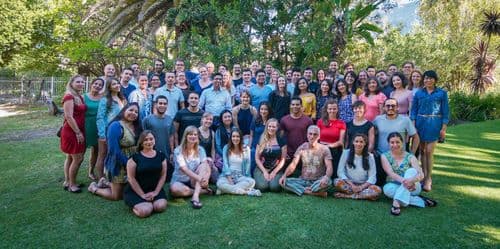
Polar Expert Talks
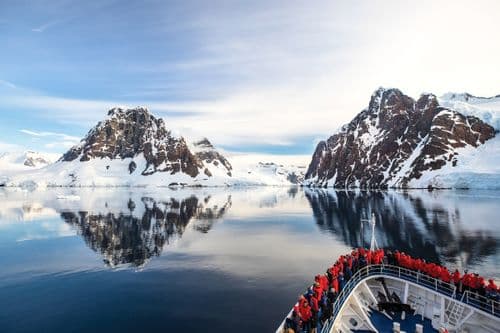
Sustainable Tourism
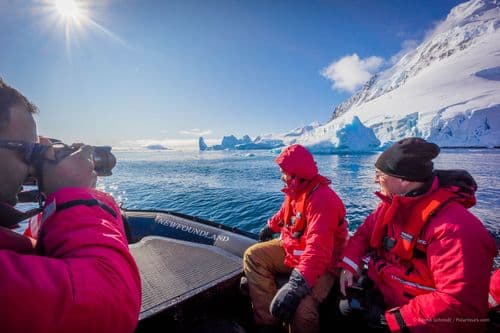
What our travelers say
Weekdays from 7:00 to 16:00 CST
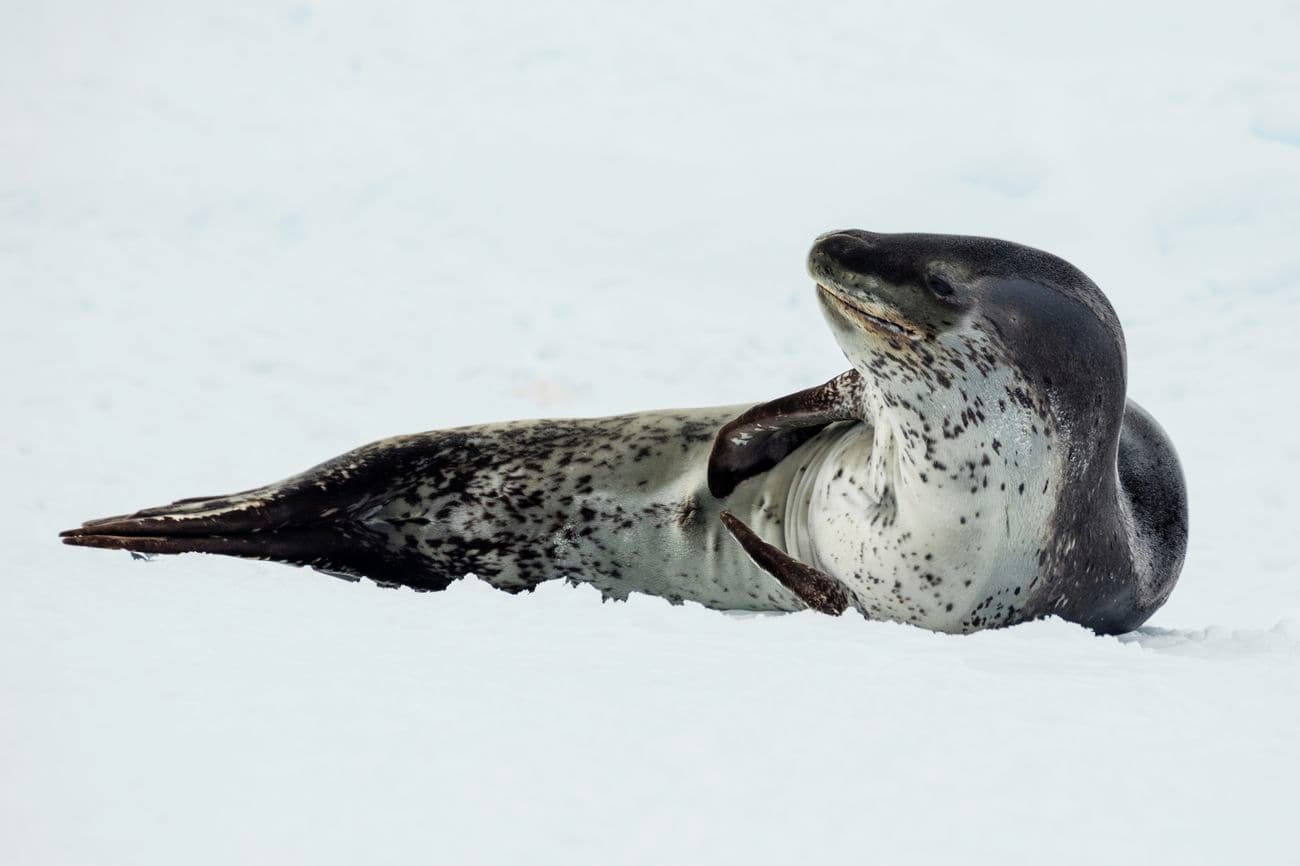
Leopard Seal
One of antarctica's most voracious hunters, what you need to know about the leopard seal.
Our Expert Says… "These magnificent predators do have quite gruesome hunting habits. They have a tendency to "play" with the prey, letting it go injured and catching it again, inflicting more damage but releasing. It's almost as if they relish the hunt more than the meal. When they do finally decide it's time to eat they can almost turn prey inside out, such is the ferocity of their jaws. A fascinating and terrible spectacle!"
The leopard seal has a rightfully fierce reputation! This is the second-largest Antarctic seal and the most renowned underwater hunter in the polar region.
With a muscular 3.3m (11ft) long body weighing up to 590kg (1,300lb) and massive, oversize jaws with inch-long canine teeth, the leopard seal is a top predator. They are seemingly fearless and will attack a wide range of prey including squid, fish, and krill when young, moving on to penguins and other seals, including fur seal pups around South Georgia island.
Leopard seals are cold-water specialists, and they hunt around the Antarctic pack ice, following its advance and retreat as the seasons change. They can use their specially adapted teeth to strain krill from the water, and this ability is thought to explain their success, allowing them to move to new areas in search of larger prey while sustaining themselves with the small crustaceans. Their only predator is the orca or killer whale.
The way that leopard seals hunt penguins is both fascinating and gruesome. The seals stay submerged just beyond the ice floe edge where penguins have to jump in or out of the water. The leopard seal uses its unusually large front flippers to move with speed and great agility and catch the penguins by their feet. Once caught, the seals batter the birds against the water’s surface repeatedly until they are dead. They then rip the carcass apart and swallow it.
Little is known about the complete breeding cycle of the Leopard seal as they breed in very remote locations that make observation difficult. It is known that the leopard seals mate in the water and that females haul up on to the pack ice when they are ready to give birth, digging a shallow circular hole in the ice for the pup.
The leopard seal is an apex predator that is superbly equipped for survival in the constantly changing and challenging Antarctic waters.
Leopard Seal: Pictures & Videos
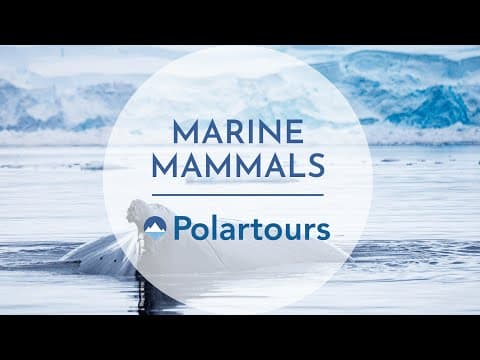
Spots where the Leopard Seal can be observed
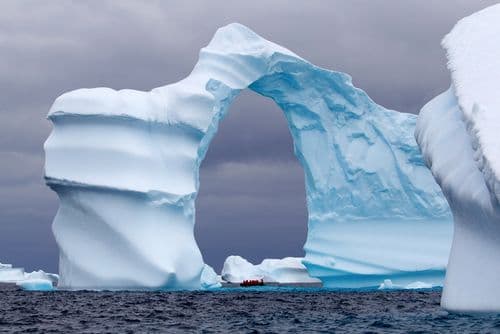
Antarctic Sound
A gateway to the ultimate adventure that only a few will be lucky enough to experience.
Located at the northerly tip of the Antarctic Peninsula, the Sound is a remarkable onslaught for the senses as you come face-to-face with monstrous slabs of ice, now floating free as enormous tabular icebergs. These have broke away from ice shelves in the Weddell Sea and drifted into the Sound.
Treacherous to early explorers, the first vessel to successfully navigate the Sound was The Antarctic, the vessel of the Swedish Nordenskjold expedition of 1903. Unfortunately, she was trapped in the Weddell Sea by ice the following year and crushed - one of several vessels to have that fate over the decade.
Fortunately, modern polar cruising vessels have no such worries with their strengthened hulls and modern navigation technology. As you enter the monochromatic beauty of white ice and grey sea you will know that that you are soon going to experience some of the remarkable sights and encounter the wonderful wildlife that makes its home in these islands of snow, ice, and rock.
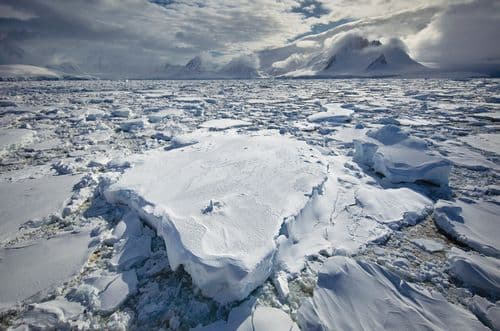
Astrolabe Island
Astrolabe Island in 3 miles long, and can be found about 14 miles off the Cape Ducorps in the Bransfield Strait on the Trinity Peninsula. It was discovered in 1837 and named after the French expedition ship that found it.
There is a wonderful crescent beach on the northern shore which is where you will land. Depending on the time of year you might have to pick your landing spot carefully to avoid the Antarctic fur seals who breed here and can be aggressive if they have very young pups.
The main attraction is the chinstrap penguin colony, several thousand strong. On your way in or out of this site, you will no doubt sail close to a group of impressive rocks that stick out of the sea to the northeast, known as the Dragon’s Teeth. Some of our expert Antarctic cruise guides have decided that if your ship sails in between any of the teeth, that means you have “flossed” Astrolabe Island!
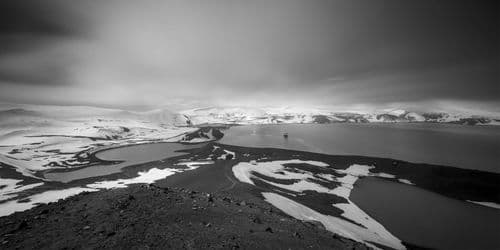
Baily Head on Deception Island
Deception Island one of the South Shetland Islands off the Antarctic Peninsula. The island is actually the top of the cone (the caldera) of an active shield volcano that last erupted in 1969.
This flooded caldera makes a remarkable natural harbor, although Baily Head itself is on the eastern outer flank of the cone. The geography here makes a natural bowl in the landscape, with the long rocky beach leading up to a curving ridge above. To the north is an impressive glacier.
As you approach the beach at Baily Head you will begin to hear the amazing noise that a colony of over 200,000 chinstrap penguins can make! During the summer, the glacial melt stream allows them to create a penguin “highway” that the birds follow to and from the sea, hundreds moving back and forth at any time.
Your expert Antarctic guides will take you to the edge of the breeding groups, allow you to experience this remarkable sight without disturbing the birds.
Other regular visitors to the Head include Antarctic Fur Seals who regularly haul up on to the beach, with crabeater, elephant, Weddell, and leopard seals also sometimes being seen in the surrounding waters.
Overhead you will find skuas, petrels, and sheathbills, all of whom also like to nest in the sheltered rocks of Baily Head.
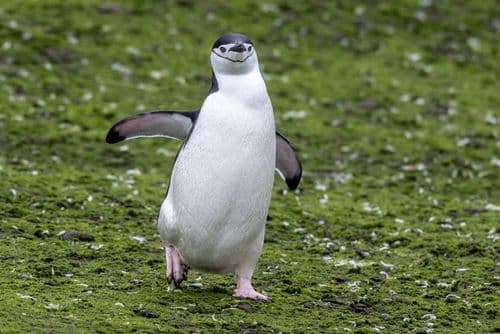
Barrientos Island
Barrientos Island is one of the Aitcho group of islands, a sub-set of the South Shetlands chain. It’s an ice-free island that was used as far back as the early 19th century by sealers and whalers, despite only a mile long, and less than a third of a mile wide. It was given its name in 1949 by a Chilean Antarctic expedition.
The northern coast of Barrientos is formed by steep cliffs about 230ft above the sea level. The east and west coasts are made up of black sand and pebble beaches. To the west, you can see impressive columns of basalt rock left over from the tectonic forces involved in the island’s formation.
Barrientos is very popular with penguins - and because it is so small sometimes it can feel pretty crowded! Gentoo and chinstrap penguins breed here, and in peak season one colony can end up right next door to the other, making for a seamless vista of penguin nests!
Other species that are commonly seen include fur seals (later in the year), as well as nesting colonies of southern giant petrels. Your expert Antarctic guides will ensure you get close enough for some amazing photos while staying far enough away that you don’t disturb the breeding creatures.
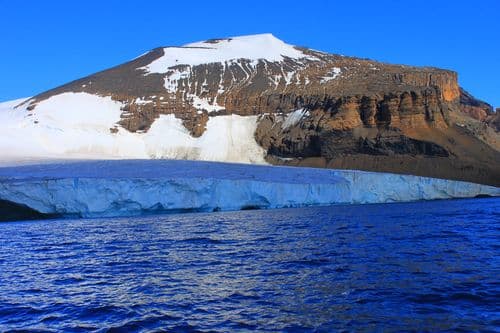
Brown Bluff
Brown Bluff is a great example of a “tuya” - a volcano that has been flattened by erupting through a glacier! These are the rarest of all volcano types and only found in areas that have seen large-scale glaciation in the past.
Brown Bluff with its distinctive “tabletop” look, lies on the Tabarin Peninsula, in the northernmost part of the Antarctic Peninsula, and on landings when there is little snow, with the rock formations it is easy to think you are in Colorado rather than Antarctica!
The landing beach here is made of pebbles and volcanic ash, rising quickly towards steep reddish-brown cliffs. The cliffs are embedded with “volcanic bombs” - large pieces of lava that were thrown out during an eruption, cooling in the air to land as solid spherical or oval shapes.
As well as the fascinating geology, the other star of the show is the birdlife. Brown Bluff is home to over 20,000 breeding pairs of Adelie penguins, as well as a small colony of gentoo penguins. And long lines of penguins walk along the beach to the preferred location to get into the water - away from areas where Leopard Seals may be hiding in hidden gullies offshore. Other breeding residents for what is landing on the main peninsula, include storm petrels, Cape petrels, Snow Petrels and Kelp gulls.
Weddell seals often haul out on the beach here, and it’s also common to see Leopard seals hunting in the waters close to the shore.
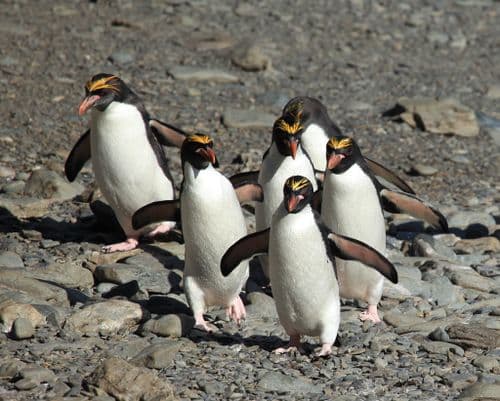
Cooper Bay is a small inlet containing Cooper Island at the very southeast end of South Georgia island. It was first mapped and named by Captain Cook’s 1775 expedition. From this small bay, you will get a commanding view of Cooper Island itself whose 1,300ft summit is always above the snowline, giving some stunning polar vistas even in the height of Antarctic summer.
Cooper Island is heavily protected for wildlife and it is a haven for bird species that love to nest in the tussac grass that covers the island, from the South Georgia Pintail and Pipit, to the Light-mantled Sooty Albatross and the South Georgia Shag. It is also home to four species of penguin, attracting Leopard Seals, and Cooper Island has the largest Chinstrap colony on South Georgia and is one of the more accessible places to see the Macaroni Penguin.
Fur seals and elephant seals also breed and also watch out for black-browed albatross, as well as Antarctic prions and snow petrels hunting for food offshore.
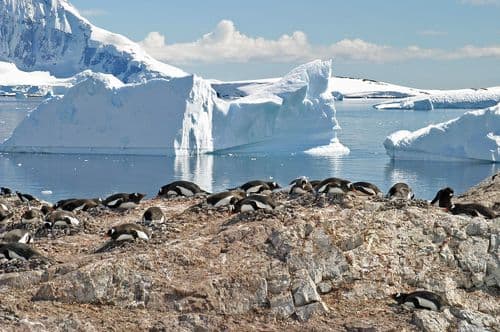
Cuverville Island
This small, steep-sided island is only 1.5 by 1.25 miles and two-thirds of it sits under a permanent ice-cap. On its northern shore is a pebble and boulder beach backed by steep cliffs where you will arrive by zodiac from your Antarctic cruise vessel and come ashore.
At both ends of this beach are the impressive Gentoo penguin colonies that Cuverville is famed for. You will be able to clearly see the trails they use to make their way to and from the water. There are other colonies and nesting sites on the higher ground behind the beach, and throughout the island.
You can also see the evidence of the whaling activity that went on here in the early 1900s, including discarded whale bones and the remains of the equipment used to hall them ashore for processing. If you are lucky, you might see Humpback Whales and Antarctic Minke Whales offshore.
This small island is carefully protected - only one ship at a time may land passengers here and there are other restrictions to ensure the wildlife is not unnecessarily disturbed. Some areas of the island are closed to visitors, but the rest allows you to roam freely, and your expert guides will show you the resident flora and fauna, as well as explaining the island’s whaling history.
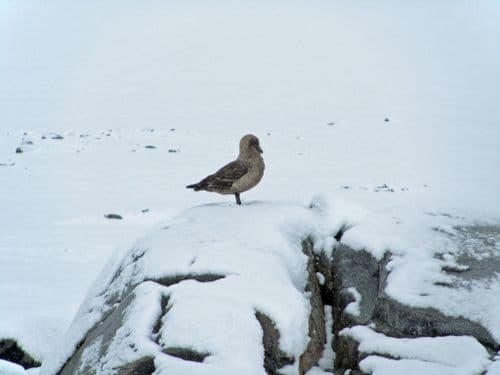
Damoy Point
Damoy Point is a rocky headland on the west coast of Wiencke Island, near the northern entrance to the natural harbor at Port Lockroy. It was discovered and mapped by the French Antarctic expedition of 1903 led by Charcot.
The point is rather unassuming and at first glance doesn’t warrant a visit. However, it has a couple of hidden gems - two very well-preserved expedition huts.
The first, known as Damoy Hut, was built in 1973 and was used by the British Antarctic Survey as a summer air facility and a personnel transfer station, but hasn’t been used since 1993.
The interior is in excellent condition and almost looks as if it could be put back into use straight away. There are even tin cups hanging on the kitchen wall as if ready to give travel-weary scientists a restoring cup of tea!
Just outside Damoy Hut is a refuge built by Argentina in the 1950s. This is not open to visitors and is still in use as an emergency refuge should the need ever arise.
Apart from these historic buildings, visitors will see a small colony of Gentoo penguins who breed here, as well as plenty of seals and sea birds.
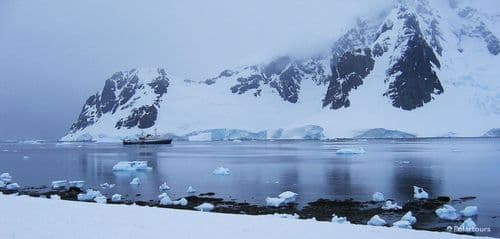
Danco Island, Errera Channel
Danco is a small island in the middle of the Errera Channel, a body of water that runs between Rongé Island and the coast of Graham Land.
Only 1 mile long, Danco’s wide, flat beach rises to a permanently ice-covered hill which gives stunning views over the channel. Visitors often report being able to see Humpback and Minke whales from here as they travel between the islands The view from the top with icebergs in the channel and crevassed glaciers in the surrounding mountains is stunning.
The island hosts around 1500 breeding pairs of gentoo penguins. They like to nest away from the beach up the slopes, and so you can always see them making their journeys to and from the sea, and Danco Island can have some of the best penguin highways in the snow where the Gentoo Penguins climb up and down to the colonies on the higher part of the island.
Seals are also frequent visitors to the island, as are a variety of Antarctic bird species including skuas, terns, and kelp gulls.
Danco was also the site of Base “O”, built by the British Antarctic Survey in 1954 as a base for geological research and exploration. The base was abandoned in 1959 when the expedition ended, and the huts were removed in 2004. On the beach, you can find a plaque with an inscription giving the story of the base.
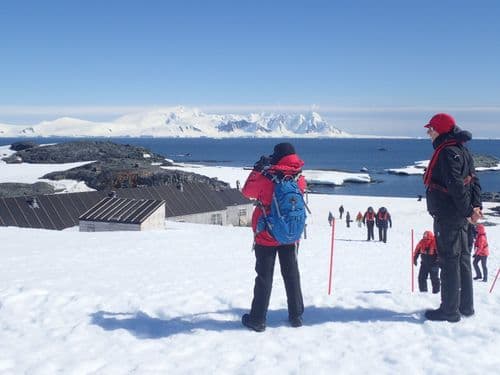
Detaille Island
Detaille Island is a small island in the Lallemand Fjord, part of the Arrowsmith Peninsula in Graham Land. It’s not much more than a rocky outcrop with gravel beaches, but it contains one of the best-preserved historic monuments in the Antarctic.
Detaille was home to “Base W” of the British Antarctic Survey. It was constructed in 1956 and was in use until 1959 when it was closed. Due to bad weather, the supply ship that was sent to take the men and equipment off the island couldn’t get any closer than 30 miles away. This meant that the men had to leave very quickly and with only the personal belongings that they could carry so the ship could depart as quickly as possible.
Because of these circumstances, Base W is almost completely intact. As you look around the hut you will be greeted with the eerie sight of tables still set out with condiments, shelves stacked with tin and jars, and everyday equipment like washing machines, tools, and even and bottles of gin and whisky (empty!). Longjohns and coats are half discarded, with magazines open on the tables, as they were left when the base was abandoned!
Preserved by the United Kingdom Antarctic Heritage Trust, this is a remarkable insight into the early post-war scientific explorations of this amazing continent, and it makes Detaille Island and Base W a “must-visit” on any Antarctic itinerary.
It is also a good location for a Zodiac place with the 'deep south' scenery (it is just south of the Antarctic Circle), the ice, and to look out for seals and Adelie Penguins.
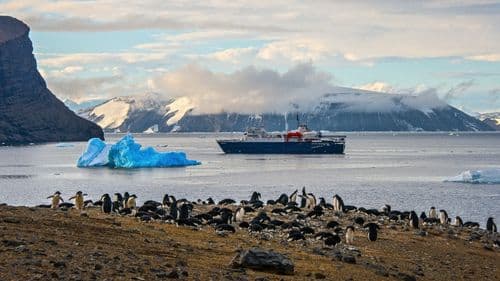
Devil Island, Vega Island
Devil Island is well-named! This narrow, rocky island has a low valley in the middle, with two peaks at either end. This gives it an uncanny “devil’s horns” look! It’s found in the James Ross Island group of the Antarctic Peninsula. Its location in a small cove makes it popular with Antarctic wildlife.
Devil Island gives an opportunity for you to photograph some breathtaking views. From the landing site, you are greeted by some spectacular volcanic formations. From here, you can hike to the top of one of the peaks, which overlooks an Adelie penguin colony nestling below in a natural bowl formation.
But the star of the show here is the remarkable 360-degree viewpoint you get from the top. From the high vantage point, you might spot fur seals, crabeater seals, and a variety of seabirds. It really makes the short, but steep climb worth it. Your expert Antarctic guides will show you the way and point out any wildlife you may have missed.
Devil Island offers some stunning antarctic vistas that you don’t want to miss, so ensure your camera batteries are charged and spare memory cards are ready!
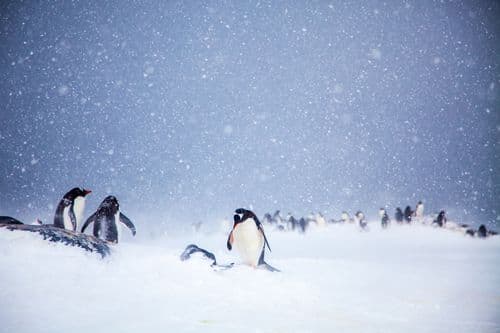
D’Hainaut & Trinity Island
D’Hainaut Island is a tiny rock island in Mikkelsen Harbour. It’s less than half a square mile in size, and it’s approached through a small bay that’s lined with dramatic cliffs of ice. It was first mapped by a French expedition in 1910.
The island often remains snow-covered until very late in the season, and the captain of your Antarctic cruise vessel will expertly navigate through the shallow reefs that are in the bay.
This island was used extensively for whaling, and there are artifacts and bones dotted around the island. D’Hainaut is one of the few Antarctic visitor sites where you can roam freely around the whole island, taking care not to disturb any of the artifacts and watching your step on the rocks, of course.
There is a small historic refuge here that was built originally by the Argentine Navy in the 1950s, then again in the 1970s, and most recently in 2017. However, the refuge can’t be entered except in emergencies.
There is also plenty of evidence of the whaling industry on the island. You can find the wrecks of several boats as well as many whale bones. There is a lively Gentoo penguin colony here, and you can often find Fur Seals basking in the sun.
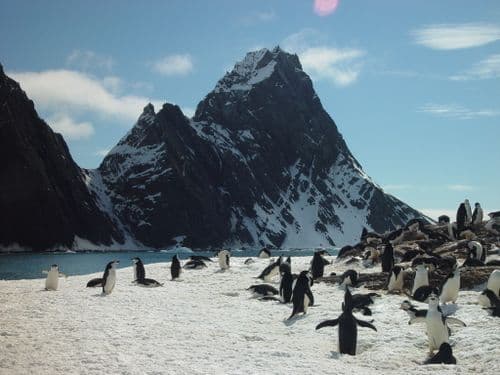
Elephant Island
Elephant Island is one of the outermost of the South Shetland Islands. The roots of its name are argued to be one of two reasons. Either the fact that Elephant seals were seen hauled out here in large numbers by the first person to discover and map the island, Captain George Powell in 1821, or that the island’s shape is uncannily like that of a baby elephant’s head with trunk extended!
The island remained unexplored for many years thanks in part to its lack of resources (just small numbers of seals and penguins and no native plants) and partly because of its steep volcanic rocks, presenting few landing points.
However, in 1916 Elephant Island became immortalized as the scene of the beyond-all-odds survival story that was Ernest Shackleton’s ill-fated Antarctic expedition.
After their ship Endurance was lost to the treacherous ice in the Weddell Sea, the 28 crew were forced to make a perilous escape attempt. After months in open boats and stuck on drifting ice sheets, the team arrived at Elephant Island. Here they set up a base to stay at Point Wild while Shackleton and five members of his crew set sail in an open lifeboat for South Georgia - a journey of over 800 miles - to seek a rescue ship.
This stunning tale of endurance, determination, and the human spirit is brought home to visitors to Elephant Island by the Endurance Memorial at Point Wild. You can also see breathtaking views of the Endurance Glacier - named after Shackleton’s lost ship - as well as the stunning rocky terrain and its Chinstrap Penguins and seals.
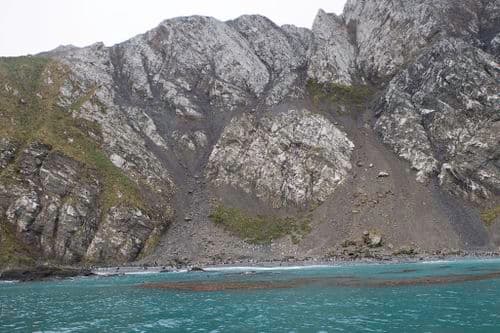
Elsehul Bay
Elsehul Bay at the northwest extremity of South Georgia Island is known for two things - its remarkable numbers of seals, and its remarkable number of names!
At various times, and on various maps, it has been known as Elsehul, Else Cove, Elsie Bay, Elsa Bay, Else’s Hole, and (somewhat bucking the trend) Paddock’s Cove! It’s a small bay on the northern coast of South Georgia and is only half a mile wide.
Despite its small size, it is home to an abundance of wildlife including a large colony of Antarctic fur seals. As you arrive in the bay your ears will be ringing with the barks and cries of huge numbers of juvenile and adult seals.
Adding to the barrage are the cries from the seabirds that call Elsehul home, especially the King Penguins. Others that breed include Gentoo Penguins and Macaroni Penguins, Black-browed albatross, grey-headed and sooty albatrosses, and quite a few other seabirds, such as the South Georgia Shag and White-chinned Petrel. And since they eradicated the rat on South Georgia, it is a good spot for South Georgia Pintail and South Georgia Pipit.
The shore here is a patchwork of tussac grass and mud - so many seals moving around makes for some tricky conditions! Depending on the time of year you visit, the aggressive males may still be in the bay, or, if the mating season is ended, they may have left, leaving the pups and females in peace.
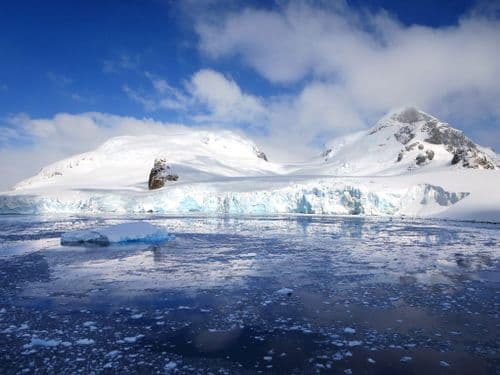
Georges Point, Rongé Island
Rongé Island is high and rocky. Some 5 miles long, it’s the largest of the islands that form the west side of the Errera Channel, off Graham Land.
Georges Point was first mapped in 1897 by the Belgian Antarctic Expedition and named after one of its members.
You land on a rocky beach that looks across to Cuverville Island. There is a penguin colony at one end that your expert Antarctic guides will guide you around, with lots of Gentoo Penguins and Chinstrap Penguins higher up. They will also take you on a carefully marked trail up to the higher ground behind the beach giving you a great view down over the concentrations of penguins along the shore, and the view over the bay towards Cuverville Island and the peninsula.
Later in the season there are also often Antarctic Fur Seals to be found at Georges Point on Rongé Island as well as plenty of sea birds. The rocky cliffs and height of the island make for some magnificent backdrops and great opportunities to capture the essence of the Antarctic in your photographs.
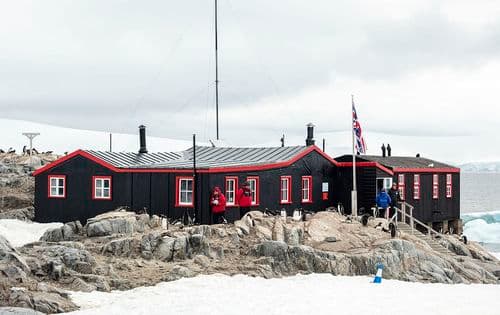
Goudier Island
Goudier Island is a small, low-lying island of bare, polished rock just 100 yards from Jougla Point in Port Lockroy Harbour. It’s part of the larger Wiencke Island. Often surrounded by sea ice, any snow cover on the island usually melts away by the end of the summer.
Goudier is home to “Base A” - established by the British in wartime in 1944 - which was used as a scientific research station until the early 1960s.
After falling into disrepair, the station was restored in the 1990s and is now looked after by a Heritage Trust. The base is permanently occupied, and its inhabitants still conduct important survey work on the penguin colony for the British Antarctic Survey.
You will usually be briefed by the Base Leader before you land ashore, and only 35 visitors are allowed inside the Base at any time. This is to ensure the artifacts and the fabric of the base are preserved.
This “time capsule” gives a fascinating insight into the work and lives of early Antarctic research pioneers and how they lived on Goudier Island. Access to the rest of the island is usually restricted to marked paths, both to protect wildlife and because the surface is uneven and slippery. However, you will be able to observe the resident penguin colony, and can also spot other birds and seals on the shores and in the sea.
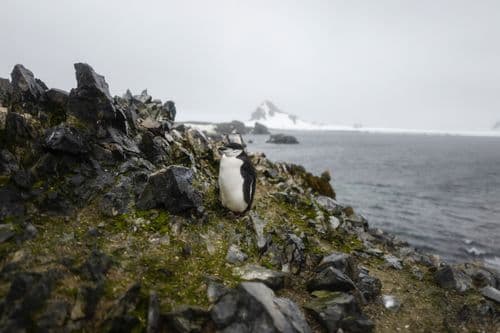
Half Moon Island
Half Moon Island is rugged and rocky and lies just off the Bergas Peninsula in the South Shetland Islands and it is a very popular spot as the either the first or last landing on an Antarctic Peninsula cruise. One side of Half Moon Island has steep, scree-covered slopes and cliffs down to the water, an ideal home to many Antarctic sea birds. The other parts of the island are characterized by pebble and boulder beaches leading to shallower slopes.
Visitor numbers are strictly controlled to ensure that the resident terns, gulls, and penguins aren’t disturbed, especially during their breeding seasons.
Your landing site is a cobbled beach where the remains of a whaling dory (a type of shallow, planked boat) can be seen.
As well as penguin colonies close to the shore, your Antarctic exploration guides will show you the Half Moon Island chinstrap penguin nesting sites near a navigation tower at the top of the hill, as well as the amazing Wilson’s Storm Petrel burrows that have been dug into the scree slopes here. Half Moon has also had a lone Macaroni penguin for a number of years, and others occasionally turn up here.
Your guides will also show you the areas where you can roam freely, always keeping an eye out for Fur Seals whose colors camouflage themselves against the rocks.
Half Moon Island is also home to the Argentinian Summer Antarctic Research Station. You may well spot scientists undertaking important surveys and research work during your visit.
The is also the stunning backdrop of the snow covered and rugged Livingstone Island with the tumbling glaciers.
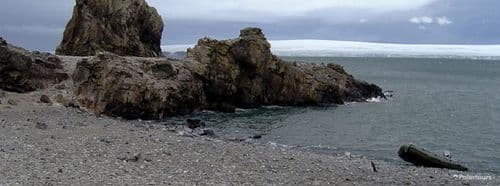
Hannah Point
Hannah Point is a dramatic peninsula on the south coast of Livingston Island in the South Shetlands. Its ridge forms the sides of two bays - Walker Bay and South Bay. The rocks climb steadily upwards to sheer cliffs and knife-edged ridges more than 160ft above the sea level. There are frequent rock falls, and your guides will point out the vein of jasper - a red mineral - that cuts through the cliffs here.
The area was used for hunting by 19th-century sealers, and the British Antarctic Survey has a base camp here known as Station P for the winter of 1957.
The Hannah Point area is rich with antarctic wildlife. Elephant seals haul out and travel to a clifftop wallow pool where they can oversee their domain. Antarctic fur seals are also frequent visitors. Gentoo and Chinstrap Penguins breed here (and a few Macaroni Penguins) and Kelp gulls are almost always wheeling overhead.
Other bird species you will encounter are snowy sheathbills, blue-eyed shags, giant petrels, and skuas. There is sometimes such an abundance of wildlife here that you may have to wait for a suitable gap to open on the beach before you can land!
There s also an elephant seal haul out close to one of the paths and it is important to listen to the guides about the approach and not to disturb the resting seals.
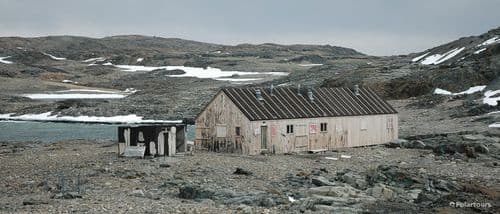
Horseshoe Island
Horseshoe Island is well named. The 3000ft high peaks here are arranged in a crescent shape and were first mapped by air by intrepid British explorers in the 1930s. The island sits in Square Bay, off the coast of Graham Land in Marguerite Bay, well to the south of the Antarctic Circle.
The landing tends to be the northwestern tip of Horshoe Island in Sally Cove. From here, it’s a short walk north to the amazingly preserved hut known as “Base Y” or Horseshoe Station.
This was established in 1955 as a scientific base and was closed permanently in 1960 when personnel were transferred to Stonington Island's Station E nearby. Although unused for over 60 years, Base Y is in a remarkable state of preservation and represents a model example of a fully-equipped exploration and scientific base of the time.
Inside the hut, you will be able to carefully explore by torchlight as you see artifacts from a bygone age. These include the original base generator, tools, light fixtures, tins and packets of original rations, and more items from the daily lives of the scientists who made Horseshoe Island their temporary homes.
Although this time-capsule building is the star of the show, it’s not unusual to encounter seals and skuas on or near to the landing site here.
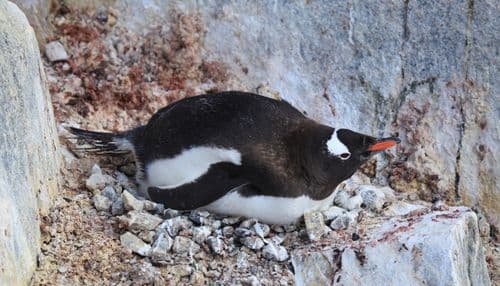
Neko Harbour
Neko Harbour is an inlet deep in Andvord Bay off the coast of Graham Land in the Antarctic Peninsula. It was discovered by a Belgian expedition in the early 1900s. This sheltered inlet was named after The Neko, a Scottish whaling vessel that worked these waters between 1910 and 1925.
Neko Harbor has a beach and a rocky outcrop that is surrounded by glaciers and towering cliffs. This is a popular site with spectacular views as the glaciers that surround this bay regularly carve during the season, leading to some stunning photo and video opportunities if you are lucky!
There used to be a refuge hut here that was built by Argentina in 1949, and was in irregular use all the way until 2009 when it was destroyed in a severe storm. It has since been cleared from the site, with just a few remains now to be seen.
The gentoo penguins that live here and used to surround the refuge hut don’t seem to mind that it has gone! Their noisy cries will greet you as you land on the beach. You can often also see Weddell seals here in the sea or hauled out on the beach at Neko Harbour. There are also skuas and kelp gulls seen regularly here.
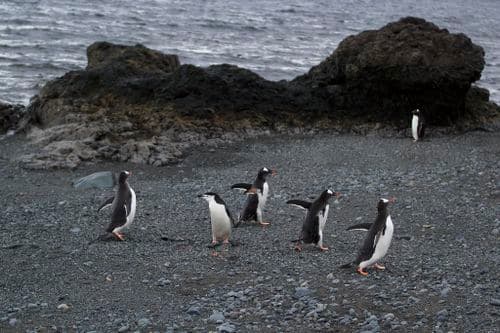
Northeast beach Ardley Island
Ardley Island is a small, rocky island about a mile long. It’s in Maxwell Bay, just off the coast of King George Island. It was first charted in 1935 by a British expedition but was mistaken for a headland. It was not until aerial surveys many years later that it was reclassified as an island.
Ardley Island is an active summer research station, and you will often see scientists and researchers at work here. The huts that you can see from the beach are part of the research station and not able to be visited.
The landing on the beach is just below the lighthouse, a distinctive feature that you will have spotted from out to sea. This gently sloping cobble beach is the only place that visitors can arrive on Ardley.
Visitor numbers are restricted due to the importance of the island as a breeding site for antarctic bird species.
During your excursion on the island, you will see a large gentoo penguin colony, as well as lesser numbers of Adelie and chinstrap penguins. You can also see southern giant petrels, Wilson's petrels, black-bellied storm petrels, Cape petrels, skuas, and Antarctic terns. The northeast beach of Ardley Island is a “must-visit” site for bird watchers!
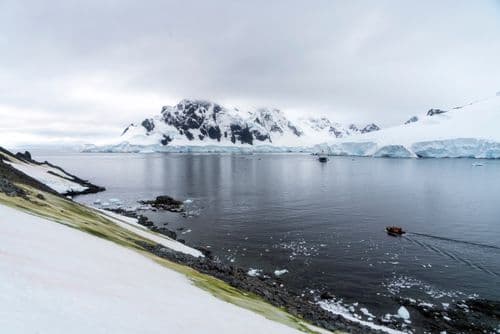
Orne Harbour
Orne Harbour is a mile-wide cove on the west coast of Graham Land, just southwest of Cape Anna. It was first discovered by a Belgian Antarctic survey of the Danco coast in 1898 and was then in regular use by whaling vessels in the early 1900s.
The site is popular for two reasons. Firstly, it’s a beautiful location that provides stunning Antarctic views. The exposed rocky shoreline contrasts with the permanent snow patches dotted on the higher ground above it. To the south, there is deep permanent snow and ice. Glaciers ring the harbor and steep peaks rise above. It’s glorious for a Zodiac cruise!
The other reason to visit Orne Harbour is to see the nesting colony of chinstrap penguins that have made their homes here. There’s a steep but safe hike up from the beach to the colony that sits on higher ground above the beach. As well as the penguins, you will be rewarded with remarkable views of the bay, and the glacier that regularly calves into the waters here.
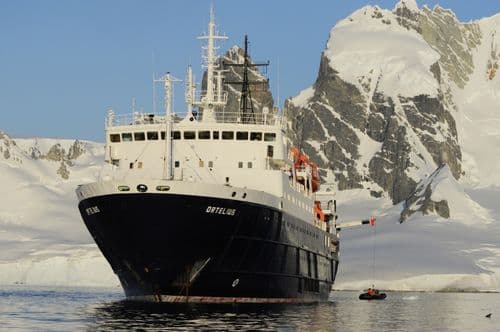
Orne Islands
The Orne Islands are a cluster of small, low-lying rocky islands at the entrance to the Errera Channel and Orne Harbour. They lie just off the northern coast of Ronge Island off Graham Land.
The largest Orne island has moderate slopes leading to a rocky central ridge that has permanent snowbanks. There are also three other small islets that make up the group.
Your landing will be via a low rock platform on the northwest side of the main island. Once ashore, you can roam freely around the island under the supervision of your expert guides. The Orne Islands are home to Skuas, which nest in the rocky outcrops here, as well as other Antarctic seabirds and penguins.
In winter, impressive snow cliffs can form near the landing site. To avoid disturbing the wildlife, the number of visitors on the island is restricted, and during nesting seasons your guides may limit the areas in which you can roam to protect nests.
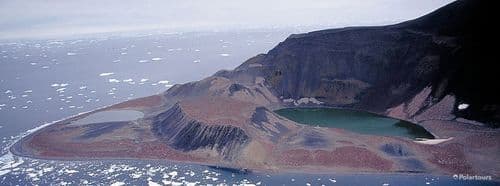
Paulet Island
Paulet Island is a striking sight. This circular rock is only 1 mile in diameter, yet it has a volcanic cone that rises to over 1100 feet at its center. It’s found about 3 miles from Dundee Island at the northern end of the Antarctic Peninsula.
First mapped in 1839, Paulet Island is home to a huge penguin colony. Some 100,000 breeding pairs of Adelie penguins live here, a truly remarkable sight and sound! You will also see other sea birds on your visit, including shags, snow petrels, and kelp gulls.
Another fascinating aspect of Paulet Island is the historic shelter that dates back to 1903. The expedition ship on the Nordenskjöld expedition - the Antarctica (after which the Antarctic Sound is named) - was crushed by the ice pack, and survivors of the wreck reached Paulet built a stone hut to shelter them from the harsh winter conditions. There is also a cairn built on the highest point of the island that they used to attract attention for any rescue. There is also a grave marker for one expedition member who sadly did not survive.
Because Paulet Island is so densely packed with wildlife, visitors will be escorted in small groups by experienced Antarctic guides. This ensures that the breeding birds are disturbed as little as possible and that the shelter site is protected.
Fur seals are often also seen on the shores here. In the peak breeding season, you may find that some of the walking trails around the island are closed due to the sheer numbers of wonderful creatures that choose to raise their young here.
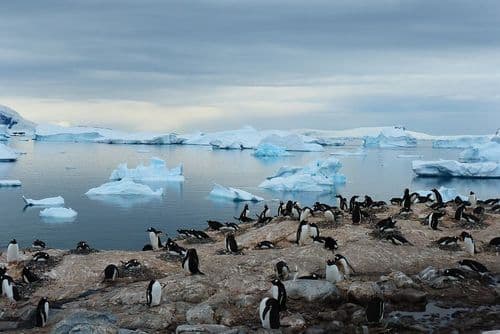
Penguin Island
Penguin Island was first recorded in 1820 during a British expedition. It was so-named because of the vast numbers of penguins that could be seen along its shoreline from the ship as it passed by.
Penguin Island lies just off the south coast of the much bigger King George Island. It’s ice-free and is oval-shaped, some 1 mile long. It’s one of the smaller South Shetland Islands and it’s also known as Georges Island, Île Pingouin, Isla Pingüino, and Penguin Isle in various books and charts.
Its standout geological feature is the 560ft tall Deacon Peak - a volcanic cone that is thought to have last been active about 300 years ago.
Penguin Island is an internationally-recognized important area for birds. As well as colonies of Adelie and Chinstrap penguins, the island is also home to large breeding colonies of southern giant petrels, Antarctic terns, and kelp gulls.
You can often see Weddell seals and sometimes southern elephant seals on the beaches here, too.
For those feeling fit, there is a marked path that will take you up to the top of Deacon Peak. This offers unparalleled views over the whole island and beyond across King George Bay. Do note, however, that this part of the Antarctic is known for its quickly changing weather, so if the opportunity to take this walk safely presents itself, take it!
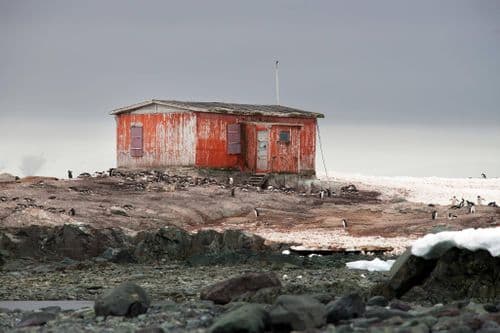
Petermann Island
Petermann Island marks the extremes for two Antarctic species - not bad for a small rock less than a mile long!
This rocky outcrop that rises 500ft above the sea has a permanent covering of ice. The island is just south of Booth Island in the Lemaire Channel. Petermann Island is volcanic in origin, and it has a permanent icecap covering more than half of its surface. It’s home to the northernmost colony of Adelie penguins, but also the southernmost colony of Gentoo penguins. The latter are taking over (and pushing further souht) and soon there may be no breeding Adelie Penguins on Petermann Island.
First mapped by a French expedition in 1909, Petermann Island is also home to breeding colonies of skuas and Wilson’s storm petrels. There’s also a good chance to observe Weddell, crabeater, and fur seals.
Visitors can hike up to the highest point of the island, where a cross and cairn remembers three members of the British Antarctic Survey who died in 1982 attempting to cross the sea ice from Petermann Island to Vernadsky station. There is also a refuge hut built by an Argentinian expedition in 1955 - its red metal walls make a fantastic contrast against the snow and ice.
The area can be superb for Zodiac cruises, especially around the larger icebergs grounded on the far side of the island, and Humpback Whales often appear in the main channel.
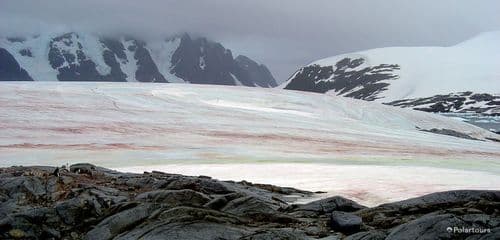
Pleneau Island
Pleneau Island is one of the less-visited Antarctic visitor sites but is well worth it. First mapped in 1903 by the French Charcot expedition, it’s a beautiful location that overlooks what’s known as an “iceberg graveyard”, with a Zodiac cruise often favoured over a landing (see fascinating facts). Whether viewed from the island itself or from a Zodiac, there are always stunning ‘bergs to photograph here.
The island itself is less than a mile long and lies just off Hovgaard Island in the Wilhelm Archipelago. Pleneau is home to terns, and your expert Antarctic guides will make sure that you avoid disturbing them in the breeding season.
The permanent ice cap at the top of the island looks stunning, but it’s riddled with crevasses and not safe to walk on.
The northern end of the island hosts a breeding colony of Antarctic Shags, and you will almost certainly see penguins and seals among the stunning icebergs.
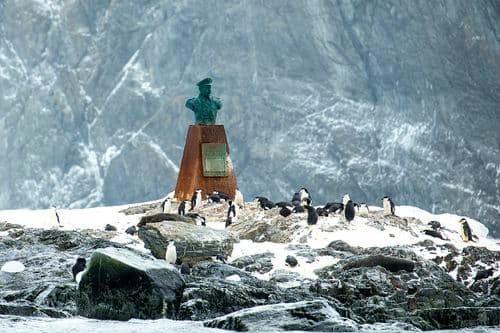
Point Wild is an unassuming, narrow sand and rock point, with steep tidewater glaciers and cliffs on its edges. It lies on the north coast of Elephant Island (part of the South Shetland Islands) 7 miles west of Cape Valentine.
Despite its lack of grandeur, this small bit of land has a starring role in history - it was named after Frank Wild, the leader of the survivors of Sir Ernest Shackleton's shipwrecked expedition. 15 men camped here and managed to survive for four months of Antarctic winter before they were rescued by a Chilean naval ship in August 1916.
There is a memorial commemorating the captain of the rescuing vessel with an impressive bronze bust to be found here, as well as several inscriptions. You will often find members of a colony of chinstrap penguins “guarding” the monolith!
The waters around Point Wild are famous for “snagging” icebergs on their hidden underwater rocks, and there is always a chance to witness the nearby glacier carving into the waters. Due to the sea conditions, landing is not always possible here, but Zodiac cruise or a close passage by the ship will let you marvel at the isolation and inhospitable conditions that Shackleton’s team endured. You can also admire the amazing glaciers and stunning geology of the area around the point.
It is also the site of a Chinstrap Penguin colony and the surrounding waters can be great for whales and seabirds like the Black-browed Albatross.
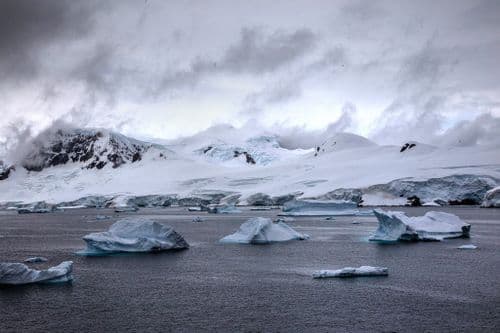
Portal Point
Portal Point is a narrow, rocky point on the northeast of the Reclus Peninsula off Graham Land. It was named by British explorers as it formed part of the “gateway” for the route to the Antarctic Plateau.
In 1956, a refuge hut was established here, known as Cape Reclus Refuge. It was only used for two winters and then abandoned. In 1996, the hut was removed and is now in the Falklands Island Museum.
All that’s left of the refuge on the Point are the remains of its foundations, often not visible under the frequent snow cover. Indeed, this year-round snow is why there are no penguin colonies here.
However, Portal Point is a popular place for Weddell seals to haul out, and while you are landing you will often see them in good numbers. There is also a small Antarctic Shag colony nearby and the bat is great for Zodiac cruises amongst the icebergs, to enjoy the views of the peninsula, glaciers tumbling down to the bay, look up to the polar plateau, Leopard Seals on ice floes, and the chance to see Humpback Whales.
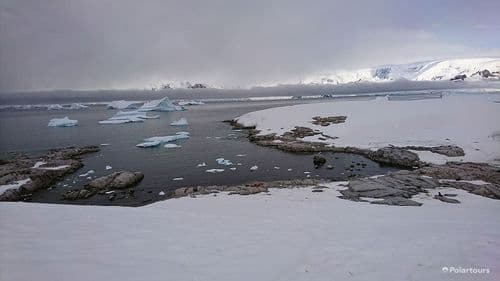
Port Charcot, Booth Island
Port Charcot is a small bay at the north end of Booth Island. Booth Island is a rocky and rugged Y-shaped island off the Kiev Peninsula in Graham Land. It was first mapped in 1904 when the French Antarctic expedition led by Jean-Baptise Charcot over-wintered here.
After building a few rudimentary shelters and the cairn that can still be seen at the top of the hill, the expedition used Port Charcot as its base for exploring the area, that is close to the Lemaire Channel and the division between the NW and the SW peninsula . There is the remains of a stone hut used for astronomical observations and a wooden pillar with a plaque here where you can still make out the names of the first expedition members who wrote them almost 120 years ago.
In the bay where the Français was anchored (but difficult to reach with the ice) the letter 'F' was carved onto the rocks and can still be seen.
The walk to the cairn is delightful, although you’ll be carefully led by guides as wandering off the path can be treacherous, with loose rocks and crevasses. Visitors can also walk to the east where there is a noisy Gentoo penguin colony. Chinstraps and Adelies can also be seen on the beaches here. If you are lucky, you might get all three together!
From the top the views are stunning, especially the view to the SW, towards Pléneau Island Island, overlooking 'the iceberg graveyard'. This iceberg graveyard can be explored on a spectacular Zodiac cruise, either from ships anchored off Port Charcot to the 'NW' of the Lemaire Channel, or from ships anchored off Pléneau Island and Booth Island that had sailed through through the Lemaire Channel. For full details of this Zodiac cruise refer to the details under Pléneau Island.
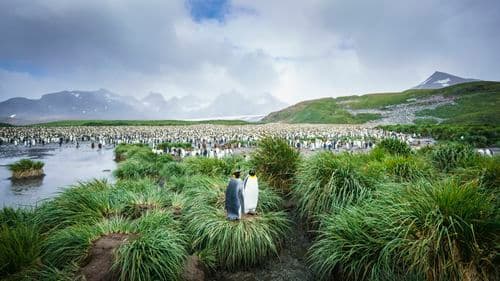
Salisbury Plain
Salisbury Plain (known as Llanura de Salisbury in Spanish) is a large coastal flat plain leading to the Bay of Isles, off the northern coast of South Georgia.
Although this area of the coast of South Georgia was discovered by Captain James Cook in the 1770s, there were no detailed maps made of the region until a British Admiralty survey of the 1930s. A chart produced in 1931 is the first time this area was named, and it’s likely to be named after the “original” Salisbury Plain, a grassy, chalk plateau in southern England used for military training and home to Stonehenge.
The Salisbury Plain in South Georgia was formed by the glacial runoff from the nearby Grace Glacier. This glacier was named by American ornithologist Robert Cushman Murphy for his wife during his expedition of 1912.
Salisbury Plain is world-famous for its remarkable king penguin breeding colony. In 1912, Cushman estimated there were 350 pairs here. Now one of the world’s largest gathering of king penguins, official estimates are as high as 100,000 breeding pairs nesting here in peak season. Seeing the Plain filled with these regal birds is one of the highlights of any trip to South Georgia and to the sub-Antarctic.
Not to be outdone by the king penguins, southern elephant seals and Antarctic fur seals also use Salisbury Plain to raise their young and can also be seen in good numbers.
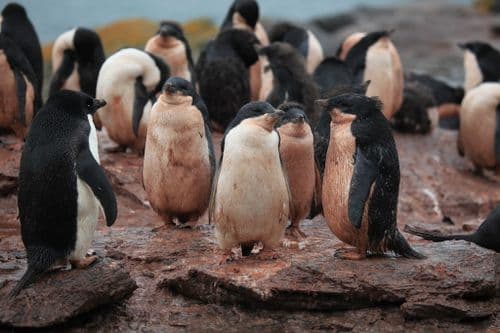
Shingle Cove
This small sheltered cove is found on the southern shore of Coronation Island, in Iceberg Bay. Shingle Cove is notable for both its fascinating geology and its large colony of Adelie Penguins.
Two gravel beaches allow for an easy landing and give access to the higher ground beyond. From the beach, you can see outcrops of metamorphic schist, with visible layers of quartz and feldspar. Your expert Antarctic guides will also show you areas of Shingle Cove where other mineral deposits have eroded to the surface, including red garnet and green amphibole.
To either side of your landing site, petrels will be seen flying to and from their rocky burrows in the low cliffs. You’ll also be unable to miss the noise from the impressive Adelie Penguin colony here - over 13,000 strong!
Although you can wander freely on the landing beach, your walk to the penguin colony will be carefully marked and must be followed under supervision. This is to protect petrel burrows which are easily disturbed.
Only groups of 20 visitors at a time are allowed into the colony to avoid too much disturbance, but this is an excellent opportunity to walk into the heart of the Shingle Cove penguin colony with all its sounds, sights, and smells!
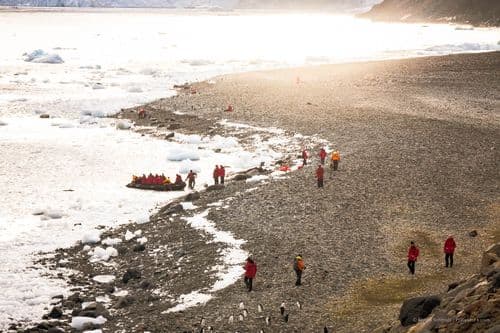
South Georgia and Scotia Sea
South Georgia Island (known as Isla San Pedro in Spanish) is often described, quite rightly, as a highlight of many peoples’ Antarctic cruise experience.
The remote, rocky main island is 850 miles from the Falkland Islands and the same distance from the Antarctic Peninsula. It’s quite mountainous, with a central high ridge and plenty of bays and fjords on its coast, making for some stunning views and remarkable photographs.
There are 8 smaller islands (the South Sandwich Islands) located 400 miles to the southeast which are rarely visited.
South Georgia has a human history mainly centered around the sealing and whaling industries, with relics such as try pots and sunken whaling ships to be discovered. Many people also pay a visit to the grave of Ernest Shackleton, one of the most famous Antarctic explorers, who died unexpectedly of a heart attack while in South Georgia.
Part of one of the world’s largest marine reserves, the variety of the wildlife to be found in South Georgia is what attracts most of its visitors. From the world’s largest king penguin colonies to beaches crammed with elephant and fur seals, to breeding colonies of the bird with the largest wingspan in the world, the wandering albatross, to innumerable species of seabirds, South Georgia is a destination that serves up “days of a lifetime” every day!
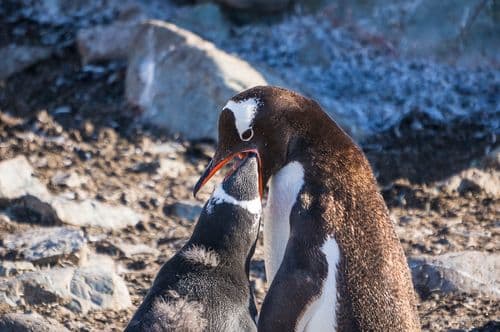
The South Shetland Islands are a group of rocky islands only about 75 miles north of the Antarctic Peninsula.
Several countries have research stations on the islands, with most being found on the largest island, King George Island. It’s here, at the Chilean Base Presidente Eduardo Frei Montalva, that there is a 4000ft runway that sees over 200 flights a year bringing people and supplies to and from the Islands and wider Antarctica.
Most of the islands are covered in ice for much of the year, but they are still home to large populations of Elephant and fur seals, as well as huge numbers of penguins and Antarctic sea birds, being the most diverse area in the whole 'peninsula' region. Frequent encounters here include gentoo, chinstrap (often one of the key species for landings in the South Shetlands), a few Adélie penguins colonies, and the odd Macaroni penguin pair or lone bird. Also Weddell, crabeater, and leopard seals, as well as and orca, humpback, and minke whales, with fin whales, and even southern bottlenose Whales, see on the approach close to the drop off to deeper waters.
Black-browed Albatross do not breed but can be seen, usually offshore in the Southern ocean, but also in the Bransfield Strait.
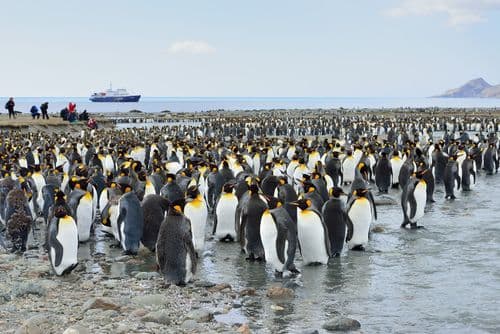
St. Andrew's Bay
Saint Andrews Bay (more usually abbreviated to St Andrews) is a bay on the eastern shore of South Georgia, part of the British Terriroty of South Georgia and South Sandwich Islands.
This 2-mile wide bay is overlooked by Mount Skittle, an impressive 1,600ft rocky mountain that forms the northernmost point of the bay itself.
The use of Saint Andrews as the name for the bay can only be traced back to the early 20th century, but it’s highly likely that the first people to sight and map it were the British expedition led by Captain Cook in 1775.
St. Andrews Bay is renowned for its huge breeding colony of king penguins, thought to be over 150,000 strong. The sights and sounds of so many birds together is not to be missed in one of the most spectacular locations in South Georgia with the mountains as backdrop!
There is also a ridge (if you are able to reach it, sometimes there are too many moulting penguins in the way) that looks down over the main colony with breath taking views, and sounds!
Fur seals and southern elephant seals are also frequently seen here, both in the water and hauled up on the shores, and fur seals can make it quite a challenge getting ashore. The rugged, rocky backdrop to the bay makes for some stunning photographs, and really evokes the remoteness of South Georgia.
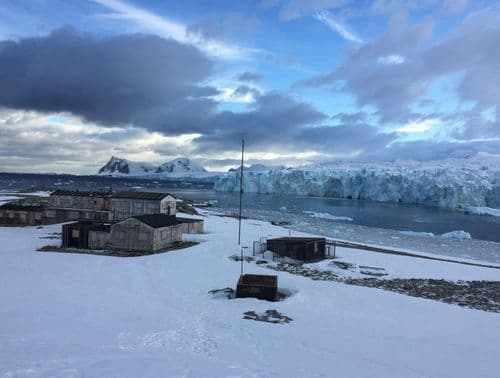
Stonington Island
For such a tiny, rock island (it’s less than half a mile by a quarter of a mile), Stonington holds a lot of the human history of Antarctica. It’s found in Marguerite Bay off the west of Graham Land, and it is one of the most southerly historic sites on the peninsula.
It was home to not one, but two winter expeditions. In 1939, the US Antarctic Service chose it as the location to build what became known as East Base. The buildings and artifacts here are now protected as a monument. Visitors can enter the main hut to experience something of what it would have been like to spend the dark and frozen winters on Stonington.
Later in the 1940s, the British chose the same small island for the location of their “Base E”. Again, visitors can enter the main hut and also the generator shed. Like the American base, there are other ancillary buildings that can’t be entered due to their status as protected monuments. There are permanent shutters on the windows of Base E, so your guide should provide you with torches if you venture inside.
In a solemn reminder of the harshness of the continent, there is also a gravesite where two expedition members are buried in coffins covered by simple stone cairns.
Stonington Island supports a colony of over 130 pairs of Antarctic Shags, as well as nesting sites for skuas and terns. As well as the landing there is a good Zodiac cruise around the island with the head of the nearby glaciers coming down from the polar plateau and to look out for seals and Adelie Penguins on the ice floes.
Later in the season fur seals and Humpback Whales can turn up at this southerly destination.
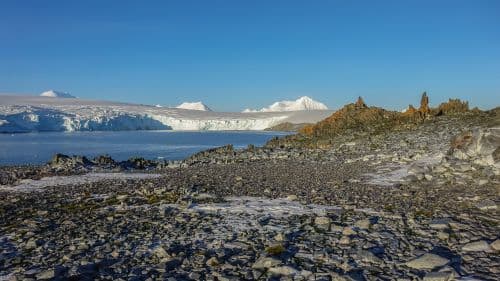
Torgersen Island
Torgersen Island is a very small, circular island only 450yds across. It’s part of the Palmer Archipelago and is at the entrance to Arthur Harbour on the southwest coast of Anvers Island.
It’s a popular site for breeding seabirds and Adelie penguins, but this small rock has a much larger, and more depressing, importance.
Although the current colony size of 3,000 breeding pairs seems large, since 1974 the Adelie population has reduced by over 60% due to the impact of climate change on the sea ice and snowfall patterns. An Adelie colony that was based on the neighboring Litchfield Island has disappeared completely in this time. Archeological surveys showed that penguins had been nesting there for over 600 years continuously, with up to 15,000 pairs in residence at a time. By 2007 they had all gone.
The island is very close to the American Palmer Station and it is divided into a Visitor Zone and a Restricted Zone. The Visitor Zone is for general access, whilst the Restricted Zone serves as a control site for scientific research related to human impacts. The Restricted Zone should not be entered, except in an emergency to access the emergency cache located on slopes opposite the landing site. Use the cache only in a genuine emergency and notify Palmer Station if anything is used.
Your expert Antarctic guides will show you the walking routes to take that will minimize any impact to the Adelie colony on Torgersen Island, as well as outlining the concerns that Antarctic scientists have about the continuing impact of climate change on the region’s wildlife.
This is a timely reminder of the necessity for change in the way humans live and use fossil fuels if we are to preserve the unique species and landscapes of the Antarctic. At Polartours we are playing our part in this story by carbon offsetting every polar cruise package we sell.
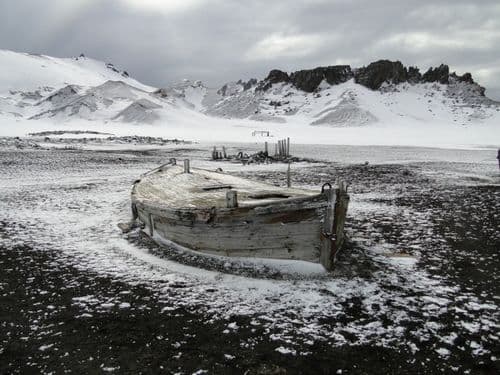
Whalers Bay
A very popular destination, Whalers Bay is a small natural harbor on Deception Island, one of the South Shetland Islands. An active volcano, the crater forms a natural sheltered inlet that was historically used by sealers and then whalers from the 1820s. The geography makes it a perfect place for ships to shelter in rough weather, and Whaler’s Bay contains some of the most significant whaling artifacts and remains to be found in the whole of Antarctica.
As your ship sails through the narrow “break” in the volcanic caldera known as Neptune's Bellows, the wide, circular beach of Whaler’s Bay is found to the right. The beach runs uninterrupted for one and a quarter miles and was used as a runway in the 1950s and 1960s when the site was the main hub of British Antarctic air movements. The hangar that was built in 1960 can be visited at the northern end of the beach where you can also see a roller that was used to maintain the runway.
At the southern end of the beach are large, rusted oil tanks, and behind them are buildings from the period 1906 to 1931. There was a significant whaling industry here, with the sheltered and shallow beach making it an ideal place to land whale carcasses and process them.
While you explore all this remarkable human history, please remember that you are standing on an active volcano! The instruments you may see around the beach in the Whalers Bay area are seismic monitors, and the island is monitored for activity 24 hours a day. The last eruption was in 1969, and this was responsible for some of the mudflows and damage to the buildings and metal tanks that you see here. It creates a very eerie derelict industrial landscape, in Antarctica, even bleaker with the black volcanic cinder.
No penguins breed, but small numbers of Gentoo and Chinstrap Penguins turn up on the beach and they can be surprisingly inquisitive. Later in the season you might encounter fur seals who have hauled out to rest and watch the humans. Other birds to look out for include Cape Petrels, giant petrels, skuas, Antarctic terns, and Kelp Gulls, that take the chance to feed on the krill and other prey stunned in the hot waters.
Guests often take the polar plunge here with the warmer layer of water with the heat from the steaming volcanic sands. There is also the walk up to the viewpoint at Neptune's window.
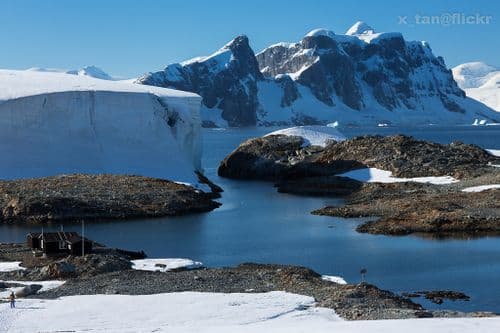
Wordie House, Winter Island
Nestled onto the only flat part of Winter Island, Wordie House is a hut built in 1947. It was named by a British Antarctic expedition of the time after James Wordie, who was the chief scientist on Shackleton’s famous 1914 Antarctic exploration. Winter Island is less than 1,000 yards long and is one of the Argentine Islands off the coast of Graham Land.
Before it closed in 1954, the hut was used to take meteorological readings using instruments stored inside special screens, one of which still stands today. These readings were among the most important and longest set of weather data ever recorded about the Antarctic and helped scientists gain a greater understanding of the meteorology of the continent.
Wordie House was made a “Historic Site and Monument” in 1995 and has been looked after by the UK Antarctic Heritage Trust since 2009. There are almost 500 original artifacts still on the site, including original cans of coffee, records, pots and pans, plates, and many more £everyday” items. This makes Wordie House a true time capsule from the golden age of Antarctic exploration and scientific research. The hut is now fully weathertight, and work continues on preserving this unique station.
Close to Wordie House there used to be the British Faraday base, the place where researcher's discovered the expanding Ozone hole. When the base was going to close, rather than dismantling this important and historic base (and one of the best bars in Antarctica!), it was given to the Ukraine for one pound!
Visits to Winter Island and Wordie House are managed by the nearby Ukrainian station Vernadsky, and you may well be briefed by the Base Commander or other official before you board your boats for the landing. The visit to Wordie House is often in conjunction with a visit to the base, and the chance to have a vodka and the impressive wooden bar.
The short Zodiac cruise between the two locations passes through some interesting gullies and the chance to check out seals and penguins on small ice floes.
Uniquely for such a historic site, visitors are allowed to roam freely under the supervision of their expert Antarctic guides. They will answer all your questions about the history of the hut, as well as the artifacts that you can find here.
Visitors to Winter Island can also expect to see seabirds such as skuas and kelp gulls, as well as seals and penguins. Humpback Whales are often seen in the more open waters close to the anchorage.
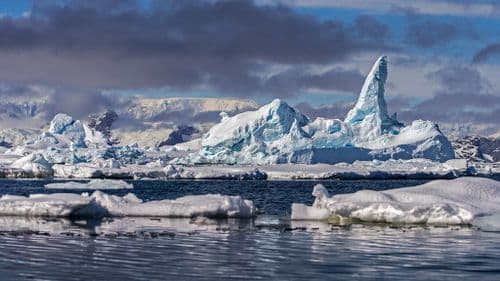
Yalour Islands
The Yalour Islands (also sometimes called Jalour Islands) are a 1.5-mile long group of small islands and protruding rocks off Cape Tuxen in Graham Land. The islands were discovered and named in 1903 by the French Antarctic expedition led by Charcot.
Most of the Yalour Islands are steep-sided or unsuitable for landing due to sea conditions, but the largest island has some cobbled beaches where you can put ashore.
Visitors come here to make the short climb up from the beach to the Adelie penguin breeding colonies. There are thought to be around 8,000 breeding pairs of Adelies in the Yalour Islands, and they have nested on every bit of rock they can find that’s not snow-covered. It makes for an amazing sight as you come in to land on the beach!
Photographic opportunities here are excellent. The high mountains of the Antarctic Peninsula form a stunning backdrop to shots of the Adelie nest sites. Your expert guides will lead you around, showing you the best sites, and answering all your questions about the penguins and their lives.
As Adelie Penguins have decreased in numbers just to the north at locations like the Petermann Islands, the Yalour Islands have become a popular location to see this species. Even if it is a challenge to get ashore with the swell, or, the snow banks earlier in the season, the colonies are easily observed from a Zodiac. The area can be a good spot for seals, and for Humpback Whales offshore.
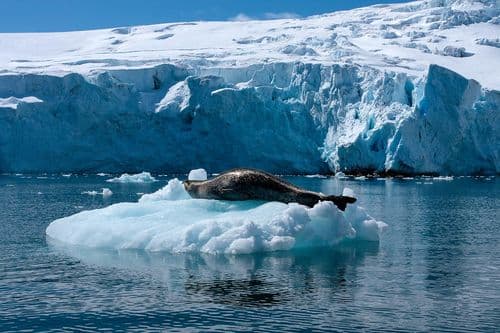
Yankee Harbour
This wonderful natural harbor is surrounded by glaciers. It’s an almost perfect safe anchor for ships, which is why it was used by sealers for many years. You enter Yankee Harbour via Shopski Cove, which is between Spit Point and Glacier Bluff on Greenwich Island. You can also look across McFarlane Strait towards Half Moon Island and glaciers and the snow cap across the peaks of Livingstone Island, one the most spectacular islands in the South Shetlands.
Yankee Harbour was used by both American and British sealers from the 1820s onwards. The British called it Hospital Cove. There’s a commemorative plaque here that celebrates Captain Andrew MacFarlane who explored much of the Antarctic Peninsula in 1820.
The other great attraction here is the large Gentoo penguin colony, with over 4,000 breeding pairs making Yankee Harbor their home.
The landing beach here is terraced, and there is a melt-pool from the glacier on the eastern end. Depending on the conditions and breeding status of the penguins, some longer walks in the area are possible along the curved gravel spit.
As well as the penguins, skuas often nest here - their feathers camouflaging them against the rocky ground. Your guides will make sure you don’t step on any accidentally!
Our trips to spot the Leopard Seal
2024 Polartours, a Ventura TRAVEL GmbH brand
All rights reserved
Privacy | Imprint

Your contact
+1 347-493-2978
Book a video consultation
15min face to face consultation
First Name *
Last Name *
Your message *
I have read and agree to the privacy policy .*

- Seal Safari
- Coastal Tours
- Groups & Schools
- Captains Page
- Local Interest
Seal Safari - Tour 1
One of the largest colony/group of Common Seals in the UK, possibly the world, is in the Wash. This area has a large expanse of shallow tidal sandbanks and is fed by four large tributaries. There are currently over 3,000 common seals in The Wash.
The Seal Safari Tour starts from the promenade where Wizzy The Wash Monster takes you across The Wash out to one of the sandbanks that are used by the resident population of common seals. Remember your cameras!
Please click below for Safari Tour Dates & Times
Seal safari 2024, 1 hour seal safari - £20.00.
New Guidelines: Pre-Booking Required. We will require all names of group along with address and contact telephone numbers. Group discounts available, please enquire. Board from the Sea Tours Kiosk, Central Promenade, Hunstanton.
Please call 01485 534 444 to check Safari Tour times.
Did you know? Abilities:
Seals travel on land at between 3 and 4mph and can reach 30 to 40mph when swimming submerged! Seals can hunt at night, using their sensitive whiskers to find prey, and will normally spend much of the daytime hauled up on the sandbanks sleeping.
Seals have very good vision in both air and water and have a keen sense of smell in air which allows them to detect predators. Seals hear very well in both air and water. Females and pups often call to each other.
Seals are opportunistic feeders. Diving to around 120 metres or sometimes even 300 metres deep, their diet consists mainly of fish such as sand eels, herring, saithe, whiting as well as bottom dwelling fish like plaice and flounder. Squid and octopus are also frequently eaten.
UK seals breed in colonies where animals congregate on beaches, sandflats and in caves. Common Seals give birth to their pups on beaches and tidal sandflats within tidal reach, between May to July. Conception to birth takes around 11 months. Common seal pups are dark and mottled and can swim within 5 minutes of being born.
Myths and Legends of a Selkie:
Traditional belief holds that it is unlucky to kill seals as they are children of the King of Lochlann from Norway, under a spell. Their jealous stepmother being jealous of their great beauty, spent seven years and seven days perfecting the Black Art, where she changed the King’s children into seals, so they could be neither beast nor fish for evermore. Furthermore, she cursed them that while at sea, they would always long for land and whilst on land they would always long for the sea, for as long as waves beat on shore. But they were also compelled to very briefly regain human form thrice yearly.
Stories tell of a man walking along the shore, who came upon a lonely cove where a number of seals were casting aside their furry coats to bathe as humans. Entranced by the splendid beauty of these creatures, he picked up one of the radiant skins and carried it home.
The enchanted owner seeing him with her shimmering skin was obliged to follow him to recover her former skin but this was nowhere to be seen so she settled for the human clothes the man gave her and agreed to marry him. Her intoxicating beauty spellbound him and for many years she lived as his wife, bearing their children, but her ‘sea-longing’ never relented.
One day, one of her children came across her beautiful hidden skin and brought it to their mother. She immediately threw it over her, transforming her back to her former self and dived deep into the sea, and they were never to see her again, except for the nights when their mothers song called her children to come to her and swim through the waves alongside her.
Searles Sea Tours, Central Promenade, Hunstanton, PE36 5BH
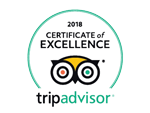
FINLAND – An extraordinary rich wildlife, a safe and clean country with unique nature
Situated in the boreal coniferous forest zone, finland is surrounded by the baltic sea, sweden, norway and russia. the northernmost part of the country lies above the arctic circle, whereas the southern area of the landscape is dominated by an archipelago of 179,000 islands, which is the largest archipelago in the world. between those extremes, finland is characterized by vast forests and 188,000 lakes, which give the country the yet underestimating name of “the land of the thousand lakes”., hunting and fishing in finland – experience fair chase hunting and fishing in one of the most unique and beautiful countries in the world, you can legally hunt or fish nearly 100 different game and fish species. most of the game species are native and some are introduced. most common introduced game species are whitetail deer, raccoon dog, american mink and north american beaver., all hunting in finland is truly free range, either on public or private land. there are no fences and even if there were, hunting would still be illegal inside them., contact – who we are and contact details.
Owner of Wildmark Ltd and outfitter Esa Nykänen is a dedicated person with a family of five (a wife who is a keen hunter as well, two daughters and a son). Wildlife, hunting and fishing is more than just wildlife, hunting and fishing. It’s a passion and a lifestyle. This has always been and will probably always be the case. He has gained experience as an outfitter from late 90’s and has a proven track record of hunting and fishing in Finland and all around the world.
He has hunted on all continents, including most of Europe’s ungulates, many of Africa’s plains game and a variety of gamebirds in both continents. He has hunted big game, birds and predators in South and North America. Hunting Oceanic deer, sheep, goat and macropods is also familiar to him. He has also fished in all of the main seas, this includes the Atlantic Ocean, Indian Ocean, Pacific Ocean and in a lot of smaller seas like the Mediterranean, Red Sea and Caribbean.
Esa has successfully hunted and fished most of the Finnish game and fish species and a phenomenal number of well over 200 different species all over the world. Read more >>
Seal Hunting
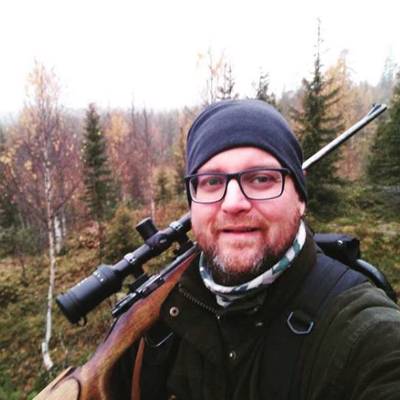
Hunting experience
Accomodation and hospitality
Professional hunters / staff
Game quality
Value for money
More about us
Our company was established in 2016 and operates in 1 territory.
- I have been professional fisherman for 20 years and I have also been a hunter for 25 years.
- We offer hunting and fishing trips to individuals, families, and small groups (max. 12 persons). We provide everything you need to make your trip a great experience. Our crew provides years of experience that is valuable in helping to make each fishing outing relaxing and successful.
About this hunt
Hunting season begins 16th of April and ends approximately by the end of May. Hunting takes place in the gulf of Botnia bay. Lots of shot opportunities and fresh sea air is guaranteed. We have all the necessary equipment for this special kind of hunting. The yacht can accommodate up to 12 people and will take place after the arrival of 4 people. As motherboards, M / B Ark and M / B Jenny, divided into groups of 4 to 6 people by number of participants. You can arrive by car, by train (Vihanti), or to Oulu Airport, we will arrange pick-up if needed. If weather conditions are not allowing hunting, we can substitute this with fishing.
Guided ( Difficult trip ) Rifle Hunting Stalking
Hunting season: 20 Apr 2024 - 15 May 2024
Where you will hunt
Hunting takes place in the gulf of Botnia bay.
Fence type: Not fenced
Territory size: 10 000 ha
Languages spoken by staff: English
Operating since: 2010 year
Fields/Bush: 100%
Where you will stay
Fishing lodge / on board.
Usually accommodation is in fishing lodges. Though the ice floes are constantly moving according to winds and currents, so the arrival timetable can vary considerably. It is also possible that your horses are far away from the port of departure, so a night might be spent on board and sleeping in turns. The cabin is warm but still sleeps with a sleeping bag for staying in the boat. Sleeping in 2-3 person turns. Also at night there are watch lifts running on the boat. In addition, there is an alternative place to sleep on the island of Iso-Kraasel, in the pilgrimage of the Tiai kala fish hut.
Facilities: Sauna
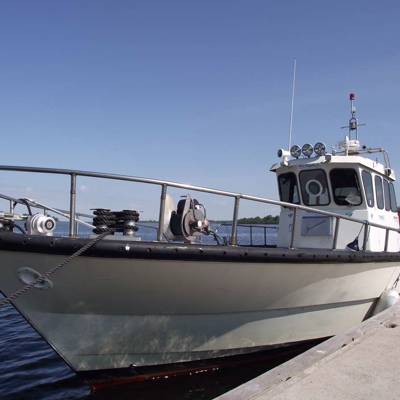
How to get there
We can arrange transfers from Oulu airport, Vihanti railway station, or you can come by car.
Nearest airport: Oulu
Distance from airport: 80 km
Transfer from airport: Yes
Distance from railway: 40 km
Transfer from railway: Yes
Other information
Gun rental: No
Vaccination required: No
Price Includes
Accommodation.
- Transport on territory
- Guiding by PH
- Beverages/soft drinks
- Fishing gear: Raila (fleece), waistcoat, dry suits, horseshoes, floats, snow coats
- Services of a bounty hunter, chef, doorman and ship skipper
- 1 Grey seal trophy fee
Cancellation
- Deposit is non-refundable.
Price DOES NOT include
- Leather processing service: 110 € + Matkahuolto cargo about 25 €.
- Scraping and washing: a big bucket: 120 € and a small bucket 80 €
- Hunting license - 75 euro, foreign customer hunting fee - 15 euro
- Alcoholic drinks
- Gun rental & ammunition
- Transfer from/to airport or railway station - 50 euro/person
- Finnish taxes 10%
- Taxidermy - can be made by us on client's request.
Final payment
Reviews (2), incredible adventure.
I loved every minute of this hunt. The unique transportation across the ice, the accommodations, the hunt itself! I am the only person I know, aside from my guide, who has ever done anything like this! I was looking for a once-in-a-lifetime experience, and I got everything I wanted and more! It's a tough, exhilarating hunt, but worth every minute, and every penny!
Good hunting experience
Everything that depends on the organizer was very good and professional!
Weather. But - it’s on God’s hand...
{{ item.reviewHeadline || (item.huntingExperience + ' hunting experience') }}
Select dates of your trip, choose your party size, price breakdown, trip on the map.
Interested in this hunt? Create a subscription to get offers with the same destination and species
{{ onboarding.text }}
Share this hunt with friends
{{ $ctrl.data.title }}, join for free, to receive special offers and discounts.

COMMENTS
The price of a grey seal hunt starts from about $1,000 a hunter a day. Typically, outfitters take out a small group of hunters at once. The price includes the use of a yacht, motorboats, and other equipment necessary for the hunt. The hunt can be combined with fishing, and in fact fishing is often the outfitters' Plan B if the weather is ...
2 hunting trips from 2 outfitters starting from $ 913 . 2 hunts $ 913 starting from. 2 countries. 4195 mi to the nearest trip. Map. Countries. ... Seal Hunting Package. Sweden Seal . Trip duration: 4 days. Season: 20 Apr 2024 - 30 Jun 2024. Package price $ 3,492. for 4 days, 1 hunter . Seal Hunting ...
The experience:You are out at sea, great chance for hunting in the pack ice (mostly in the spring until around the end of June). The hunt can also take place in the fjord or far out on the coast. Hunting season:16 October - 31 March and 01 June - 30 July. Meeting point. Augo Lyngesvej B1428, 3920 Qaqortoq - https://maps.app.goo.gl ...
Browse a selection of seal guided trips. Hunts directly from outfitters with a Best Price Guarantee. ... Looking for the best hunting trips... We show you Resident Hunts Please note that right now we display hunts available only for citizens of the following countries: {{userResidentCountry}}. ...
Harp seals are the victims of the largest slaughter of marine mammals in the world: the Canadian seal hunt. This slaughter has taken the lives of over 2 million seal pups in the past decade. Seals are an important part of the marine ecosystem. This seal hunt is another example of DFO mismanagement of the ocean ecosystems. Learn about the cruel, ecologically irresponsible, and totally ...
71° North - A Greenland Hunting Adventure. Muskox and Caribou hunting in Greenland. We conduct hunts in our two huge and most unique hunting destinations in very scenic areas with a very high density of full grown Trophy bulls. These prehistoric Muskoxen are up to 900 pounds in body size - more than 20 % heavier than from other areas.
One day last mid-April, three of us - two hunters and myself, a visiting photographer - boated up the fjord to Qertaulangiuaq. There, in heavy fog, we hunted from icebergs and fast ice. The air was so thick with ice, it was hard to tell the sea from the sky. Gert, our "seal whisperer" clucked and mewed, and scraped his gaff against the ...
The growing interest in seal research and watching led to the establishment of the Icelandic Seal Centre back in 2006, which is located just on the Vatnsnes peninsula in a quaint fishing town called Hvammstangi. Almost 40,000 people visited the centre in 2016, and over 10,000 explored its exhibits. As of January 2017, the Centre is looking to ...
No. While the harp seal population in the Northwest Atlantic is the world's largest; it is a migratory population that spans the distance between Canada and Greenland and is supposed to number in the many millions. In the 1950s and '60s, over-hunting reduced the harp seal population by as much as two-thirds.
North Seal River Lodge. The North Seal River lodge experience is designed to be luxurious and exclusive. Gangler's accommodates a maximum of 26 guests per trip. The main lodge is the epitome of the classic remote Northern lodge, offering the full flavor of the North with its motif and decor.
TROPHY HUNTING IN NORTHERN GREENLAND. From the Disko Bay area towards the north of Greenland, trophy hunting is done in a few places. However, the populations of animals are limited, providing for a real pioneering experience, especially around the area of Lersletten (Naternaq) by the small town of Qasigiannguit in the innermost part of the bay.
With more than 1,500 happy customers ready to provide a reference, DIAMOND OUTFITTERS, has grown to become the largest full-time guide service in North America. We have hunting packages for every budget. Fully guided hunts will include guide, lodging, meals, private property access fees, field transportation, ranch trespass fees, USFS or BLM ...
You can expect to get chances on shooting seals on every session, even though it's demanding shooting, we often manage to bag 1-2 seals per session in the boat. Success rate is at 100% for the package. Hunting period is 20 april - 30 june. Guided (Easy trip) Rifle Hunting. Hunting season: 20 Apr 2024 - 30 Jun 2024 Success rate. 100%
The only way to get one is to hunt one. Hunting season: Apr 16th - Dec 31th. Best season: All season. Hunting: Stalking and seeking by boat. Weapon: Rifle >222, bow or shotgun with slug. Target specie: Grey seal (Halichoerus grypus) Price: For the best prices contact wildmark. Grey seal is truly the great predator of the Baltic Sea.The seal ...
The leopard seal has a rightfully fierce reputation! This is the second-largest Antarctic seal and the most renowned underwater hunter in the polar region. With a muscular 3.3m (11ft) long body weighing up to 590kg (1,300lb) and massive, oversize jaws with inch-long canine teeth, the leopard seal is a top predator.
Seals Guide Service, Hornbeak, Tennessee. 2,081 likes. Jackson Seals guiding services on Reefloot Lake. This years duck season starts December 2nd & ends January 31st. Book some days & lets kill some...
1 hour Seal Safari - £20.00. New Guidelines: Pre-Booking Required. We will require all names of group along with address and contact telephone numbers. Group discounts available, please enquire. Board from the Sea Tours Kiosk, Central Promenade, Hunstanton. Please call 01485 534 444 to check Safari Tour times.
Seal Hunting. Finland. Price from. $911 for 1 day, 1 hunter, with Grey seal included. Jouni, PH. 9.2. I have been professional fisherman for 20 years and I have also been a hunter for 25 years. We offer hunting and fishing trips to individuals, families, and small groups (max. 12 persons).
You can legally hunt or fish nearly 100 different game and fish species. Most of the game species are native and some are introduced. Most common introduced game species are whitetail deer, raccoon dog, American mink and North American beaver.All hunting in Finland is truly free range, either on public or private land. There are no fences and even if there were, hunting would still be illegal ...
FINLAND - An extraordinary rich wildlife, a safe and clean country with unique natureSituated in the boreal coniferous forest zone, Finland is surrounded by the Baltic Sea, Sweden, Norway and Russia. The northernmost part of the country lies above the Arctic Circle, whereas the southern area of the landscape is dominated by an archipelago of 179,000 islands, which is the largest archipelago ...
For hunting Svalbard reindeer and seals, only rifles and hunting ammunition with expanding projectiles shall be used. For ammunition with a bullet weight of between 9 and 10 grams, the impact energy must be at least 2700 Joules (275 kg/m) at a range of 100 metres. For ammunition with a bullet weight of 10 grams or more, the impact energy must ...
Big-game hunts in Finland are typically priced between 1,000 and 1,500 Euro a hunter a day, with a representative trophy included (exceptionally large trophies may call for a bit of an extra payment). Small game hunts, including seals, are somewhat cheaper, at 800 - 1,000 Euro a day. This usually includes accommodation in a wilderness lodge ...
Seal Hunting. Finland. Price from. $919 for 1 day, 1 hunter, with Grey seal included. Jouni, PH Finland. 8.3. I have been professional fisherman for 20 years and I have also been a hunter for 25 years. We offer hunting and fishing trips to individuals, families, and small groups (max. 12 persons).